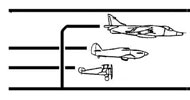A day by day diary of the Sopwith Aviation Company and its products through 1919
Summary of Sopwith’s status on 1st January 1919
Sopwith has now built 2,891 aircraft in Kingston upon Thames since 1912. To help meet the total demand, 26 other UK contractors have manufactured a further 9,231 Sopwith designed aircraft bringing the total UK build Sopwith machines to 12,122, over 20% of the aircraft built so far for the British armed forces against wartime orders. To the above figures should be added at least 4,200 Sopwith ‘Strutters’ and ‘Strutter Bombers’ built by French contractors for the French armed forces in 1917 and 1918.
Despite some cancellations since war end there are still orders outstanding on all contractors for another 6,700 Sopwith designed machines although many of these may yet be cancelled as it becomes clearer just how many machines are needed to maintain the RAF’s capability during the negotiation of the permanent Peace Treaty and beyond. Sopwith have orders for 705 of those 6,700 to keep them going for some months whilst they work on new military prototype orders, develop a range of civil aircraft and prepare much of the Canbury Park Road factory for the production of ABC motorcycles.
Diary for 1919
On 1st January, the pilot who had two victories last October in 203 Sqdn ‘Camel’ D9597 is injured crashing it on landing whilst 210 Sqdn ‘Camel’ F3941 makes a forced landing and 87 Sqdn ‘Dolphin’ F7062 crashes taking-off on a practice flight.
On 2nd January, 65 Sqdn ‘Camel’ E7217 crashes onto its nose in a cross-wind take-off, 209 Sqdn ‘Camel’ F3742 overturns forced landing with a failed engine, 201 Sqdn ‘Camel’ C195 is badly damaged overturning on landing whilst 43 Sqn ‘Snipe’ E8206 is wrecked crashing on landing from a practice flight at Bickersdorf.
On 3rd January, the pilot of 210 Sqdn ‘Camel’ F6246 is injured in a crash. At home E6138 is one of the first ‘Snipe’ to arrive with 61 Home Defence Sqdn at Rochford to replace their ‘Camels’. ‘Dolphin’ D5268 crashes on route to Farnborough where ‘Dolphin’ C4191 is currently involved in slipstream experiments. They are also experimenting with a Rotherham ‘windmill’ fuel pump on ‘Snipe’ E8044 for comparison with its standard Badin venturi system. The aircraft is tethered to the ground in flying attitude to assess performance of the cabane strut mounted pump purely from propeller backwash. (below)
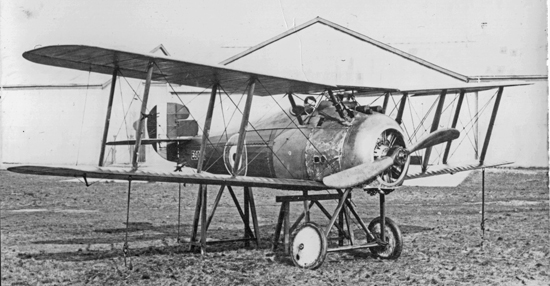
On 3rd January, the Sopwith Board Meeting formally seals the agreement with ABC Motors to take a licence to manufacture and sell ABC motorcycles and schedules an Annual General Meeting to amend the objects in the Memorandum of Association to enable the company “to manufacture sell and repair motor cars motor cycles motor vehicles and conveyances of all kinds” and to change the Sopwith Aviation Co Ltd name to Sopwith Aviation and Engineering Co Ltd. The Board also recognises the role played by General Manager Reginald Cary since the incorporation of the company by formally appointing him Managing Director backdated to 1st October, increasing his salary plus commission of ten percent of the 1918/19 financial year profits. Messrs H Musgrave (Secretary and Organising Manager), L Fowler (Assistant Organising Manager), A Fenn (ex Paris Office Manager now Sales Manager) and H Mitchell (Works Manager) get a salary increase with commissions ranging from 2½% to ½% of ¾ of the total company profits for the 1918/19 financial year.
Fred Sigrist (now Engineering Manager) gets a salary 50% above that of Harry Hawker (Pilot) and Herbert Smith (Designer) and these three are to get 2½%, 1½% and 1% commission respectively from 1st January 1919 based not on overall company profits but on sales income from complete aeroplanes, a big incentive to focus on developing successful post-war designs. They are already working on a trans-Atlantic prize contender, a fast sporting two-seater and an enclosed cabin two passenger civil aircraft.
Work on the Snark and Snapper high altitude fighter and twin-engined Cobham bomber prototypes has taken a back seat in the experimental shop due to the ABC Dragonfly engine problems although they have just now received a Dragonfly engine for each of the fighters and a pair of alternative straight 6 cylinder water-cooled Siddeley-Deasy Puma engines for the Cobham. With no prospect of production orders, work on the third Bulldog prototype has stopped completely.
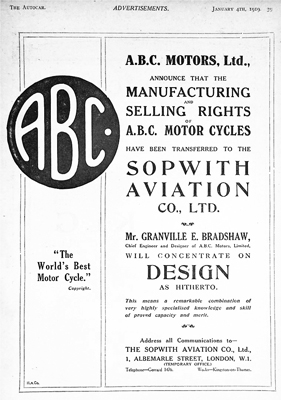
The very next day, 4th January, ABC Motors of Hersham announce in Autocar (above) that ABC motor cycles are to be manufactured and sold by Sopwith Aviation emphasising that Granville Bradshaw remains in charge of design. “This means a remarkable combination of very highly specialised knowledge and skill of proven capacity and merit”.
At Marquise a ‘Camel’ (wrongly recorded as D1867) crashes from 200ft on a test flight after an engine failure killing the pilot and a mechanic on the ground. At home the pilot delivering ‘Snipe’ E6149 is fatally injured flying into the ground in fog whilst ‘Long-range Snipe’ E8214 & E8222 are allotted to 86th Wing and are to perform a speed demonstration flight to Cologne.
On 5th January, 221 Sqdn DH9 and DH9a bombers with their ‘Camel’ escorts arrive at the eastern Black Sea port of Batum to be taken by train to the port of Petrovsk on the Caspian Sea in support of White Russian forces.
On 6th January, 73 Sqdn ‘Camel’ D6462 short of fuel hits telegraph wires and overturns, 204 Sqdn ‘Camel’ F8501 crashes hitting a small bank on landing whilst two 45 Sqdn ‘Camels’ D9392 and E7204 are wrecked crashing on landing, the latter on soft ground.
For the RAF squadrons still based abroad it has been a boring time since the Armistice, standing firm until there is an ensured peace but with very little flying. It is all very different to the daily pressures of war. As an example, 45 Sqdn at Izel Le Hameau have sometimes had no flying for a week or two. On one occasion, concern about the lack of activity led to the ground crew being sent on a route march whilst the officers do a cross country run all followed by a parade and a football match. At least there is plenty of time for group photographs. C Flight pilots pose within their all-important ground crew and their ‘Camels’.
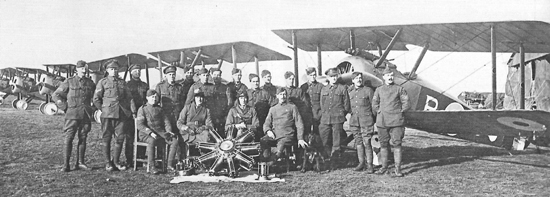
On 7th January, 65 Sqdn ‘Camel’ F1925 crashes onto its nose caught by the wind on take-off, 73 Sqdn ‘Camel’ D1958 and 203 Sqdn ‘Camel’ E1536 both overturn landing in the strong gusty wind whilst 59 Sqdn ‘Camel’ F1883 is rain damaged in a hangar. At Bickendorf 70 Sqdn ‘Camel’ H7012 crashes forced landing with an engine failure, 43 Sqdn ‘Snipe’ E8041 also crashes with an engine failure and 4 Sqdn AFC ‘Snipe’ E8088 is wrecked overturning after landing heavily on one wheel. (below)
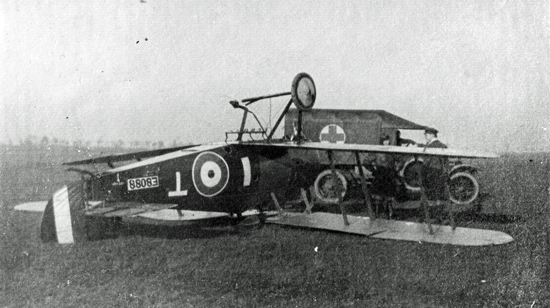
The same day, Sopwith receive a first formal notice of reduction of their aircraft orders by 148 ‘Snipe’, 100 Dragon and 20 Salamander reducing their total outstanding orders for these Ham factory assembled types to 850.
On 8th January, 152 Sqdn ‘Camel’ H6847 crashes landing in a high wind.
Following vibration problems with the 200hp V8 Sunbeam Arab engines in service in the Blackburn-built Sopwith ‘Cuckoos’, work is in hand on the alterations needed to install the Hispano-Suiza derived, balanced crankshaft, 200hp Wolseley Viper engines. The most significant alteration is a revised radiator installation.
The 8th January, issue of Aeroplane is packed with aviation industry advertisements some companies simply reminding readers they exist but many now able to proclaim achievements through the war and others suggesting new ways forward. Sopwith take a two page spread naming their “world-famous” types which with “numerous other types were used extensively by the Allies on all Fronts and by the Allied Navies”. They declare that “the majority of fighting scouts used in the war were of the Sopwith design” and “Sopwith machines were the first to bomb Germany”.
Meanwhile the drawing Office have just issued general arrangement drawing D.3056 for an unarmed two-seat dual-control ‘Snipe Trainer’ apparently using a standard single-seat ‘Snipe’ airframe (right) and production ‘Dragon’ drawing D2907 with the exposed cylinder heads of the ABC Dragonfly radial engine.
On 9th January, a 65 Sqdn ‘Camel’ pilot is injured in a crash.
On 10th January, 3 Sqdn ‘Camel’ F6138 crashes on landing. At home the pilot of Lopcombe Corner ‘Camel’ H2688 is killed spinning-in off a flat turn at 50ft whilst at Leighterton ‘Pup’ D4191 strikes trees in a forced landing with an engine failure and at Bicester there is a propeller accident with ‘Pup’ B6128. ‘Pup’ C431 moves from the Artillery & Infantry Co-operation School at Worthy Down to 43 Training Depot Station at Chattis Hill whilst Major Barker’s VC winning ‘Snipe’ E8102 is allotted to the Canadian Government after being exhibited at Burlington House.
As the Ministry of Munitions now becomes Ministry of Supply, Churchill moves to the War Office as Secretary of State for War and the Air Ministry leaving others to sort out, amongst other things, his promises to the local councils that the Ham factory would be temporary and the huge volumes of surplus stock. In the case of aviation, not just surplus aircraft and engines but 10 million yards of Irish linen, thousands of tons of wood and stocks of all the other equipment and commodities that the Ministry of Munitions have been buying in bulk for issue to aircraft manufacturers.
On 11th January, the pilot of 213 Sqdn ‘Camel’ B7233 is injured crashing on a practice flight as is the pilot of newly night-flying equipped ‘Camel’ F6388 crashing on take-off from 3 AAP at Norwich. ‘Camel’ H7343 with the self-sealing fuel tank arrives at Martlesham Heath for tests in conjunction with a Badin fuel system. ‘Dolphin’ D5232 converted to a ‘Dolphin III’ at Farnborough repair depot is now at Ternhill and photographed with a three man team swinging the now ungeared propeller to start the engine (below).
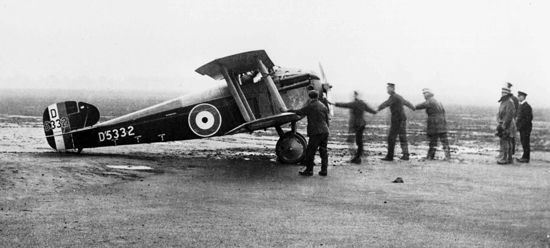
On 12th January, ‘Snipe’ E7349 is wrecked on arrival at 6 AIS swinging on landing and collapsing the undercarriage whilst 221 Sqdn DH9s and DH9s bombers with their ‘Camel’ escorts arrive by train at the port of Petrovsk on the Caspian Sea in support of White Russian forces. In the atrocious sub-zero gales and snow assembling them behind wind screens in the open is abandoned after a test flight by the first DH9.
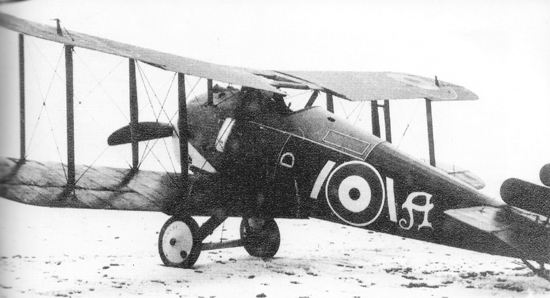
On 13th January, pilot of 19 Sdn ‘Dolphin’ F7056 is killed at Genech hitting a hangar and nose diving-in. At Bickendorf 43 Sqdn ‘Snipe’ E8279 (above) already with some unusual extra lower fuselage white markings has been taken over by a Canadian pilot who has had ‘Canada’ marked on the wheel covers as it is designated to move on to a RCAF Sqdn by the end of the month. At home the pilot of ‘Camel’ D1815 is killed at Beaulieu stalling off the top of a low roll and spinning-in whilst both pilots of Home Defence ‘Pups’ B1763 and B1805 are killed in a mid-air collision and Eastbourne ‘Camel’ F2028 crashes out of control after the pilot “hits the rudder pedal”.
On 14th January, 213 Sqdn ‘Camel’ D3331 is wrecked catching a telegraph pole after an engine failure on take-off.
On 15th January, Hooper have their outstanding orders for 180 ‘Dolphins’ reduced to 139 whilst Darracq’s outstanding orders for 105 have been reduced to 70. With the 300 reduction of Sopwith’s outstanding orders last November, there will now be 1774 ‘Dolphins’ built compared with the 2154 ordered.
Salamanders are beginning to flow in numbers from Sopwith’s leased Ham factory and more photographs including these two (below) showing the armour plate steel box forming the fuselage between the Bentley BR2 rotary engine and the conventional wood and fabric rear fuselage.
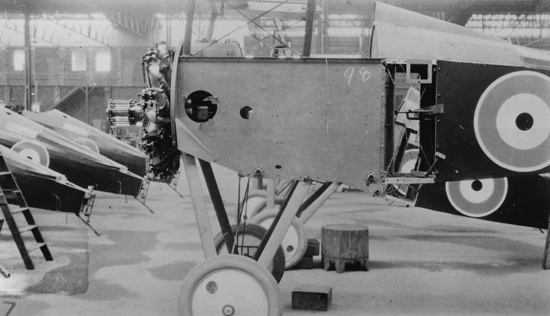
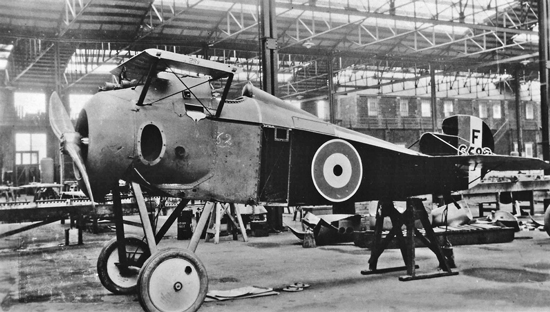
On 16th January, in France 87 Sqdn ‘Dolphin’ D3775 with its wing mounted guns is damaged in a crash landing.
On 17th January, surplus 210 Sqdn ‘Camel’ F3124 forced lands en route to the Aircraft Supply Depot at Marquise whilst 204 Sqdn ‘Camel’ F3100 is wrecked overshooting landing with an engine failure as is 208 Sqdn ‘Snipe’ E8042 returning from a practice flight.
On 18th January, in France ‘Camel’ E4394 overturns on landing after a wheel comes away. At home the pilot of Marske Fighting School ‘Camel’ F4010 is killed stalling and spinning-in on landing and the pilot of Leuchars Grand Fleet School of Aerial Fighting & Gunnery ‘Camel’ D8234 is injured also stalling and spinning-in.
By 19th January, with Armistice terms largely being observed and a Peace Conference finally starting in Paris, the first phase of demobilisation is under way with 49 fully operational RAF squadrons in France to be dispensed with at an average rate of one per day. Fifteen 87 Sqdn ‘Dolphins’ fly home to England after being on the front line since late April 1918 whilst with ‘F1 Camels’ declared obsolete, sixteen 45 Sqdn Clerget-engined ‘Camels’ are flown to Liettres where Demobilisation Units are to reduce them to produce. 45Sqdn ground crew of 135 NCOs and other ranks now dispose of portable hangars, tents, tools, motor transport and other equipment before most return to England to be released from service. Some of the pilots are getting temporary assignments in France but should soon be following them home. Since October 1916 45 Sqdn has claimed a remarkable 316 victories in France and Italy initially with Sopwith ‘Strutters’ and then ‘Camels’. In the process 74 men have died, 60 of them in the ‘Strutter’ era, 8 more have died in flying accidents, 23 have been wounded and 12 taken prisoner.
On 20th January, 209 Sqdn ‘Camel’ F3111 crashes on take-off at the aerial ranges at Berck-sur-Mer and 213 Sqdn ‘Camel’ F3944 crashes onto its nose landing in mud whilst 208 Sqdn ‘Snipe’ E8066 lands too fast in fog at Stree and runs into E8162 wrecking both machines and E7343 crashes on landing but is repairable.
On 21st January, the pilot of 65 Sqdn ‘Camel’ E1591 is killed failing to pull out of a dive on a ground target, 204 Sqdn ‘Camel’ F4990 is wrecked on landing overshooting and is to be burnt on station whilst at Bickendorf ‘Snipe’ E8101 is wrecked overturning on landing after a wheel comes off. At home the pilot of Suttons Farm ‘Camel’ F1912 is seriously injured hitting a tree descending in fog.
At Hendon three presentation aircraft are formally handed over to the Canadian High Commissioner including ‘Long-range Snipe’ E8213 (below) presented by the City of Leicester.
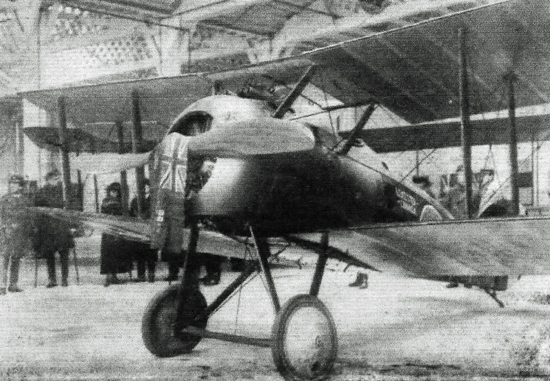
On 22nd January, 208 Sqdn ‘Snipe’ E8051 is wrecked crashing on take-off. At home the pilot of Martlesham Heath ‘Camel’ C1588 is killed side-slipping-in after a port wing cracked in level flight at 450ft whilst Weston-on-the-Green ‘Camel’ F9608 is wrecked stalling-in when the engine fails after a spin. The pilot of Hooton Park ‘Pup’ D4109 is injured also stalling after an engine failure.
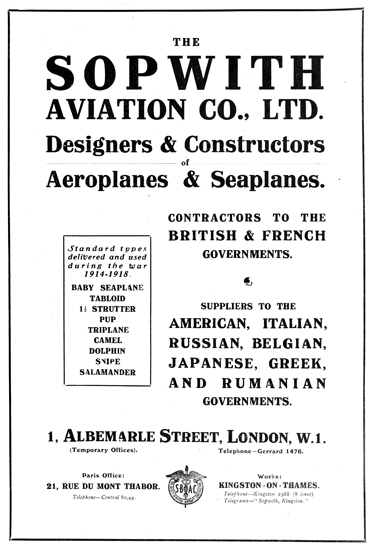
This latest Sopwith advertisement in Aeroplane states that aircraft have been supplied not just to British and French governments but also to America, Italy, Russia, Belgium, Japan, Greece and Rumania. This could be slightly misleading as apart from some very small pre-war orders the majority of Sopwith designed aircraft used by these nations have been diverted from orders on Sopwith contractors or passed on from RFC, RNAS, or RAF service. Over 200 British built ‘Strutters’ and large numbers of French built ones have gone to Russia whilst they built some themselves so it is still their most numerous type in use by both White and Red Armies. At least 17 UK built ‘Strutters’ have gone to Rumania, 17 have gone to Japan who also had French built ones and built 18 under licence whilst 22 have gone to Belgium who also used French ones, bought 6 ‘Pups’ and have had at least 54 ‘Camels’. 20 ‘Baby’ floatplanes have gone to Japan and the Americans had some in France before getting two squadrons of UK built ‘Camels’ and large numbers of French built ‘Strutters’. After initially purchasing pusher floatplanes from Sopwith the Greek Navy have been working with the RNAS (now RAF) in the Aegean throughout the war and have inherited 4 ‘Pups’ and at least 17 ‘Camels’ (like this one at Stavros below) plus a similar number of ‘Hamble Baby’ floatplanes.
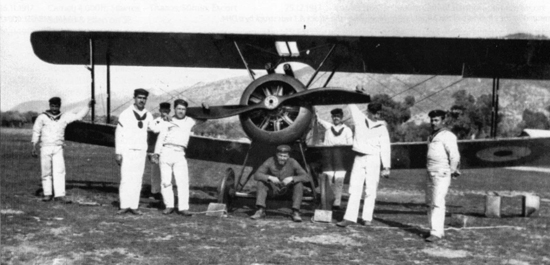
On 23rd January, 201 Sqdn ‘Camel’ C191 forced lands en route to be reduced to produce at a Demobilisation Unit in France as does 65 Sqdn ‘Camel’ B5585 with a failed engine and that pilot is slightly injured. At home 7 ‘T1 Cuckoo’ torpedo bombers including N6926 have arrived at the Southern Repair Depot Farnborough for conversion to ‘Cuckoo Mk IIs’ by fitting 200hp Viper engines.
On 24th January, at Bickendorf both pilots of 70 Sqdn ‘Camels’ E7241 & F4002 are killed in a mid-air collision. At Sedgeford both pilots of ‘Camels’ C8318 & H2724 are also killed when they collide during formation flight training and the pilot of Throwley ‘Camel’ F2091 is killed spinning off the top of a loop and crashing into a wood.
On 25th January, in Italy 66 Sqdn ‘Camel’ E7246 is damaged when a wheel comes off on landing and in Belgium 208 Sqdn ‘Snipe’ E8184 is wrecked in a forced landing with a failed engine.
On 26th January, 204 Sqdn ‘Camel’ F6037 is destroyed in a fire at 203 (Demobilisation) Squadron at Boisdinghem.
On 27th January, the pilot of ex-19 Sqdn ‘Dolphin’ F7037 is killed near London on a ferry flight crashing after flying into mist and snow. ‘Dolphin’ B7953 on its tenth acceptance flight test since being rebuilt at the No 1 Southern Aircraft Repair Depot at Farnborough in October fails again this time with an overheating engine.
On 28th January, the pilot of Sedgeford ‘Camel’ E1474 is seriously injured spinning-in after stalling in a climbing turn on take-off whilst 75 Sqdn ‘Camels’ F2175 & F6336 are recorded as wrecked. Many 19 Sqdn ‘Dolphins’ are now being delivered to the Aircraft Supply Depot at Marquise to be returned to England.
On 29th January, in Cairo the pilot of ‘Camel’ F6318 is killed spinning-in whilst the pilot of 28 Sqdn ‘Camel’ E7171 is killed in a crash in Italy. Meanwhile with the pride of the German Navy holed up in Scapa Flow, there are still Sopwith aircraft taking turns to be hoisted onto the gun turret ramps of the Royal Navy’s capital ships for reconnaissance duties and training. HMS Valiant carries a ‘Ship’s Strutter’ on a f’wd turret and a ‘Ship’s Camel’ on an aft turret (right) but today the pilot of her ‘Ship’s Camel’ N6769 is drowned side-slipping into the sea after losing speed.
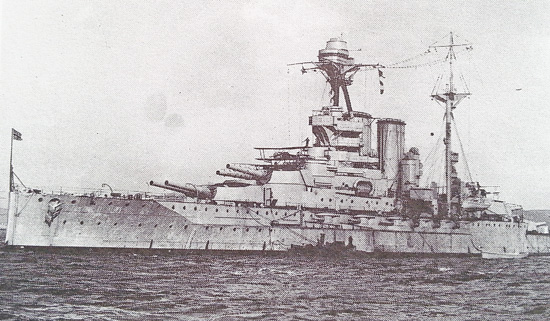
Following the tea and entertainment given by Mrs T O M Sopwith last week to 1,400 children, on Wednesday evening 29th January she gave another huge party in the works canteen as a thank-you to over 900 women from works and staff at the Sopwith Aviation Co. including many who have ceased to be employed since Christmas.
On 30th January, the pilot of Weston-on-the-Green ‘Camel’ F9617 is killed flying into the ground in a half roll whilst an aircraftsman is injured in a propeller accident with ‘Camel’ F2110 at Rochford. The officially modified prototype ‘Two-Seat Camel’ B3801 has moved back from Scampton to the Central Flying School at Upavon where it was originally based from September 1917 as a single-seat standard ‘Camel’.
The second ABC dragonfly engined Sopwith ‘Dragon’ prototype E7990 has been photographed in front of the RAF motor transport sheds at Brooklands (below) now retro-fitted with the latest larger ‘Snipe’ fin and rudder but not the extended horn balanced ailerons.
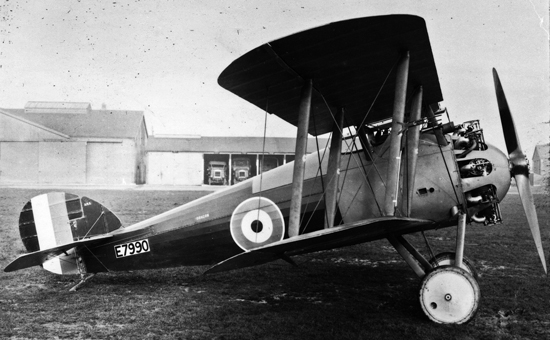
On 31st January, ‘Snipe’ E8017 is overturned and wrecked before a test flight at Marquise when a chock breaks during engine running.
After reduced output in November and December, in January the Sopwith factories have caught up somewhat with 137 aircraft delivered: 28 ‘Dolphins’, 76 ‘Snipe’ and 33 ‘Salamanders’.
The number of new Sopwith aircraft from other contractors after just 190 in December is up to 407 in January bolstered by 258 ‘Snipe’, a record number as they come on stream from Boulton & Paul (111), Ruston Proctor (88), Napier (19) and Portholme (16) plus the first 8 from Coventry Ordnance Works and the first 16 from British Nieuport. There is also the first contractor built ‘Salamander’ which is from Air Navigation (ex-Bleriot-SPAD) at Addlestone. There are 43 ‘Dolphins’ from Darracq (33) and Hooper (10) and just 86 ‘Camels’, a ‘2F1 Ships Camel’ from Arrol-Johnson plus ‘F1 Camels’ from British Caudron (20), Clayton & Shuttleworth (17), Hooper (28), Marsh Jones & Cribb (13) and the final 7 of 350 built by Portholme at Huntingdon.
There are 19 ‘Cuckoos’ from Blackburn (6) and Fairfield (13) whilst official records show a further 24 “at makers” implying they are complete but possibly engineless awaiting decisions about destinations for storage or conversion to the latest engine fit. With only one suitable aircraft carrier commissioned, HMS Argus, it is not surprising that outstanding orders for 50 ‘Cuckoos’ on Fairfield have now been cancelled leaving them just the 11 “at makers” to deliver whilst Blackburn’s outstanding orders for 135 have been cutback to 67. Potential next generation Blackburn Blackburd and Short Shirl torpedo bomber prototypes are currently on service trials.
Compared with the “RAF Aircraft on Charge” report dated 31st December 1918, the 31st January 1919 report lists 479 fewer ‘F1 Camels’ now 1,921 and 196 fewer ‘Pups’ now 502 with both types listed as “obsolete”. There are still 121 ‘Strutters’ listed plus 60 more ‘Dolphins’ now 1,180, 304 more ‘Snipe’ now 758 and 31 more ‘Salamander’ now 93. On the list of “Ship Aeroplanes” are 60 ‘Ships’ Strutters’, 126 ‘2F1 Ships’ Camels’, 9 ‘Ships’ Pups’, 52 SB3 ‘Folding Pups’ plus 23 more ‘Cuckoos’ now 121. Whilst the mix is changing, the total number of Sopwith machines has only reduced by 161 in the month and remains 22% of RAF aircraft on charge.
The distribution of the 4,943 Sopwith machines is still wide ranging, although inevitably the number of those “in store” has risen by almost 400 to 1,767 comprising 25 ‘Strutters’, 167 ‘Pups’, 388 ‘Camels’ and 721 ‘Dolphins’ plus for the first time 12 ‘Salamanders’ and 26 ‘Snipe’ as well as 29 various “ship aeroplanes”.
‘Ships’ Camels’ and ‘Ships’ Strutters’ very much in service are those photographed this week on the flying deck of HMS Furious in Scapa Flow still keeping a watch over the German Fleet there. (below)
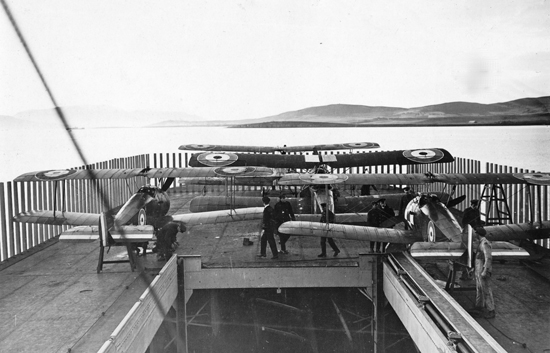
‘Baby & Hamble Baby’ floatplanes are no longer listed but over 40 are still appearing in local records for Hornsea, South Shields, Otranto, Alexandria, Calafrana (Malta) and the Aegean.
Over the last six weeks Harry Hawker has worked with the Herbert Smith and the rest of the Sopwith design and experimental team not just to devise his ideal non-stop trans-Atlantic aircraft but to get it built. The first photograph shows the apparently conventional fuselage (below) sturdier and deeper than the Sopwith B1 or T1 Cuckoo to accommodate the much more powerful 360hp V12 Rolls Royce Eagle VIII engine, an extra-large fuel tank and then the crew of two in staggered seats in an open cockpit behind the wings. The gap in the top decking between the crew and the tail fin is to be filled by an inverted lifeboat. Harry has also insisted on a jettisonable undercarriage to reduce drag, weight and fuel consumption on the flight. The bottom longerons are reinforced with external wooden skids to serve as the landing gear.
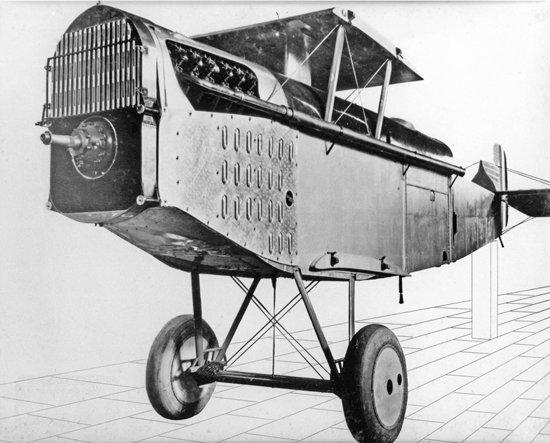
On 1st February, the pilot of Bickendorf ‘Snipe’ E8186 is injured when it goes on its nose after a wheel catches in a rut in a forced landing. At home the pilot of Rochford ‘Camel’ H799 is killed crashing and burning after hitting a wing-tip on an overhead tramway standard. 157 Sqdn with their ‘Salamanders’ is now disbanded, it was originally scheduled to join the RAF in France in mid-September but never left Upper Heyford. The disbandment of overseas and home based RAF squadrons is scheduled to pick up pace dramatically through February whilst ex-RNAS 201, 203, 209 and 210 Sqdns are merging into 203 Sqdn. However most Home Defence squadrons are being retained with Stowe Maries 37 Sqdn, Hainault Farm 44 Sqdn, Rochford 61 Sqdn, Sutton’s Farm 78 Sqdn and Throwley 112 Sqdn replacing their ‘Camels’ with ‘Snipe’. Some surviving famous aircraft have become highly decorated personal aircraft like ex-201/209 Sqdn ‘Camel’ B6398 (below) with at least 11 victories and now “Sylvestre” with an asp and stylised Cleopatra on a white rear fuselage.
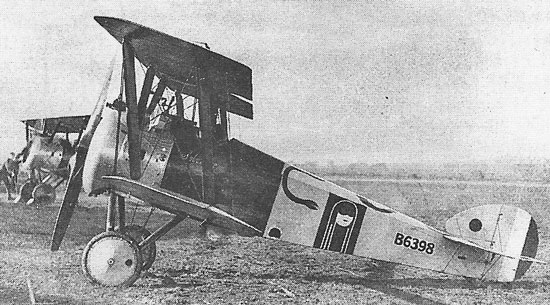
On 2nd February, the pilot of Lopcombe Corner ‘Camel’ F9413 is killed diving-in on a practice firing on a ground target. ‘Snipe’ E7496 is wrecked at Rochford hitting a tree after an engine failure on take-off whilst E8033 is wrecked crashing on landing at Bickendorf after the oil pulsator breaks covering the pilots goggles with oil.
On 3rd February, the third ‘Camel’ prototype B381 delivered to Martlesham Heath way back in March 1917 and since last May at Orfordness for experimental camouflage and parachute harness trials is flown for the last time before being struck off charge.
On 4th February the pilot of Minchinhampton ‘Camel’ F1335 is killed when the wings fold pulling out of a steep dive as is the pilot of Leuchars ‘Ships Camel’ N6824 stalling and crashing after a flat turn. Outside the Officers Mess at Hendon the last of 15 Canadian presentation aircraft are handed over including ‘Long-range Snipe’ E8213 from the City of Leicester (below, in centre) and a Dolphin (behind it)
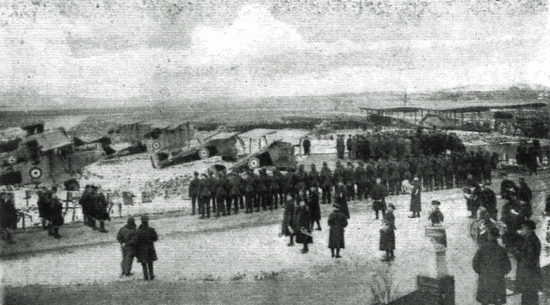
After structural testing ‘Long Distance Snipe’ have been banned from “stunting or aerobatics in any sense of the word” after fears for their integrity with the extra weight of fuel. On 5th February 70 Sqdn are told that those now coming have strengthened fuselage struts behind the fuel tank, slightly larger interplane struts and wings swept back 1½ degrees. Meanwhile a rear cabane strut has failed in flight on Sopwith-built ‘Snipe’ E8176 and 208 Sqdn claim that it is made from inferior cross-grain wood despite carrying an approved AID inspection stamp.
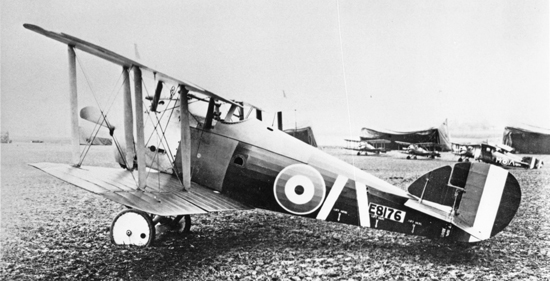
On 6th February, 208 Sqdn ‘Snipe’ E8177 collapses its undercarriage on landing at Strée where they remain to help enforce the Armistice agreement. (above) At home the pilot of Leuchars ‘Camel’ F4987 is injured hitting the ground whilst contour chasing and Beaulieu ‘Dolphin’ D5339 is wrecked crashing from a stall on take-off.
With the Defence of the Realm Act (DORA) censorship restrictions lifted ‘Flight’ journal publishes twelve pages of descriptions and photographs of the most significant Sopwith aircraft with tables of dimensions and performance plus plan, side and front view drawings.(below) Interestingly it includes the as yet only prototype two-seat armoured ‘Buffalo’.
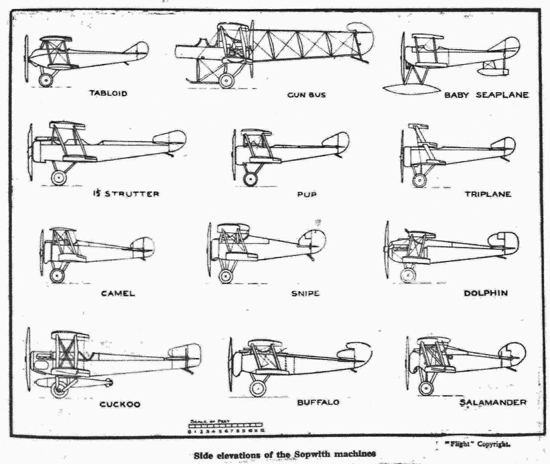
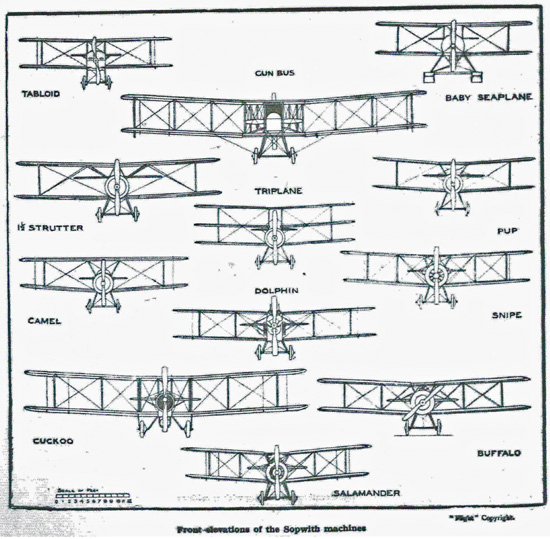
Sopwith announces in ‘Flight’ that the company now occupies 67 South Molton Street in the heart of Mayfair as their “London offices, showrooms and depot for both the aviation and ABC motor cycles sides of the business”.
On 7th February, 70 Sqdn ‘Camel’ F3999 is damaged landing out with an engine failure.
On 9th February, 43 Sqdn ‘Snipe’ E8013 is hit by a DH9 and wrecked whilst taxiing in at Bickendorf.
On 10th February, the pilot of 23 Sqdn ‘Dolphin’ F7048 is killed crashing from a stalled spin on landing at Clermont in Belgium.
At Brooklands Sopwith have photographs taken of the ‘Atlantic’ being prepared for its engine runs. The inverted lifeboat now completes the top decking behind the two-seat cockpit with its keel blending into the very small fixed fin.(below) It has a two-bladed propeller although they have a four bladed option. The fuselage is a new design whilst the wings are 6 ft extended versions of the 6ft 3in chord, 6ft gap wings used on the B1 and Cuckoo.
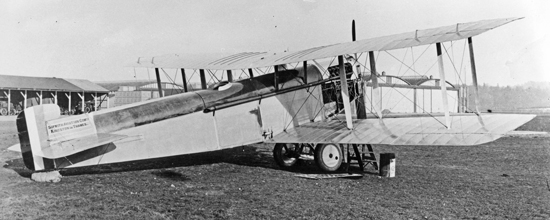
On 11th February, both pilots of Bickendorf 70 Sqdn ‘Camel’ E7228 and 43 Sqdn ‘Snipe’ E8169 are killed in a collision whilst 208 Sqdn ‘Snipe’ E8108 is wrecked swinging on landing at Strée.
On 12th February, the pilot of ‘Snipe’ E7384 is killed wrecking it on a delivery flight whilst 80 Sqdn ‘Camel’ H773 is wrecked and the pilot is injured stalling from a low turn.
On 13th February, just days before 19 Sqdn is due to be disbanded and return home, the pilot of ‘Dolphin’ F7056 going on a practice flight is killed hitting a hangar and nose diving in. 4 Sqdn Australian Flying Corps are also to be disbanded this month and hand their ‘Snipe’ to 70 Sqdn and 80 Sqdn but that will not include E8058 which is wrecked today swinging and crashing taking-off.
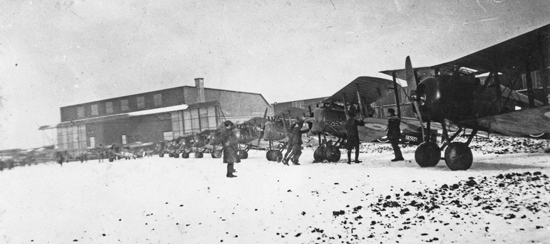
There has been snow this winter at Bickendorf as the photographs show (above & below) but at least 4AFC have the luxury of a hangar to protect the aircraft at night.
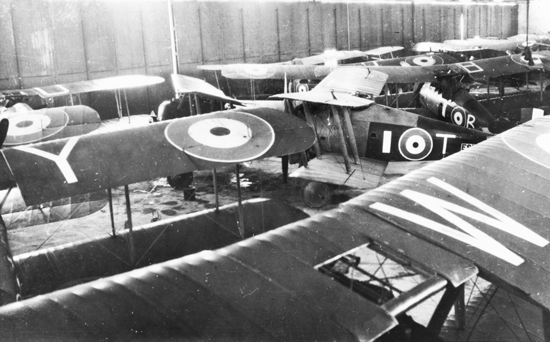
On 14th February, 80 Sqdn ‘Snipe’ E8190 is wrecked crashing in a forced landing with a seized engine whilst at home Manston ‘Camel’ D9575 spins-in after performing aerobatics.
On 15th February, 23 Sqdn ‘Dolphins’ C4072, D3706, D5233 & E4492 are all formally recorded as “in poor condition after 30 days exposed to weather” at Clermont. Their unheated canvas hangars are not the ideal place to store wood and fabric aircraft with water cooled engines in winter in Belgium.(below)
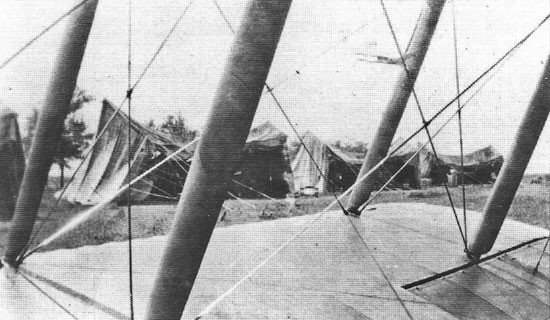
On 16th February, the six ‘Camels’ of C Flight 17 Sqdn move on from Salonika to San Stephano, Constantinople. D6549 crashes on landing to refuel at Drama and C1600 crashes taking-off after refuelling. D6641 and three others manage to refuel but meet bad weather and are forced to land up to 80 miles short of the destination. One of these will have to be collected by sea and the other three will have to complete the journey by road.
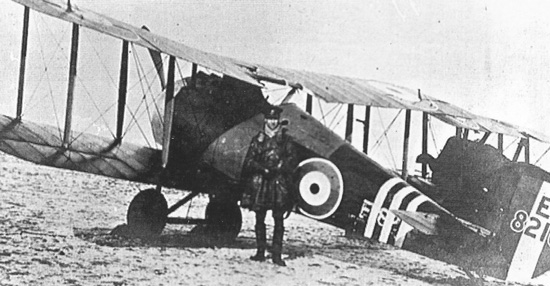
On 17th February, ‘Long-range Snipe’ like E8216 (above) have continued to arrive with 70 Sqdn at Bickendorf but today RAF Headquarters in France advise the Air Ministry that they have no further use for these bomber escorts and are having them flown back to England. Today the fuselage of ‘Snipe’ E8151 is allotted to Daimler for vibration tests. Despite Humber doing much of the development work on the Bentley BR2 engine, Daimler are the lead manufacturer and they are co-ordinating further work.
On 18th February, the pilot of Bickendorf 70 Sqdn ‘Camel’ F2010 is killed in an unexplained crash.
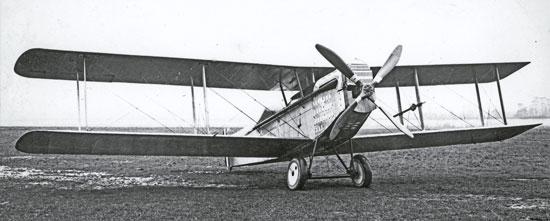
The latest photographs of the Sopwith ‘Atlantic’ at Brooklands dated 21st February show the extended wingspan, fat tyres and the small retractable propeller out of the port side of the fuselage to generate electricity for the experimental Marconi radio direction finder. There is a direct reading speed gauge on the inboard port wing struts and now the optional four-blade propeller. The 330 gallon fuel tank and 24 gallon oil tank are between the engine and the cockpit.
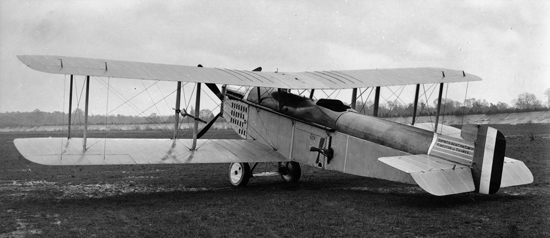
Harry Hawker has chosen as his navigator Lt Cdr K K Mackenzie-Grieve who had impressed him when they met during deck landing trials on HMS Campania. Since being chosen Mackenzie-Grieve has qualified as a pilot at Eastchurch in just 6 days. They are starting test flights and are planning to work up to a practice overland flight of 1,800 miles equivalent to an Atlantic crossing from Newfoundland to Ireland. This is all before submitting an official entry to the prize competition but they are first to have a machine ready to fly. There are many other teams at work mostly in secret. Harry’s friend and pre-war competition rival Fred Rainham is working on a slightly smaller single-engined contender at Martinsyde in Woking whilst Vickers at Brooklands have decided to modify a twin-engined Vimy bomber, Boulton & Paul a version of their twin-engined Bourges bomber and Handley Page a four-engined bomber. Short Bros are preparing a development of their Shirl torpedo bomber with Fairey the only ones adapting a floatplane. All but Boulton & Paul are choosing Rolls-Royce engines. Meanwhile the US Navy has been secretly preparing some Curtiss flying boats.
On 22nd February, on delivery flights of 13 ‘Camels’ to Boisdinghem from 70 Sqdn at Bickendorf D1953, F1930 & H7003 all crash in forced landings short of fuel, F1935 lands-out short of fuel as does F1933 with engine failure. At home the pilot of Sutton’s Farm ‘Camel’ C8355 is seriously injured crashing after hitting a wireless aerial.
Over the last ten days there has been confirmation of order cancellations for a further 450 ‘Snipe’, 150 of the 300 on Coventry Ordnance Works plus all 100 on Garrett and all 200 on Ransome. The latter two orders were issued just days before the Armistice on companies with no previous Sopwith aircraft manufacturing experience.
On 23rd February, 23 Sqdn ‘Dolphins’ E4737 & E4739 are damaged in forced landings with engine trouble on their way to 6 Air Issues Section in France for re-allocation. Meanwhile 4 Sqdn Australian Flying Corps complete the handover of 15 ‘Snipe’ to 70 Sqdn at Bickendorf and 9 ‘Snipe’ to 80 Sqdn at Strée and are packing to set out in the next few days via Le Havre to Hurdcott Camp in the UK on their way home to Australia.
On 24th February, the pilot of West Fenton ‘Camel’ D9535 is killed stalling and spinning-in after an engine failure on take-off.
On 25th February, 80 Sqdn ‘Snipe’ E8092 is wrecked after a cylinder bursts and it overturns forced landing in a ploughed field. At home the pilot of North Weald Bassett ‘Camel’ H3997 killed diving-in inverted after a spin.
On 26th February, the pilot of Hainault Farm ‘Camel’ F1993 is killed spinning-in during formation flying.
The testing of an ABC Dragonfly Mk.II engine in ‘Snipe’ B9967 at RAE Farnborough shows no improvement in power or reliability or unpredictable rough running. It has only managed 6½ hours flying since early December. They are focussing on ignition and more even fuel distribution plus better exhaust gas muffs to heat the air induction pipes to the carburettor to help high altitude running. A second Mk II is being fitted to ‘Bulldog’ X4.
On 27th February, in the USA Swedish pilot Hugo Sundstedt, is only a few days behind Harry Hawker in making a first flight in a trans-Atlantic prize contender but has to land his lightweight 100ft wingspan twin Liberty engined floatplane “Sunrise” after just one mile with engine trouble.
On 28th February, 70 Sqdn ‘Snipe’ E8212 is wrecked crashing in a forced landing due to an engine failure.
After 137 aircraft delivered in January the Sopwith factories deliver 100 in February with 64 ‘Snipe’ and 36 ‘Salamanders’. The final 7 ‘Dolphins’ are not yet recorded as delivered but have cleared the factory.
The number of new Sopwith aircraft from other contractors after 407 in January is also well down at 225. There are 162 ‘Snipe’ from Boulton & Paul (38), Ruston Proctor (59), Nieuport (24), Napier (16), Portholme (17) plus 8 from Coventry Ordnance Works. There is also the second contractor built ‘Salamander’ from Air Navigation. There are 32 ‘Dolphins’ from Darracq (12) and Hooper (20) and just 31 ‘F1 Camels’ from British Caudron (18), Hooper (5), Marsh Jones & Cribb (8). There is definitely one more ‘Cuckoo’ delivered by Blackburn but it is not clear if the 24 ‘Cuckoos’ on official records last month as “at makers” are yet confirmed as delivered.
At least 20 of the ‘Snipe’ built by Ruston Proctor during February (E7511 to E7530) have been despatched in packing cases for shipment to Egypt in anticipation of moving a squadron out there.
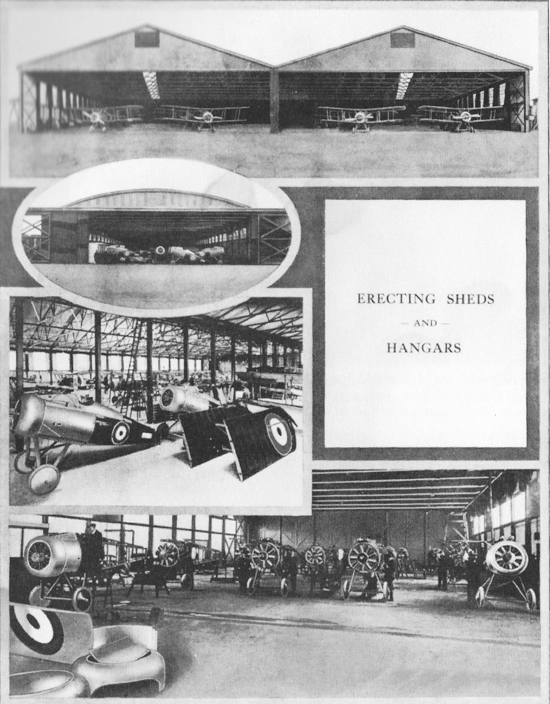
Bolton & Paul’s brochure (above) has images of their extensive ‘Snipe’ assembly and flight test facility at Mousehold aerodrome although the method of taking airframes there from the Riverside Aircraft Works in Norwich is basic.(below)
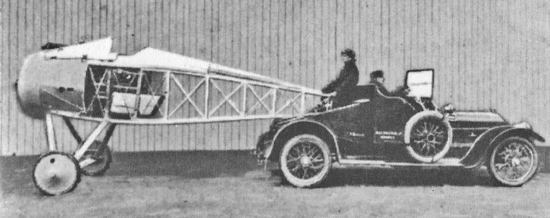
On 1st March, recently completed Boulton and Paul ‘Snipe’ E6157 crashes into the Thames just south of Richmond bridge on a ferry flight from Northolt to Croydon after the pilot is seen to drop from the aircraft over Richmond Park. The Richmond Coroner records a verdict of accidental death after witnesses report the aircraft to be at high altitude with very noisy engine and some go further to say it was backfiring and on an erratic course before it goes steeply nose up as if to loop before the pilot falls out and plummets into the Sidmouth Plantation in Richmond Park. His clothes were extensively burnt and there was a burnt box of matches in his pocket and the wood around the pilot’s seat is “well scorched”. The RAF representative suggests that the pilot lost control after undoing his seat belt to try to extinguish a fire probably caused by an engine backfire.
A few days after arriving from 4 Sqdn AFC, 80 Sqdn ‘Snipe’ E8069 is wrecked running into a ditch in a forced landing with an engine failure whilst, also with the Army of Occupation at Strée, 208 Sqdn ‘Snipe’ E8313 is wrecked overturning when its wheels stick in the mud on landing
On 3rd March, 70 Sqdn ‘Snipe’ E8205 is wrecked crashing on landing at Bickendorf returning from a practice flight where 43 Sqdn ‘Snipe’ E8204 has recently been photographed in the snow. (below)
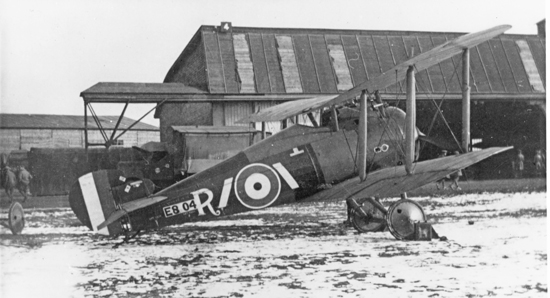
Meanwhile a Sopwith Aviation Company Board Meeting on 3rd March agrees 17th March as the new date to call the postponed Extraordinary General Meeting to approve the change of name of the company to the “Sopwith Aviation and Engineering Company” and approves the legally recommended wording for extending the objects of the company. These two extra objects allow considerable scope for exploring ways to keep the business successful. The first is “To carry on the business of manufacturers of motor cycles, motor vehicles and conveyances of all kinds and of all machinery materials and things applicable or used as accessory thereto and of repairing and maintaining the same respectively and of selling exchanging and otherwise dealing in the same respectively. The second is “To carry on the business of coach and carriage builders, cabinet makers, carpenters, joiners, wood craftsmen and upholsterers and manufacturers of all kinds of furniture, hardware, electric light fittings, gas fittings, all articles of domestic or commercial use, mechanical toys, manufacturers of patent fuels from wood waste, manufacturers of all kinds of woodwork and metalwork required in the erection and fitting up of houses and of boats barges and other similar craft and to sell exchange and otherwise deal in the products of such manufactures”.
US Aero Squadrons are leaving France with some of their ‘Camels’ and ‘Strutters’ being shipped to the USA. There are also some ‘Camels’ being sent from the UK including in the last few days D9400, D9530 & F1451.
US Navy battleship USS Texas arrived at Scapa Flow in the Orkney Islands on 11th February 1918 to be part of the Sixth Battle Squadron of Britain’s Grand Fleet and by November 1918 had been fitted with aircraft take-off platforms on fore and aft turrets like those being used on British warships. They were apparently not used but now she carries the US Navy’s first “Ship Plane Unit” of two ‘Camels’ and a ‘Strutter’ and on 9th March 1919 Lt Cdr McDonnell in a Sopwith ‘Camel’ makes the first ever flight from a U.S. Navy battleship when he takes off from the No.2 turret with Texas lying at anchor at Guantanamo Bay, Cuba. (Camels on USS Texas below)
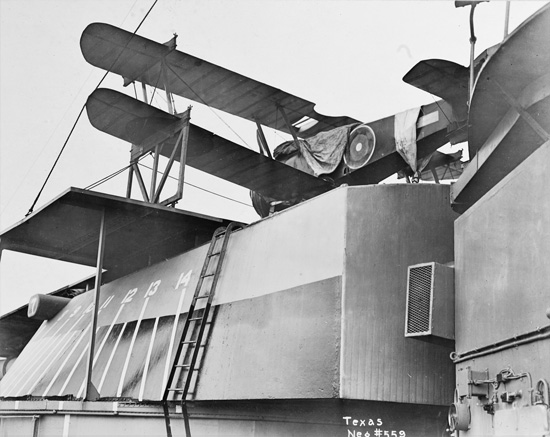
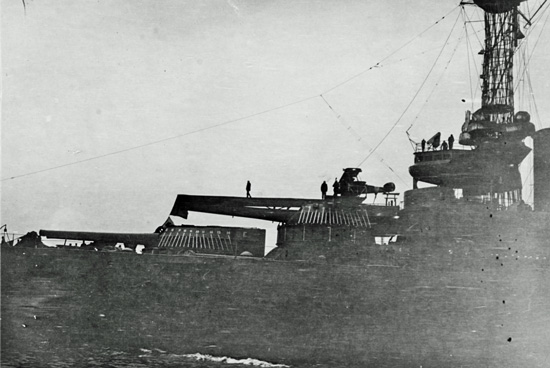
On 10th March, 208 Sqdn ‘Snipe’ E8134 is wrecked landing too slowly at Strée whilst 28 & 66 Squadrons have arrived home from Italy without their ‘Camels’ and are at Yatesbury for demobilisation.
On 11th March, the sergeant pilot of ‘Camel’ H811 is injured and the aircraft wrecked crashing in France on a delivery flight to No.1 Aeroplane Supply Depot at Marquise.
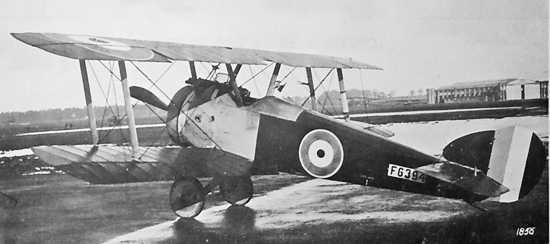
Martlesham Heath’s report on the performance of ‘Camel’ F6394 experimentally fitted with a 180hp Le Rhône engine (above) shows it to be reliable over 17 hours running, matching or marginally improving on the performance of previous tests with the 150hp Monosoupape engined F1336 for the USAS. The only issues are the risk of dust into the air scoops in the crank case in active service and the need for shaft and cowl extensions. The trial started last October and has been completed despite RAF ‘F1 Camels’ since being declared obsolete. This aircraft has had many different engine fits and still carries the larger rudder from a previous successful trial.
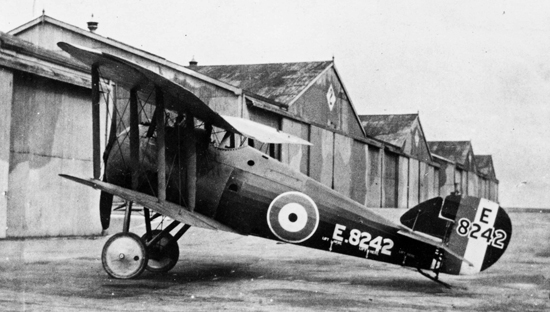
Pristine Sopwith-built ‘Long-range Snipe’ E8242 (above) is one of those originally allocated to 70 Sqdn in Germany but no longer wanted. They are being gathered at Thetford awaiting a new allocation.
On 13th March, ‘Snipe’ E8324 is run into and wrecked by DH4 F5737 on Tourmignies aerodrome in France.
On 14th March, ex 4 Sqdn AFC Bickendorf ‘Snipe’ E8011 and E8099 are both wrecked in misjudged landings at the same 92 Sqdn airfield during delivery flights.
On 15th March, 208 Sqdn ‘Snipe’ E8167 is wrecked deliberately stalling to avoid hitting wires on an overshot landing at Sonstiennes. 17 Sqdn ‘Camel’ D6553 based at St Stephano in Turkey crashes on a test flight in a gale.
On 17th March, the pilot of ‘Snipe’ E6254 is injured stalling in high winds after avoiding goal posts landing on a delivery flight. 37 Home Defence Sqdn and their ‘Snipe’ move from Stowe Maries & Goldhanger to Biggin Hill.
Harry Hawker and Mackenzie Grieve have completed their thorough testing of the Sopwith ‘Atlantic’ including a trouble free 9 hour 5min non-stop 900 mile flight which is roughly half the distance of a flight from Newfoundland to Ireland. On 18th March Hawker and Mackenzie Grieve and the crated aircraft leave Liverpool on board SS Digby on their way to St John’s Newfoundland accompanied by a Rolls-Royce engine expert and the cine photographer who has been filming the trial flights from a ‘Buffalo’. Harry Hawker’s declared aim is to leave Newfoundland at 4pm local time and reach Brooklands in 19½ hours arriving 4pm local time the next day.
This same day the Sopwith Aviation Company formally enters them for the Daily Mail Trans-Atlantic Prize. They have been confident enough in the design to have already sent Montague Fenn from Sopwith’s Paris Office out to Newfoundland. He has found a field at Mount Pearl and started erecting a wooden hangar. Capt Morgan, Fred Raynham’s navigator for the Martinsyde contender, has been out there even longer and selected a different field at Quidi Vidi. Neither field is ideal but there is very little flat enough open ground around St John’s which both teams have chosen as their base being by far the most easterly port and city in North America.
In the latest of ‘Aeroplane’s’ “Post-Bellum” interviews about the future of aviation MR T O M Sopwith C.B.E. is able to announce his company’s initial products for the civil market. The first “exactly along the lines of Pup” with an 80hp Le Rhone will perform as well as a Pup but as “purely a pleasure two-seater with 3 hours petrol expected to turn out at less than £1,000 and running costs not heavy with petrol consumption in normal weather at 17 miles to the gallon”. “The three-seater will be for the man who wishes to get about quickly and who will employ a pilot. The two passengers will be seated side by side in a decked-in fuselage providing the greatest possible amount of comfort and freedom from wind-pressure and cold.” He says they already have three other types designed for marine and long-distance travelling, larger than the machines for which his company is best known but still single engined. “He does not feel inclined to construct a large multi-engined machine until he has a very definite idea of what will be required of it”. In regard to competitions his policy “will be to enter every competition that is reasonable”. On design trends he believes that speed within economical limits will be the predominating factor but not at the cost of high landing speeds, with ultimate ceiling not very important as most flying will be below 10,000ft whilst personal comfort for pilot and passengers is undoubtedly very important for long journeys with a good view of the land that is passing underneath. He is keen that pilots will be highly qualified, pass very stiff medical examinations and be experts in navigation to give the public a very definite guarantee that their competence is beyond question. He concludes that “the industry is very young and will want careful nursing into a sound commercial proposition. That it can be done there is no doubt, but it is a great mistake to raise the hopes of the public, as is being done, until we know on what those hopes can be built”.
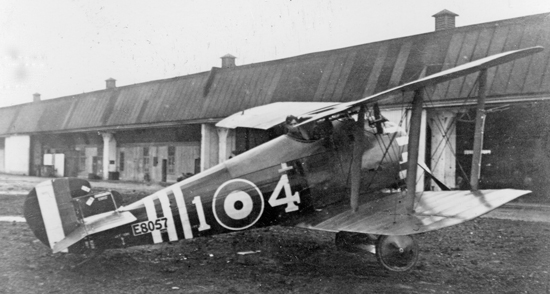
On 19th March, ex 4 Sqdn AFC ‘Snipe’ E8057 now in 70 Sqdn markings (above) is wrecked crashing on landing at Bickendorf. ‘Snipe’ E6165 last recorded at 10 AAP at Brooklands is also crashed and deleted. Headquarters Command Squadron ‘Camel’ C8357 is crashed by Brig-Gen Ludlow-Hewitt at St André-aux-Bois airfield.
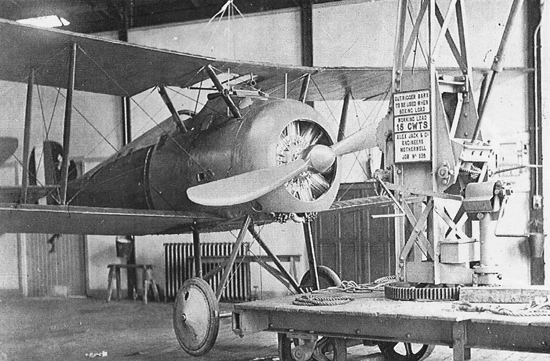
Also dated 19th March, is this photograph (above) of a ‘Snipe’ at Grain suspended from a crane by a sling. The Navy have at least one other ‘Snipe’ E8068 which, fitted with a hydrovane and floatation gear, is still on performance trials at Martlesham Heath indicating their continued interest in using ‘Snipe’ on anti-submarine duties.
On 20th March, it is proposed that 12 ‘Snipe’ and 4 spare engines are sent to reinforce the RAF Contingent at Archangel who continue to support White Russian Forces despite a harsh winter with very little flying.
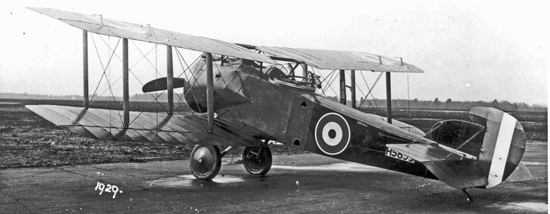
Martlesham Heath’s report on the second prototype Sopwith ‘Buffalo’ H5893 (above) with its heavy two-seat armour plated fuselage section found it only to be stable laterally and lateral control is rather heavy. Speed is quickly lost or gained in climbing or diving, it has a steep glide angle and high landing speed. “General flying qualities for such a machine are good with no tricks and it is on the whole easy to handle but does roll around in bumps” whilst “BR2 engine vibration appears to be increased by the rigid armoured cockpit”.
Two weeks ago Surrey County Council wrote to Sir Howard Frank, Ministry of Munitions Director General of Lands (DGL), demanding to know why the September 1917 undertaking that the National Aircraft Factory at Ham will be of a temporary nature has been overlooked and Ham Urban District Council have been told that “it cannot be treated otherwise than a permanent factory”. The DGL asks his team to suggest a response to the Council noting that “Mr Churchill personally approved the original letter but subsequently turned a complete somersault which is by no means unusual but for which I have no intention of allowing others to think me responsible”. He is advised that “Sopwith’s Ham factory is one of the best arranged factories in the United Kingdom. They are operating the factory on a rental basis and are prepared to negotiate for the purchase outright if the temporary promise can be rescinded. I suggest making a bargain with them to warrant them taking action to induce Surrey County Council (SCC) to waive their objections and thereby curtail the Ministry’s losses”. After a top level meeting DGL is to obtain Treasury sanction for the acquisition of the land and start negotiations for the disposal whilst a letter is sent to SCC on 23rd March with a copy of the letter to Ham Council restating that it is to be permanent.
On 23rd March, 19 Training Depot Station El Rimal in Egypt ‘Pup’ D4084 is written-off in a crash.
On 25th March, the pilot of 43 Sqdn Bickendorf ‘Snipe’ F2361 is injured crashing after hitting electricity cables.
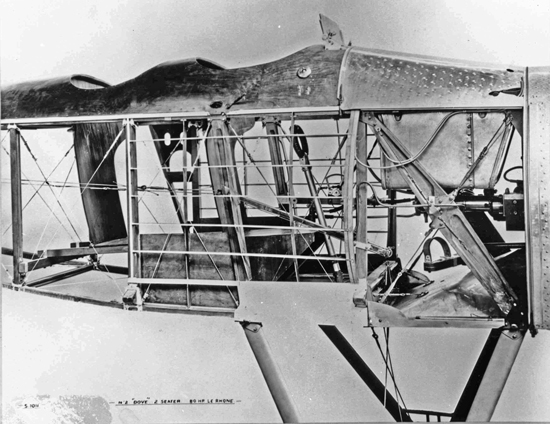
The first Sopwith ‘Dove’ sporting two-seat development of the military ‘Pup’ is photographed uncovered at the factory and on, 26th March, complete at Brooklands.(below) Using the same 80hp Le Rhône engine as the ‘Pup’, performance is expected to be similar with the added weight of the passenger offset by the absence of military equipment. The 18 inch shorter wings are slightly swept back to balance the revised weight distribution whilst the fin and rudder are larger and more rounded very like those of a ‘Camel’.
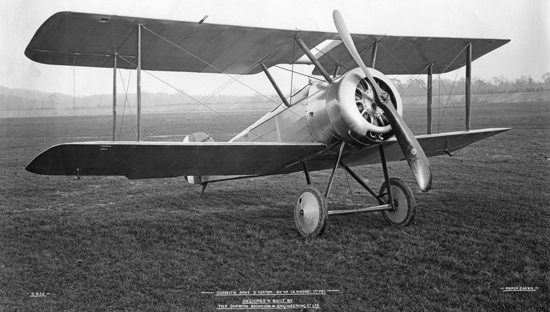
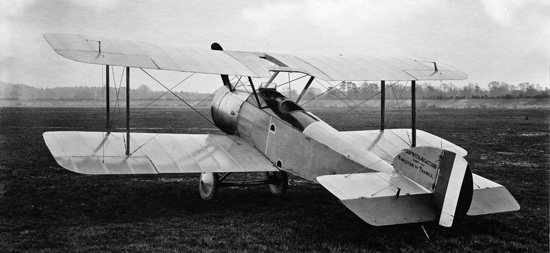
On 27th March, Flight journal declares that “it is a sign of the times that the Australian Government has offered a Government Prize of £10,000 for the first flight from Britain to Australia by a machine manned by Australians”. Perhaps co-incidentally one-time Sopwith mechanic Bert Hinkler who subsequently joined the RNAS wrote to his parents in Australia just 5 days ago that he has been contemplating a flight home “1,000 miles or so at a stretch” and says that Sopwith has suggested a special civilian machine rather than a ‘Camel’ like the ones he flew in Italy.
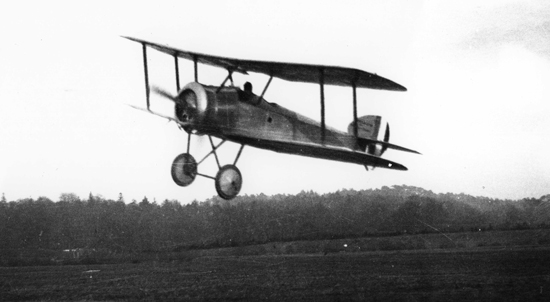
The first Sopwith ‘Dove’ has now been photographed being flown solo and two-up at Brooklands. (above & below) The early flights confirm it to be a sound design.
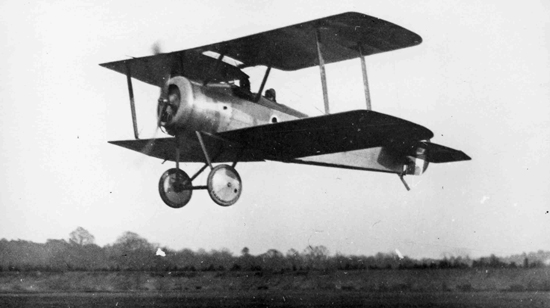
Sopwith think ‘Doves’ will sell and decides to risk building a few more starting with a special version with a long range fuel tank in place of the passenger for Hinkler‘s projected flight to Australia.
In the last three days Short Brothers, Fairey and Martinsyde have formally entered for the Daily Mail Trans-Atlantic Prize. Short’s modified ‘Shirl’ torpedo bomber is now appropriately called ‘Shamrock’ as they are planning to fly east-west from Ireland. Martinsyde’s Raymor is named after its crew Raynham and Morgan. It is reported to be nearly ready after a non-stop 10 hours flight from Brooklands to Southampton and back five times followed by a 24 hours full-power simulated flight tied down in a large hangar with the crew aboard. The 275hp Rolls-Royce Falcon engine has since been stripped and found to be in perfect working order.
On 28th March, the SS Digby arrives off Newfoundland but St John’s harbour is still ice bound and they have to go round to Placentia Bay where the two large crates, smaller crates and the Sopwith team have to be trans-shipped to the smaller SS Portia (below ) to get into the port and then onto railway wagons at the quayside (below again) for the 60 mile train journey to St John’s.
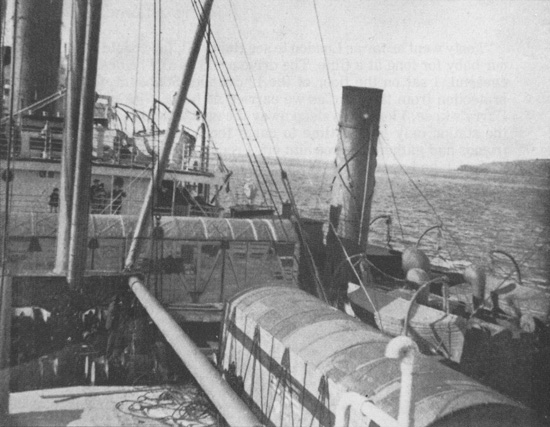
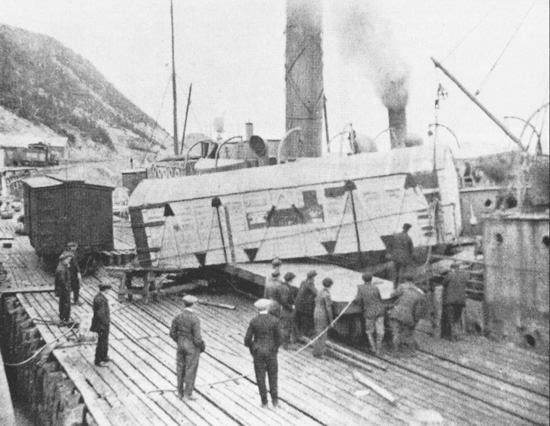
They reach St John’s by 30th March, and Harry Hawker’s hope that it would simply be a matter of assembling the aircraft, having one or two test flights and flying home after a couple of weeks is already looking over optimistic.
There is still snow on the ground and the terrain is much more rugged than he envisaged from studying the maps. The journey of over 4 miles up narrow sodden muddy tracks to the “airfield” at Mount Pearl Farm 450ft above sea level typifies the difficulties with teams of five pairs of horses struggling to pull the large crates on thick timber platforms called slovens which in winter are fitted with sled runners.
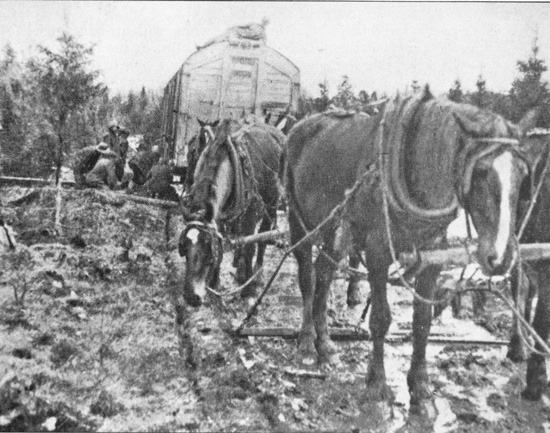
Harry is even more concerned when he sees the field. He concedes that “Captain Fenn has got the very best field available” but it is L-shaped around a steep sided 200ft high hill. The 400yds long west-east limb is slightly downhill with low trees at either end. The 200yds shorter north-south limb comes “strongly downhill” to join the east end of the longer limb and faces high trees. The ground is sodden from the snow particularly at the west end of the longer limb and Cpt Fenn already has sixty local men filling up the worst soft places. The only good news is that Fenn’s rough wood hangar is a substantial enclosed structure, 55ft by 50ft and 30ft high.
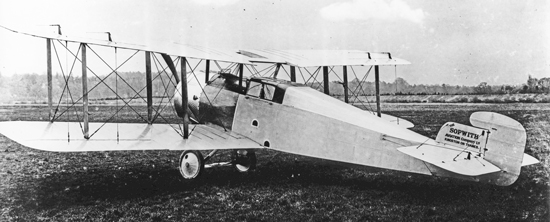
On 31st March less than a week after Sopwith’s first post-war civil type the “Dove”, their second new civil type is also photographed at Brooklands. (above) The ‘Gnu’ is a larger more powerful machine clearly intended for more than just recreational flying. With enclosed accommodation for two passengers it is potentially a chauffeur piloted rich man’s flying limousine, an air taxi or a cargo/mail carrier.
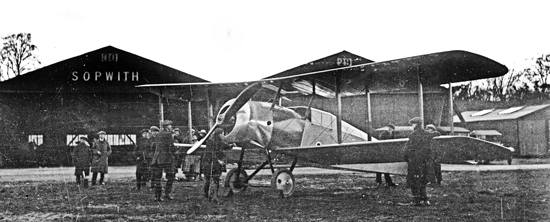
Quickly developed from Sopwith’s Bulldog and Buffalo two-seat military prototypes using their 5ft 6in chord wings and the same fin and rudder, this first example also has their 200hp Bentley BR2 rotary engine but it is to be offered with a more economical 110hp Le Rhône rotary. It has an adjustable incidence tailplane to balance variable passenger loads. The glazed roof and side windows are hinged on the centreline lifting up to provide access for each passenger. The rear view shows the wide fuselage to accommodate the side-by-side seats.
On 31st March 208 Sqdn ‘Snipe’ F2343 is wrecked crashing on landing from fighting practice at Strée whilst ‘Cuckoo’ N7163 has arrived at Martlesham Heath for manoeuvrability tests over a camera obscura.
After 137 aircraft delivered in January and 100 in February the Sopwith factories deliver 61 military aircraft in March with just 8 ‘Snipe’, a record 46 ‘Salamanders’ and the final 7 ‘Dolphins’. They have also completed but not sold two civil machines as private ventures.
The number of new Sopwith aircraft from other contractors previously noted as 407 in January and 225 in February can now be increased to 415 and 249 with indications that Pegler & Fairfield have completed their orders for 20 & 50 ‘Cuckoos’. Deliveries of Sopwith aircraft from contractors in March amount to 292. These include 12 more ‘Cuckoos’ from Blackburn and 210 ‘Snipe’ from Boulton & Paul (48), Coventry Ordnance Works (9), Napier (37), Nieuport (31), Portholme (17) and Ruston Proctor (67). There are 10 ‘Salamander’, 9 from Bleriot/Air Navigation and the first from Glendower’s factory near Kew Bridge and 34 ‘Dolphins’, 7 from Darracq and 27 from Hooper plus 26 ‘F1 Camels’, 2 from British Caudron, 7 from Hooper, 13 from Marsh Jones & Cribb and the final 4 of 573 from Clayton & Shuttleworth. Almost certainly also delivered are some of the 25 remaining ‘2F1 Ships Camels’ sub-contracted by Beardmore onto Arrol Johnson.
Compared with the “RAF Aircraft on Charge” report dated 31st January 1919, the 31st March report lists 1,341 fewer “obsolete” ‘F1 Camels’ now 579 and 313 fewer “obsolete” ‘Pups’ now 189. There are still 70 ‘Strutters’ listed plus 17 more ‘Dolphins’ now 1,197, 367 more ‘Snipe’ now 1,125 and 59 more ‘Salamander’ now 152. On the list of “Ship Aeroplanes” are 64 ‘Ships Strutters’, 152 ‘2F1 Ships Camels’, 6 ‘Ships Pups’ and 35 more ‘Cuckoos’ now 156. The 52 SB3 ‘Folding Pups’ have finally disappeared. The total number of Sopwith machines has reduced by 1,260 in the two months to 3,697 and dropped from 22% to 19% of RAF aircraft on charge.
On 2nd April, the Handley Page ‘V/1500’ four-engined entry for the Trans-Atlantic Prize makes its first flight. It is double weight and power of an ‘O/400’. On free of charge loan from the Air Ministry it carries its F7140 military serial number.
By 3rd April, Capt Sundstedt’s American-built twin-engined floatplane has been crashed by a pioneer Russia pilot spinning-in from 400ft. It is damaged and waterlogged and be withdrawn from the Trans-Atlantic Prize entries. The US Navy have decided that they cannot compete for a prize given by private enterprise but are still preparing to be first across with three of their huge own-designed Type NC multi-engined flying boats built by the Curtiss Aeroplane Company.
On 3rd April, RAF Headquarters in France are notified that no Napier-built ‘Snipe’ is to be flown until the pipes from the Badin venturi fuel system have been re-connected to the correct places. This is followed by another report that ‘Snipe’ throttle control rods have been fitted with plain nuts and spring washers which must be replaced by castellated nuts and split pins.
On 4th April, the Sopwith Board Meeting seals the motorcycle building licence agreement with ABC Motors and agrees to act as guarantors to an ABC bank overdraft of up to £30,000. Looking for other possible future products to keep the factory busy the Board also agree to patent applications in conjunction with the inventors for an improved knife cleaning machine and improved mechanical toys. The accounts are still healthy and a 6% per annum dividend is approved for the preference shareholders for the half year to 31st March.
Meanwhile, 70 Sqdn ‘Snipe’ E8157 is wrecked in a misjudged landing at Bickendorf from a practice flight.

On 5th April, sister 70 Sqdn ‘Snipe’ E8263 is wrecked crash landing. Both are carted away (above) whilst 43 Sqdn’s ‘Snipe’ E8321 is wrecked hitting a wingtip on the ground in a low turn to avoid a DH9. (below)
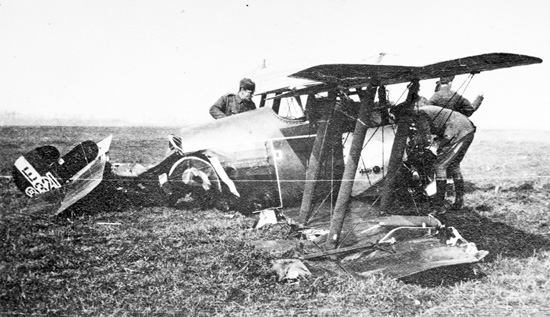
On 7th April, 208 Sqdn ‘Snipe’ E8129 is wrecked bouncing and overturning landing at Strée.
The same day, 208 Sdn ‘Snipe’ E8129 is wrecked bouncing and overturning on landing at Donstiennes.
On 8th April, there is a second successful flight from a US Navy battleship. This time a ‘Camel’ flies from the forward turret ramp of USS Mississippi in Guantanamo Bay, Cuba. (below)
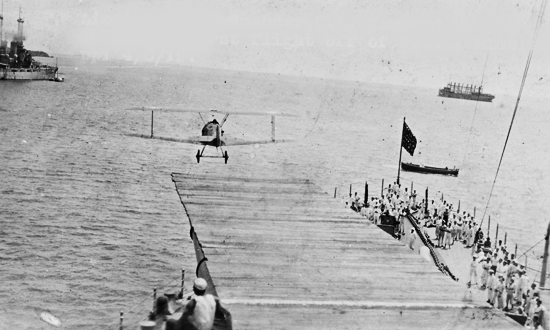
At home ‘Ship’s Camel’ N6834 crashes into the sea taking-off from HMS Argus.
Flat top aircraft carrier HMS Argus emerged from a refit on 21st March and is now on trials with ‘Cuckoo’ torpedo bombers, ‘Ship’s Camels’ and ‘Ship’s Strutters’ aboard. There are reports that to aid aircraft and personnel movements around the deck, the previously raised fore and aft arrester wires are now flat on the deck with ramps down into the 9 inch lowered rear aircraft lift to provide an area where aircraft on landing can drop down to engage their undercarriage hooks under the wires and be safely held. With no cross axle for the hooks, a cumbersome solution is being devised for ‘Cuckoos’ with pairs of arrester hooks fitted either side of the wheels. Meanwhile ‘Cuckoos’ from East Fortune have dropped scores of dummy torpedoes in the Firth of Forth. The best results have been obtained by dropping up-wind from just 12 to 20 ft keeping the torpedo within 3 degrees of the horizontal using drogues with its speed hitting the water at 70 to 80 kts. Trying to achieve all these conditions out at sea with only rudimentary sights and releasing the torpedo at precisely the right moment will require fine judgement and careful flying not helped in operational conditions by the likelihood of coming under fire.
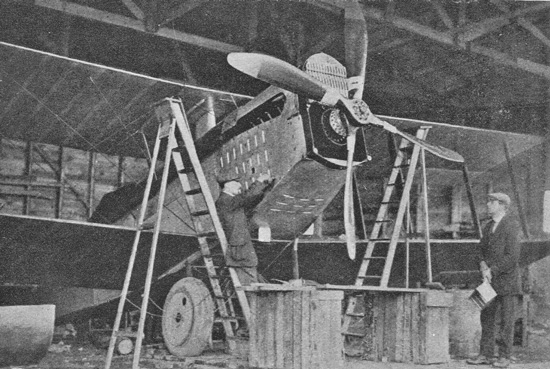
With snow and rainstorms outside, the Sopwith team have taken a week to assemble the ‘Atlantic’ in the substantial wooden hangar on the remote airfield in Newfoundland.(above) The propeller appears to be two two-bladed ones bolted together. On 10th April, with the mud bath airfield hardened by a frost, Harry Hawker manages a lightly loaded 1hr 10 min flight, despite damaging the rudder on a difficult take-off. The local newspaper reports that he “appeared to get into a vacuum and we thought she would crash but the plane got off by skilful management”. The Senate in St John’s is prorogued for members to join the crowds gathered to see an aeroplane flying for the first time. The engine performs well but the wheels sink into the mud on landing despite the light payload.
Boulton & Paul become yet another contender to formally enter the Trans-Atlantic competition with a civil development of their Bourges prototype bomber powered by two Napier Lion engines.
On 11th April, Fred Raynham and the Martinsyde team arrive at St John’s with their Raymor aircraft. In France ‘Dolphin’ D5290 is damaged undershooting landing from a test flight at No.1 Aeroplane Supply Depot in France whilst ‘Camel’ E1433 is one of those now moved from Taranto in Italy to X Aircraft Depot at Alexandria in Egypt.
On 12th April, the Governor of Newfoundland with local dignitaries and military officers inspects the Sopwith ‘Atlantic’ at the airfield and presents Harry Hawker with a letter from the King. The Royal Aero Club representative attaches seals to the mainplanes and provides a letter containing the engine number and a list of identification marks for Harry to deliver to the club on landing.
In Belgium the pilot of 208 Sdn ‘Snipe’ E8143 is injured hitting trees in mist and rain.
On 13th April, the Vickers ‘Vimy’ twin Rolls-Royce engined Atlantic contender makes a test flight at Brooklands where it has been built.
Unbeknown to Hawker and Raynham out in Newfoundland, Short Brothers are close to stealing the march on them. The Short ‘Shamrock’ made a first flight at Grain on 8th April and should be ready for an east-west flight from Ireland in the next few days. Developed from the Short ‘Shirl’ torpedo bomber it has a greater wing area and its range is extended to 3,200 miles by a huge fuel tank suspended in place of the torpedo. Painted white it has Short’s name on the side and a Union Flag on the tail.
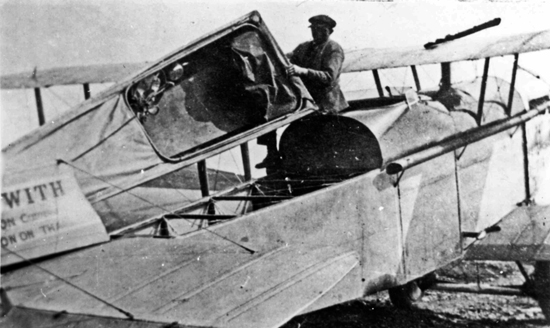
Hawker and Mackenzie-Grieve frustrated by bad weather are hoping that the full moon on 16th April will be the ideal opportunity to make the Atlantic attempt. In the meantime they are testing their survival kit in the event of a ditching. They have removed the 3-ply lifeboat from the rear of the aircraft (above) and tested it on a lake. The bow contains a sea anchor, emergency rations, paddles and smoke flares plus parachute flares for night signalling. The stern has a floatation air-bag which also supports the collapsible canvas top decking. With snow all around and still only wearing their customary cloth caps, suits and ties, Harry reports that they have great fun. (below left)
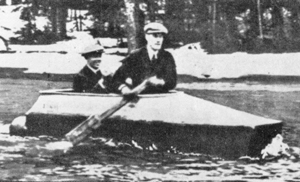
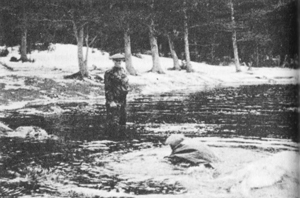
They go on to test their American Navy pattern immersion suits in the lake (above right ) after replacing the very heavy kapok insulation with air-bags front and back which can be inflated by mouth.
Asked by reporters about the Martinsyde Raymor’s survival gear, Fred Raynham replies that he intends to fly across the Atlantic not land in it.
On 16th April, in a brief lull in the storms the Martinsyde Raymor is wheeled across the road from its tent hangar to the narrow airstrip at Quidi Vidi on the water’s edge outside St John’s. Witnessed by a large crowd including the Sopwith team, Fred Raynham easily gets the lightly-loaded machine away, makes a 3 hour test flight and a perfect landing. Both teams are staying in the Cochrane Hotel watching each other in a cat and mouse game. Fred Raynham believes he can afford to allow Harry Hawker a three hour start and still catch him. Their 16th April target date for setting off across the Atlantic with a full moon is scuppered by the heavy storms, 50 mph winds and new snow.
However, on 17th April, in optimistic anticipation of better weather over the Atlantic and as Raynham makes another short trial flight, the 350 gallons of fuel and the oil for the Sopwith ‘Atlantic’ are strained seven times before filling the tanks ready for a quick get-away.
Way down the coast at the Rockaway US Navy base on Long Island the huge Naval-Curtiss NC-1 flying boat initially failed to take-off with the full fuel load and has since had to have a replacement wing from NC-2 after hers was battered on a ramp dragging anchor in a storm. Originally designed with three engines, NC-1 now has four as do her accompanying NC-3 & NC-4 but those two are yet to be tested.
At home, on 17th April, the Short ‘Shamrock’ sets out from Eastchurch for Dublin and its planned Atlantic Prize departure point near Limerick. They fly non-stop over England and North Wales before passing over Holyhead on Anglesey but 12 miles out to sea the engine stops and cannot be restarted. Turning back to glide to land they have to ditch a mile off Anglesey. The crew are rescued by a trawler and the ‘Shamrock’, taken in tow but it is too seriously affected by sea water for a quick overhaul. The engine stoppage is traced to an airlock in the fuel transfer system. Meanwhile the Rolls-Royce-engined Fairey floatplane Atlantic contender developed from the Fairey ‘IIIC’ is reported to have made a first test flight.
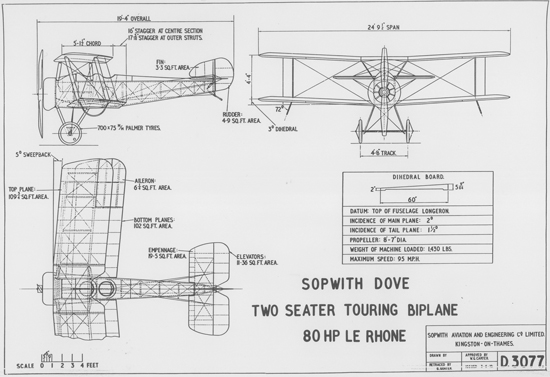
Sopwith now issue the general arrangement drawing of their sporting two-seat ‘Dove’ (above) and a photograph of the second ‘Dove’ in construction in Kingston. It is a long-range single-seat version that they have devised for Bert Hinkler’s intended attempt to fly home to Australia and has a huge L-shaped fuel tank filling the rear cockpit and coming forward under the pilot’s seat. (below)
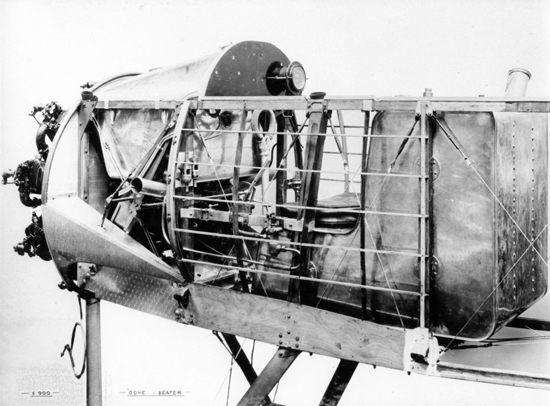
The latest report on experiments at Farnborough to get the ABC Dragonfly Mk II engine running consistently at all altitudes records slow progress owing to bad weather and aircraft repairs. ‘Snipe/Dragon’ B9967 has had a complete overhaul of the petrol system and both petrol tanks repaired. ‘Bulldog’ X4 now has a Clyno-built Mk II Dragonfly, a mechanically driven air pressure pump and modifications to the tailplane but as yet only has two hours flying time. Passing two exhaust pipes through an extended carburettor air intake pipe on the ‘Snipe’ has made a marginal improvement. A combination of an improved Thomson Bennett magneto, heater boxes and reduced spark plug gap also offers some promise but the heater boxes get too hot at low levels and crack. The ‘Snipe’ is to be fitted with a Bosch Magneto and they are about to test the ‘Bulldog’ with ducts directing hot air from four cylinders into the air intake. Meanwhile contractors installing Dragonfly engines in aircraft report difficult starting, magneto failures and cylinder head issues with burned exhaust valves and low compression.
It seems that Grain are going to experiment with overhead arrester wires after all as ‘Pup’ B5940 is reported on 19th April to now be fitted with an over wing hook on the centre section. The film of a successful French test has inspired this experiment with the aim of recovering aircraft flown from the turret ramps of capital ships by hooking back up under wires strung between two booms folded out from the side of the ships.
Just for the Easter weekend, 19th & 20th April, there is a special dispensation permitting civil aircraft to be flown in Britain. These “Victory Easter” joy-rides are mostly in surplus Avro 504s typically 2 guineas a flight or £1 a circuit. Despite the chilly weather there is considerable demand for flights from Southport beach and from several airfields, including Hendon and Hamble, whilst at Cricklewood 600 people take flights eight at a time in three of Handley Page’s rapidly converted O/400 bombers.
Meanwhile this weekend the last US ‘Camel’ squadron in Europe, the 41st Aero Squadron which formed just too late for wartime operations, moves to Hagelar airfield at Koblenz. Their aircraft are marked with a camel stepping through a ‘V’ denoting that they are part of the 5th Pursuit Group of the US Army in Europe. (below)
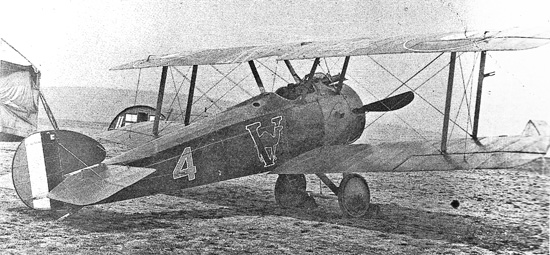
On 20th April, the weather in Newfoundland is promising with a light west wind but later forecasts of storms in mid-Atlantic halt the departure and Harry Hawker busies himself installing a small “boy scout” wireless sending set. The original wireless transmitter has been abandoned after its retractable propeller produced too much power in flight and burned out the generator. Harry is going up to the airfield every day with fresh sandwiches and replenished Thermos flasks to start the engine and check everything is in order for a snap take-off in any break in the weather whilst Mackenzie-Grieve listens-in to wireless weather reports.
On 21st April, an ex-65 Sqdn pilot now with the RAF’s South Western Area Accounting Centre is killed crashing ‘Dolphin’ C8096 from a stall near Beaulieu in Hampshire whilst at Bickendorf 70 Sqdn ‘Snipe’ E8198 has a wheel come off in the air and is wrecked crashing on landing.
On 22nd April, Harry Hawker hears that Fred Raynham is getting ready to start his Atlantic flight and has his machine brought out of the hangar but fog overland and severe sleet storms at sea persist to frustrate their efforts. These old friends and rivals finally agree to give up this cat and mouse game and give each other at least two hours’ notice of setting off to avoid the risks of mistakes in an over-hurried departure. They even consider accompanying each other on the first part of the flight. The teams pose for a press photograph. (below l to r) Kenneth Mackenzie-Grieve, Fred Raynham, Harry Hawker and “Fax” Morgan.
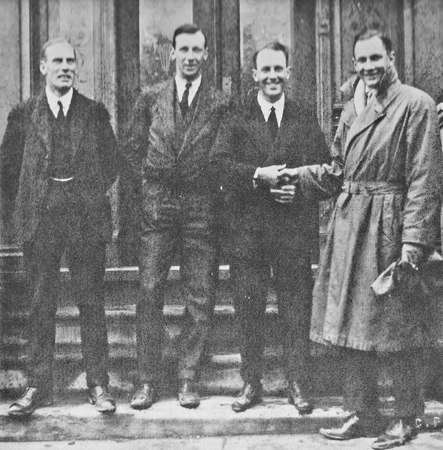
Meanwhile both navigators are honing their wireless skills with a Marconi representative giving daily tests in receiving and maintaining communications between their two airfields eight miles apart.
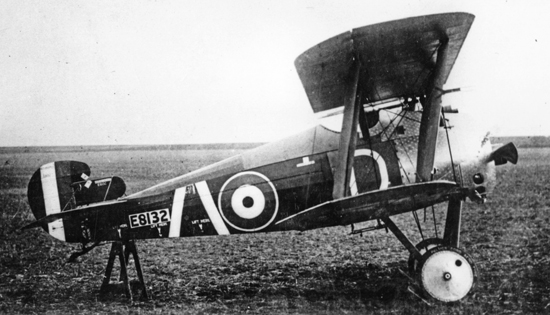
On 24th April, the pilot of 208 Sqdn ‘Snipe’ E8132 (above) is injured crashing at Donstiennes airfield whilst the same squadron’s E7356 is wrecked overturning in a ploughed field in a downwind forced landing.
On 25th April, at Croydon the pilot of 29 Training Squadron ‘Snipe’ E8119 is injured crashing on take-off. Meanwhile 70 Sqdn ‘Snipes’ go out from Bickendorf “flying the flag” on an aerial patrol, a change from their normal target practice, camera gun practice, engine tests, formation flying and other “general flying”.
On 26th April, eight 70 Sqdn ‘Snipe’ are out again on an aerial patrol.
On 28th April, Harry decides to reduces his propeller from four to two blades for slightly better take-off performance and reduced weight at the expense of a little speed on the journey. In his opinion they are “undertaking nothing of a hazardous nature, the only doubtful factor is the weather in mid-Atlantic.”
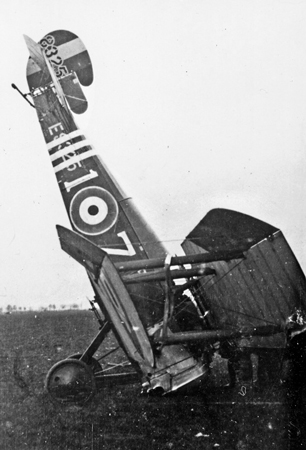
On 29th April, 70 Sqdn ‘Snipe’ E8325 is wrecked crashing in a “bad landing” at Bickendorf. (above) This is one of those built by Portholme Aerodrome Ltd of Huntingdon which have the tail serial number applied by stencil.
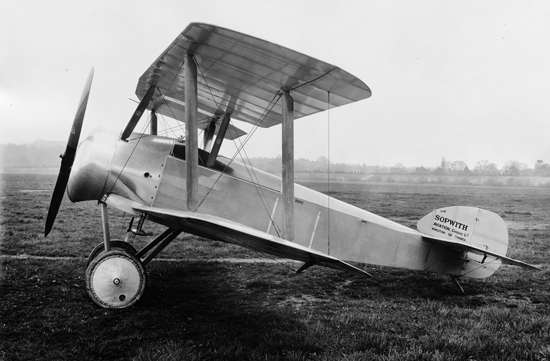
On 30th April, Sopwith’s single-seat long-range Sopwith ’Dove’ is posed for photographs at Brooklands (above and below). The side view showing the sweep back of the wings and the front view into the sun clearly showing the lightweight construction of the top wing.
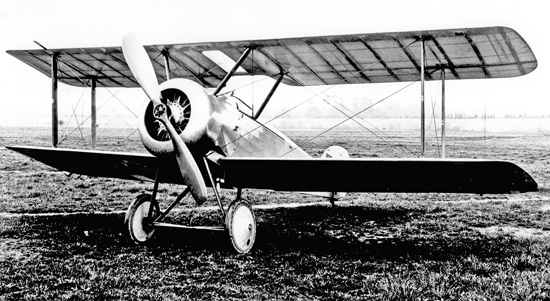
The photograph set continues with images of Bert Hinkler taking this machine up for a test flight. (below)
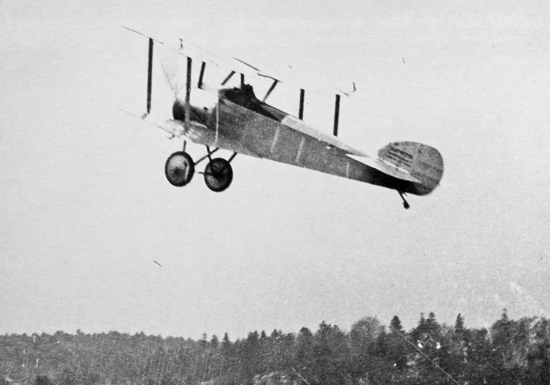
After 137 aircraft delivered in January, 100 in February and 61 in March, the Sopwith factories deliver 68 military aircraft in April with 6 ‘Snipe’ and a record 62 ‘Salamanders’. They have also completed but not yet sold two more civil machines the first ‘Gnu’ and a second ‘Dove’.
The number of new Sopwith aircraft from other contractors after 415 in January, 249 in February and 292 in March is 349 in April. The 349 include 235 ‘Snipe’ from Boulton & Paul (45), Coventry Ordnance Works (14), Napier (25), Nieuport (28), Portholme (17) and a record 106 from Ruston Proctor plus 38 ‘Salamander’, from Bleriot/Air Navigation (28) and Glendower (10). There are 39 new ‘Dolphins’, 17 from Darracq and 22 from Hooper plus 13 ‘Cuckoo’ from Blackburn. There are still 16 new ‘F1 Camels’ delivered despite being officially obsolete, 12 from Marsh Jones & Cribb and the final 4 of 370 from Hooper probably all going straight into store, not fully assembled and without engines. Since British Caudron delivered their 146th ‘Camel’ last month their outstanding orders for 84 have been cancelled. ‘2F1 Ships’ Camels’ are not obsolete and at least 8 more of the remaining 50 on order from Arrol Johnson and Clayton & Shuttleworth have been delivered.
Compared with the “RAF Aircraft on Charge” report dated 31st March, the 30th April report lists 122 fewer ‘F1 Camels’ now 457 and 24 fewer ‘Pups’ now 165. There are still 48 ‘Strutters’ and 9 ‘Strutter Bombers’ listed plus 7 more ‘Dolphins’ now 1,204, 191 more ‘Snipe’ now 1,316 and 97 more ‘Salamander’ now 249. On the list of “Ship Aeroplanes” are still 48 ‘Ships’ Strutters’, 5 ‘Ships’ Pups’ and 7 ‘Baby’ floatplanes plus 17 more ‘2F1 Ships Camels’ now 169 and 12 more ‘Cuckoos’ now 167. The total number of Sopwith machines has reduced by 53 this month to 3,644 amounting to 19.5% of RAF aircraft on charge.
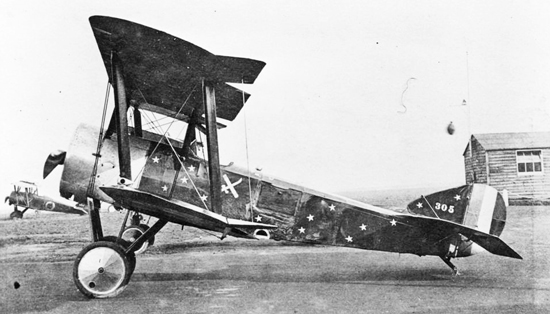
Standard Motors built C305 is an interesting example of a ‘Pup’ still in service. It acquired the star spangled paint scheme (above) with 189 (Night) Training School at Sutton’s Farm before going to 44 HD Sqdn at North Weald.
The Sopwith and Martinsyde teams out in Newfoundland continue to be frustrated by the weather. Through April the average daytime temperature has been only just above freezing. There have been gales, five days with some snow and seventeen with some rain plus two days of fog which rolls in when the wind turns easterly. In the few brief local weather windows mid-Atlantic gales have been forecast. The best time in May could be 12th or 19th with a more or less full moon for the first part of the 19 hour flight but they remain ready every day for an earlier opportunity.
During April there has been an emergency consignment of 15 RAF ‘Camels’ from Malta to the White Russian forces around Astrakhan who are still trying to push the Bolsheviks out of southern Russia.
On 1st May, in their “Flight and the men” series of full-page portraits of key figures in aviation, Flight journal features 31 year old Thomas Sopwith, quoting him as Chairman, Sopwith Aviation and Engineering Co Ltd. This revised company name has now been approved by the Board of Trade.
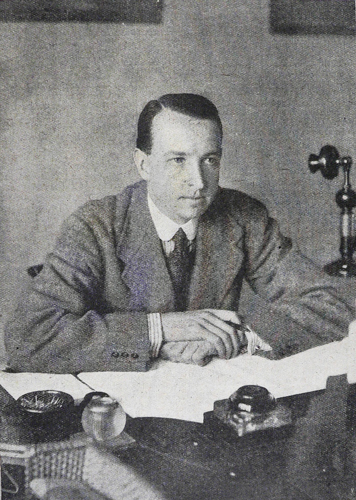
The same day, the ban on civilian flying in Britain is finally removed but subject to pilots being formally licensed and aircraft properly certified for airworthiness and displaying their newly allocated registrations. Sopwith’s enclosed cabin two-passenger ‘Gnu’ is photographed marked K-101, the second aircraft on the British civil register, outside their sheds at Brooklands. (above) Hinkler’s as yet unregistered single-seat ‘Dove’ is overhead and in photographs of him flying over Brooklands. (below again)
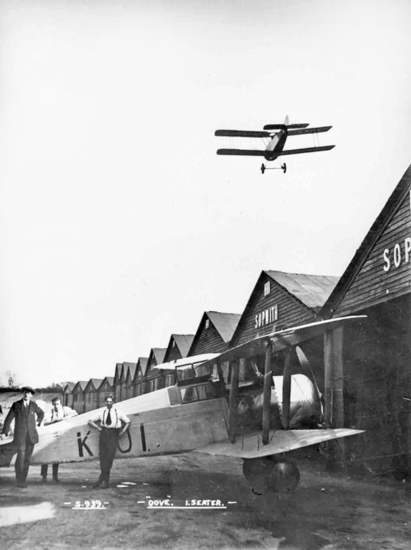
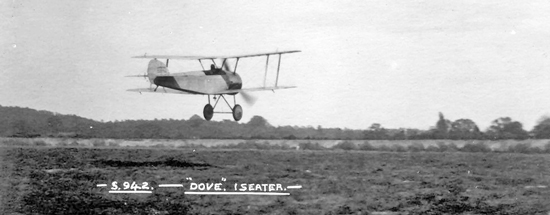
On 2nd May, Bert Hinkler makes a three hour 220 mile flight in the single-seat ‘Dove’ from Brooklands past Brighton and Eastbourne and back in fairly stiff winds and declares himself happy with it. There is even talk of him setting out for Australia later this week but he has yet to find a sponsor.
The huge 4-engined Handley Page ‘V/1500’ Atlantic contender leaves Liverpool by boat for Newfoundland.
All three remaining US Navy four-engined ‘Nancy’ flying boats NC-1, NC-3 & NC-4 have now flown at Rockaway on Long Island and it is announced that their route will be from Trepassey Bay on Newfoundland to Lisbon via the Azores. In marked contrast to the relatively tiny British teams sitting it out in the bad weather, they will be taking this more southerly route supported by nearly 100 ships mostly strung out across the Atlantic at 50 miles intervals to aid navigation providing radio communication, weather reports and emergency response if needed.
On 3rd May, the pilot of 186 Sqdn ‘Cuckoo’ N6927 is killed at Gosport stalling in a slow turn and spinning-in.
On 4th May, Major Tweedie, R A F, lands a Sopwith ‘Camel’ at the Annandale Gymkhana ground in Simla having flown from Amballa in what Flight journal understands to be the first flight in the Himalayas. Meanwhile Alcock and Brown’s team with their crated Vickers Vimy sets out by sea for St John’s Newfoundland.
In the early hours of 5th May, whilst the three US Navy ‘Nancy’ flying boats are being fuelled at Rockaway, a petrol fire damages NC-4’s tail section and NC-1’s wing. They can be repaired but it is another delay.
In Europe the pilot of 41st US Aero Sqdn ‘Camel’ is killed crashing near Treves on a flight from Koblenz.
On 7th May, 27 Training Depot Station ‘Camel’ B5739 is burnt out after stalling and crashing into a building near its base at Crail on the west coast of Scotland whilst the pilot of Joyce Green Pool of Pilots ‘Snipe’ E7991 is injured failing to recover from a spin.
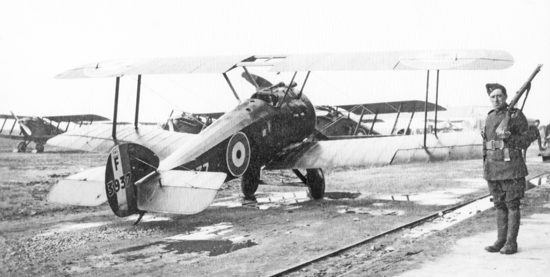
An unusual sight at Bickendorf in front of some ‘Dolphins’ of 79 Sqdn is ‘Camel’ F3937 (above), perhaps an officer’s personal ‘plane, which is currently attached to 79 Sqdn as is ‘Dolphin III’ C8045 (below) with the lower thrust line and right-handed propeller of the ungeared Hispano-Suiza engine. Some ‘Dolphin IIIs’ have been built by Hooper and some converted by units in the field with various shape engine nose pieces.
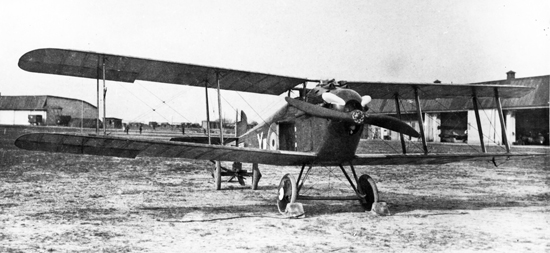
On 8th May the three US Navy ‘Nancy’ flying boats take off from Rockaway, Long Island in a break in the bad weather bound for Halifax and eventually Newfoundland. NC-1 & NC-3 reach Halifax but NC-4 develops trouble with two engines and puts down 80 miles out to sea before taxiing on two engines through the night to reach the naval air base on Cape Cod.
On 9th May, the pilot of ‘Camel’ F8497 of the Grand Fleet School of Aerial Fighting & Gunnery at Leuchars is killed attempting a slow roll too near the ground.
On 10th May, the crated Handley Page ‘V/1500’ four engined trans-Atlantic contender arrives at St John’s for the onward 80 mile rail journey to Harbour Grace.
At Hounslow on 10th May, Canadian Major William Barker VC DSO (below on right) with 46 victories in ‘Camel’ B6313 and 4 in ‘Snipe’ E8102 and his arm still in a sling from his final combat injuries, flies the Sopwith two-seat ‘Dove’ in the presence of Thomas Sopwith. (on left) It is no surprise that Barker is taking an interest in Sopwith’s ‘Dove’ as he is entering into a partnership in civil aviation with the other Canadian VC fighter pilot Billy Bishop. 25 year old Edward, Prince of Wales, (below in centre) who happens to be visiting Hounslow asks to be taken for a flight over London where Barker “executes many stunts much to the liking of the Prince”.
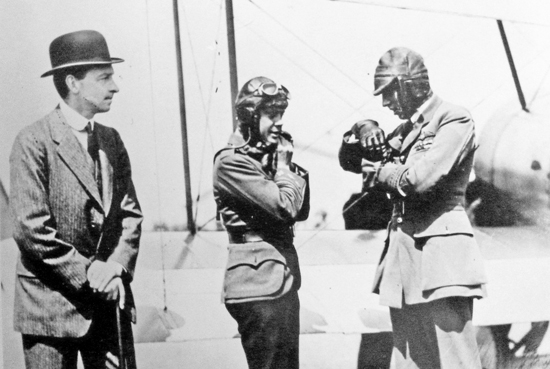
The Commonwealth Government of Australia, in consultation with the Royal Aero Club, now publishes the conditions for the proposed flights from Great Britain to Australia for their prize of £10,000. The pilots and crew must be of Australian nationality and the aeroplanes or seaplanes must be entirely constructed within the British Empire although raw material may be obtained from outside sources. The same machine must be used throughout, individual replacements and repairs may be made but five parts of the aircraft and five parts of each motor will be stamped or otherwise marked and at least two marked parts of each of these five must be in place on arrival at the controls and at the finish. The route of between 12,000 and 14,000 miles will start from Hounslow Aerodrome or Calshot Seaplane Station and finish at Port Darwin in the extreme north of Australia. It must include the check points at Alexandria and Singapore and must be covered inside 720 consecutive hours. Flights will take place under the competition rules of the Royal Aero Club who will supervise the start and control the competition. Entries must be accompanied by a fee of £100 towards expenses. Entries have already been received from Bert Hinkler in the 80 h.p. Le Rhone engined Sopwith ‘Dove’ and Lieuts. Kingsford Smith & Rendle in a Blackburn ‘Kangaroo’ with two 250 h.p. Rolls-Royce Falcon engines.
On 11th May, after waiting for replacement cracked propellers and better weather, the two US Navy ‘Nancy’ flying boats fly from Halifax to Trepassey Bay in Newfoundland. NC-1 gets there in 7 hours and NC-3, after initial engine and propeller problems, gets there in 5½ hours with a tailwind. The sea is strewn with ice blocks and the landings on whitecaps in the narrow inlet in gusting 40kt winds are difficult.
In Kingston on 12th May, Harry Kauper marries Miss Beatrice Hooper. Kauper came to England with Harry Hawker in 1912 when both joined Sopwith. He later became Works Manager before joining the RAF and is recorded as the inventor of the patented Sopwith-Kauper gun synchronising gear. He has been asked by the Australian Government to advise on aircraft production and leaves this week for Australia with his new bride.
On 12th May, the Handley Page ‘V/1500’ four engined trans-Atlantic contender arrives by rail from St John’s at the little town of Harbour Grace on Conception Bay. Their airstrip started as a series of gardens and farms with brick walls between them which have been removed by gangs of men together with three houses, a farm building and a barracks. Attempts to flatten hummocks with a horse drawn heavy roller have left “a bumpy aerodrome”. Mechanics and riggers boarded in local homes are erecting a 50ft high scaffold with blocks and tackles to lift the wings and engines onto the fuselage.
Council outrage at the change to permanent status of the National Aircraft Factory at Ham continues with the Clerk of Surrey County Council responding to the latest letter from the Ministry Director General of Lands to formally record this “breach of faith”.
On 13th May, prototype Sopwith ‘Buffalo’ H5893 arrives at Marquise on route to 43Sqdn at Bickendorf for service trials despite there being no declared Royal Air Force requirement for a two-seat armoured fighter.
At night on 13th May, the Vickers ‘Vimy’ team arrives at St John’s and crew Alcock and Brown find rooms in the Cochrane Hotel where Hawker and Raynham are still impatiently awaiting acceptable weather. They have two weeks to find a 500-yd clear-run field before the ‘Vimy’ arrives.
On 14th May, with the Peace Conference in Paris finally drawing to a conclusion the last American ‘Camel’ squadron in Europe, 41st US Aero, moves from Koblenz to Colombey-les-Belles for demobilisation.
“Nancy” flying boat NC-4 finally leaves Cape Cod for Halifax and the following morning, 15th May, leaves there for Trepassey on Newfoundland with concerns that it will be too late to join the other two in their imminent Atlantic crossing attempt. The third Trans-Atlantic contender to be eliminated before even getting to its start point is the twin Napier Lion engined Boulton & Paul ‘Atlantic’ which has crashed taking-off on a test flight when an engine cuts out. The single Napier Lion powered Alliance Aeroplane Co P2 ‘Seabird’ with its entirely enclosed crew compartment has now been completed at their large factory on the pre-war Acton Aviation Grounds in West London where they are completing an order for 334 DH9s.
On 15th May, the pilot of 78 Sqdn Sutton’s Farm ‘Snipe’ E8139 is killed spinning-in.
In Newfoundland, on 15th May on a cricket pitch at St John’s US Navy airship C-5 arrives (below left) having completed a record 25 hours 50 minutes 1,177 miles non-stop overnight flight from New York. Tied down with earth anchors the ground crew organise refuelling and topping up the hydrogen in this 192ft long twin-engined machine which cruises at 55mph. (below)
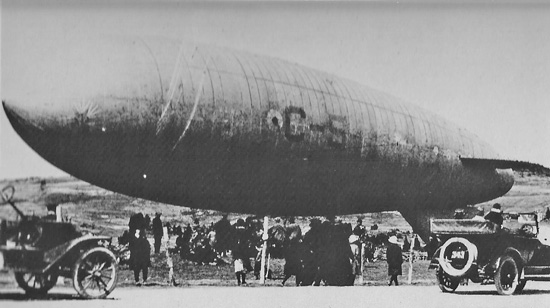
The wind picks up and 100 sailors struggle to control the swaying airship with help from the large crowd. When gusts reach 60mph the rip panel cord is pulled to deflate the airship but the cord breaks as do two steel mooring cables. As it is wildly blown away, the two ground crew in the control car jump out from 30 ft and are slightly injured before it soars up and then crashes down breaking away the control car and then, now even lighter, “dipsy-doodles” out to sea in the gusting winds. Harry Hawker is reported to find this “damn funny”. “They flew it all the way from New York and now it is on its way to Ireland without a soul on board”.
At around 5pm, 65 miles away in Trepassey Bay, US Navy ‘Nancy’ flying boats NC-1 and NC-3 are making unsuccessful attempts to take off in high winds and heavy seas which drench the crews and threaten to damage the aircraft before NC-4 finally appears overhead and the decision is made to abandon today’s departure attempts with the hope that all three can leave in better weather tomorrow.
On 16th May, the three ‘Nancy’ flying boats are re-provisioned as the weather at Trepassey gradually improves and forecasts from their string of support ships out in the Atlantic are favourable. NC-3 taxies but refuses to leave the choppy water, NC-4 gets away and flies around overhead but NC-1 also fails to fly. NC-4 lands whilst the crew of NC-3 rip out heavy floor planks as it taxies miles back to a launch to offload an engine mechanic, the emergency radio transmitter, tools, drums of spare oil and radiator water.
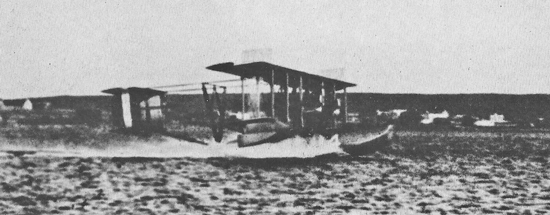
At 6pm, NC-3 manages to take-off (above) and within ten minutes all three are on their way to the Azores. In the morning NC-1 gets lost in the thickening fog and they decide to land to avoid hitting the mountains of the Azores but there are 12ft waves. NC-1 badly damaged the crew are lucky to eventually be rescued by a small tramp ship. NC-3’s crew after 15 hours in the air also decide to land at sea to get their bearings and suffer worse damage than NC-1 and they struggle to keep the machine afloat all day and through the next night. NC-4’s crew eventually get a glimpse of shallow water through a gap in the fog and land in a bay on the first island not risking the last 180 miles to Sao Miguel.
Having been ready for so long on Newfoundland, Hawker and Raynham’s teams study the weather forecasts and prepare their aircraft even more carefully than usual in the hope that they will be able to get away later today. By noon the local weather is good and the Atlantic forecast “not yet favourable but possible”. With the moon well on the wane and determined not to let the Americans be first across, both British teams decide to make their attempt.
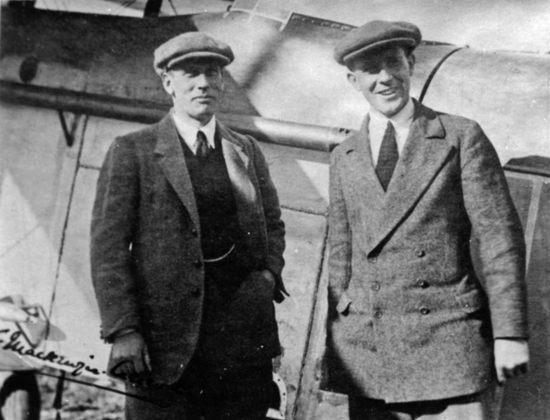
Photographed alongside their Sopwith ‘Atlantic’ in their everyday suits and ties over heavy woollen undergarments, (left) Kenneth Mackenzie-Grieve and Harry Hawker each add two jerseys and then the bulky immersion suit before settling into the open double cockpit (below) with maps and navigation equipment, flares and smoke bombs, the mailbag including a letter to the King from the Governor of Newfoundland, sandwiches and hot drink flasks plus dates, chocolates and brandy sufficient for three days in an emergency.
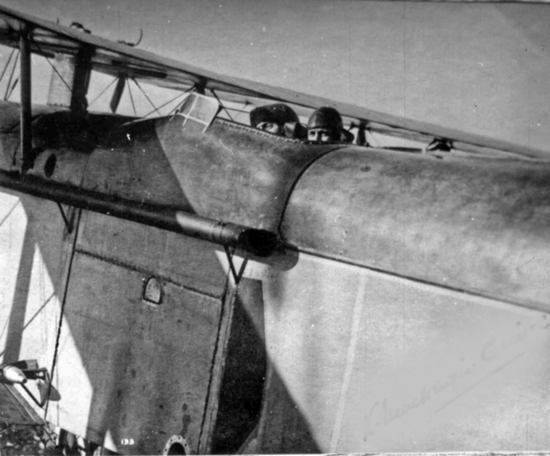
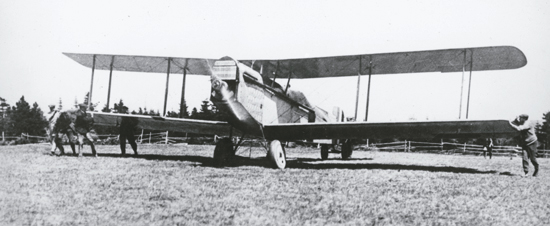
At 3.15pm (5.51pm GMT), with undercarriage spread to the extreme, Harry Hawker waves the chocks away (above) having instructing the ground crew to “tell Raynham I’ll greet him at Brooklands”. To compensate for the wind, direction Harry lines up diagonally on the field. With the cheers of the spectators drowned by the noise of the engine they gather speed bumping for 300 yards over the uneven ground before striking a hummock and lifting-off to just clear the fence at the lower end of the field. Within 3 minutes climbing steadily they reach St John’s, passing over Quidi Vidi to see Raynham’s aircraft surrounded by a large crowd and are delighted to have “got the bulge on him”. At 1,500 ft, Harry jettisons the undercarriage into the sea reducing the wind resistance and the weight by 450lbs. Another 5 minutes and they are at 4,000ft out of sight of those watching and managing to climb above the fog banks.
At Quidi Vidi, Raynham has to attempt a take-off with a partial tailwind. After 300 yards the Martinsyde Raymor is still down but hits a bump, rises steeply and plummets 100ft buckling the undercarriage before running into soft ground at the end of the field and tipping forward. Fred Raynham is winded and bruised (below right) but his bnavigator Fax Morgan has taken a terrific blow to his face.
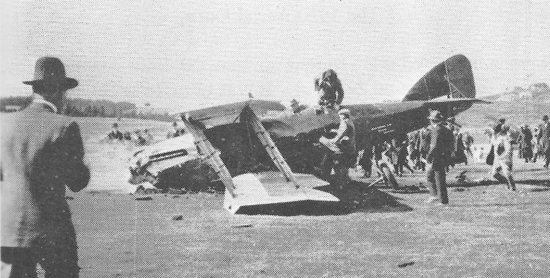
For the first 4½ hours aboard the Sopwith ‘Atlantic’, Mackenzie-Grieve is able to take sextant shots. When he estimates they have reached the shipping lane Hawker steers 73˚ to follow it. The weather worsens, heavy cloud banks reduce visibility before rain squalls and strong northerly winds. It is bitterly cold at 10,000ft in the dark and Mackenzie-Grieve gets slight frostbite in his fingers several times taking off his gloves to stop the cane ring holding open the collar of Hawker’s immersion suit from rising up and strangling him. After 5 hours Hawker is very concerned when the temperature of the radiator water rises rapidly and it remains constantly high for the next two hours. When Mackenzie-Grieve finally gets a fix on the waves in a gap in the cloud to assess their drift he realises the unexpectedly strong northerly strong winds must have taken them some 150 miles south of their planned course. Hawker decides that some foreign matter must be clogging a filter in the engine’s cooling lines, switches off the engine and dives steeply to dislodge it and that appears to work for a time. 800 miles out from St John’s the overheating starts again, is not corrected by an engine-off dive and gets further overheated climbing to 15,000ft to avoid high clouds despite being throttled back somewhat. Hour after hour Hawker nurses the plane to keep the water temperature below boiling before they are confronted by a vast unavoidable cloud bank. Throttled further back going down at 6,000ft through black cloud does not help the water temperature and Hawker decides to make another engine-off dive. Now at just 1,000ft, the engine does not restart despite Mackenzie-Grieve desperately hand pumping the fuel. They are descending steeply and can see the ocean from perhaps 100ft when the engine fires and Hawker gives it “a good mouthful of throttle”. It is the closest of shaves. They are over half way to Ireland 950 miles out from Newfoundland but agree there is no sense in trying to go on. They start searching for a rescue ship by zigzagging at less than 1,000ft diagonally back and forth across what they believe is the shipping lane. Buffeted by the rain squalls for another 2½ hours, Hawker is airsick whilst his navigator sends out SOS calls every 15 minutes but the range is limited by their low altitude. Suddenly, around 7am on 19th May, Hawker spots a small tramp ship through the fog and low cloud, fires three flares, flies low alongside to ensure they have been spotted and lands some two miles ahead. They release their life boat from the top of the fuselage and it rides the waves well but compounds Hawker’s nausea. After a difficult 1½ hours battered by up to 12ft waves, a boat from the small slow Danish ship “Mary” manages to throw a line to Hawker and Mackenzie-Grieve. They are rescued and taken aboard the “Mary” which is on a 28 days voyage carrying cotton-seed cake from New Orleans to Denmark. During the rescue the aircraft floats well despite losing the trailing edge of a wing in a huge wave and getting spun around like a cork. Half an hour after they are rescued a full gale is raging. They have lost their belongings, boots and caps and it is impossible to try to salvage the aircraft. The “Mary” is hardly making headway in the storm and has no radio. There is no way to tell the world they are safe. Given warm clothes they go to bed too sick to eat.
That afternoon, Harry Hawker’s wife Muriel goes to Brooklands to greet him after putting out the welcome flags at their home at Hook three miles south of Kingston upon Thames. Despondent back at home later that evening she gets a report from the Admiralty that her husband has landed 40 miles off the mouth of the Shannon River.
The next morning, 20th May, the Daily Mail is delivered with the headline “Hawker Missing – False Reports of Fall in the Sea”. After the initial shock Muriel decides to cling firmly to the belief that he is alive remembering some of his last words to her when he left nine weeks ago – “If things don’t go quite right, never give up hope”. Her brother and Mrs Sopwith support her and, with baby Pamela in good care, they go to the Admiralty for news.
In the Azores, the weather is just good enough for NC-4 to fly 180 miles across to Ponta Delgada on Sao Miguel.
Over Yorkshire unmanned Camel H7363 with its engine running is slipped from under airship R33 and nosedives 1,500 ft into the ground to test its Imber mainly rubber self-sealing fuel tanks for Farnborough. There is no fire.
By 21st May, concern for Harry Hawker and Kenneth Mackenzie-Grieve has turned into reports that there is faint hope for their rescue and public indignation grows that the Admiralty have not despatched a sizeable search force. Few people are optimistic, one exception is Muriel
On 22nd May, Muriel Hawker’s visit to the Admiralty brings no further news of Harry Hawker and Kenneth Mackenzie-Grieve.
On 23rd May, there is still no news in London but at 2pm in mid-Atlantic the Sopwith machine is spotted from SS Lake Charlotteville now floating tail high.(below) They search in vain for survivors before hauling the wreck out of the water.
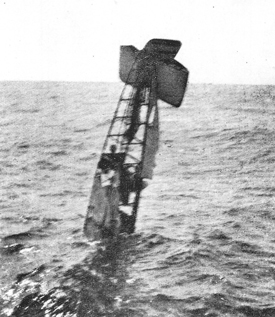
On 24th May, after six days without news, the King has a telegram sent to Muriel Hawker with his “deep sympathy in your sudden and tragic sorrow” but Muriel remains certain that Harry is alive. Lord Northcliffe of the Daily Mail announces that if they do not return, the £10,000 prize money will be divided between Muriel Hawker and the Mackenzie-Grieve family whilst the offer of the £10,000 prize for the first successful Atlantic flight will still stand.
Just after 10am on Sunday 25th May, the coastguard on the most northerly point of the Outer Hebrides hearing sirens from a small ship reads the successive messages from her signalling flags M-A-R-Y, S-A-V-E-D-H-A-N-D-S, S-O-P A-E-R-O-P-L-A-N-E. The Coastguard responds IS-IT-HAWKER and gets back Y-E-S. The fast destroyer HMS Woolston is sent out from Scapa Flow to collect the rescued pair. Within an hour Muriel gets a call from the Daily Mirror telling her the news. Neighbours put out flags, the ‘phone does not stop ringing, telegraph boys bring messages and cars arrive with reporters seeking interviews. As soon as possible Muriel goes to see the Sigrists at their bungalow on Long Ditton Island where she has been staying and Fred celebrates by jumping into the Thames fully clothed. During the day special editions of newspapers are rapidly prepared and placards appear on the streets “Hawker Saved. Special” “All Britain went wild” with the sense of relief. After a Thanksgiving Service at Hook Church, a party of thirty including the Sigrists and Sopwiths speed into London for dinner at the Piccadilly Hotel. By now, Hawker and MacKenzie-Grieve are aboard HMS Revenge, the flagship of the Home Fleet.
On 26th May, they are put ashore at Thurso for lunch with the Provost before being met at every station down the line by cheering crowds wanting to shake hands, some offering bouquets. Arriving at Inverness to the sound of a ship’s siren and a speech by the Provost, Harry unassuming as ever replies that he is embarrassed, “The risk I ran was not so great as people think it was, not at all an attempt of the do or die order”. After supper with the Provost they entrain for Edinburgh and London. During the day Muriel has received two new telegrams from Buckingham Palace. “The King rejoices with you and the nation on the happy rescue of your gallant husband. He trusts that he may long be spared for you”. The second is from the King’s Danish mother Queen Alexandra concluding “I rejoice that a Danish ship rescued his precious life”.
At 5am on 27th May, the adventurers are greeted by a crowd of thousands at Perth and at Edinburgh the crowd break the police cordon to carry Harry shoulder high into the Station Hotel for breakfast. Met by more crowds and the Lord Mayor at Newcastle, Harry says he is deeply touched by the respect and welcome shown to him and the kindness and sympathy displayed towards Muriel over the last week. “I am not discouraged in the least by what has taken place and I have not abandoned the idea of crossing the Atlantic.” MacKenzie-Grieve agrees with Hawker, “Next time we ought to succeed but if somebody gets in before us we can only say “Good luck to you”. After crowds at Darlington, at York there are more dignitaries and telegrams including a Royal Command to Buckingham Palace. Meanwhile Muriel and others have been travelling up to meet them at Grantham. After a brief private meeting the Hawkers are photographed (below) with Mackenzie-Grieve and Sopwith before re-joining the train.
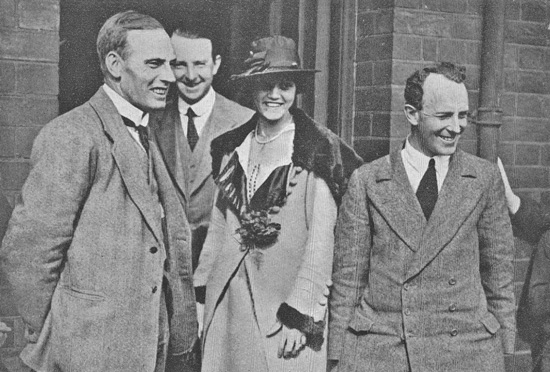
The huge crowds at King’s Cross lift the adventurers out of the train and into Harry’s big Sunbeam car which 300 or so Australian soldiers try to carry. Harry abandons the car and crawls over the heads of the crowd to be rescued by a policeman on horseback before getting a horse of his own to arrive at the Royal Aero Club in triumph. (below)
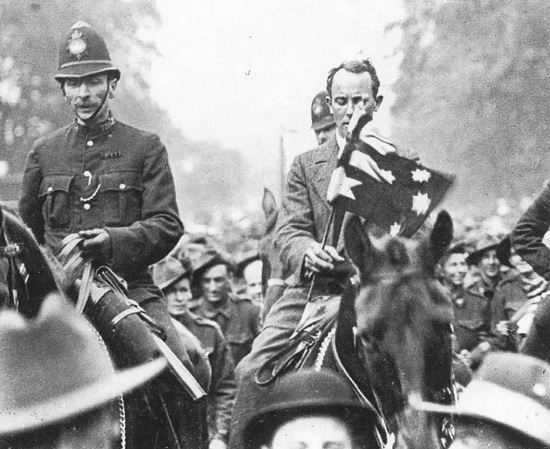
The crowds are so great they have to escape by a side door to drive to the grounds of Sopwith’s Ham factory, where the company is holding a special entertainment celebration. From there the car is towed at a run by Sopwith employees into Kingston for a supper given to all and sundry by Mr and Mrs Sopwith. It is midnight before the Hawkers arrive home at Hook to be greeted by another crowd, and “a wonderful display of fireworks”. Their house has the flags put out by Muriel for Harry’s expected return back on 19th May and now more flags with a large “Welcome Home!” sign strung by neighbours across the main road.
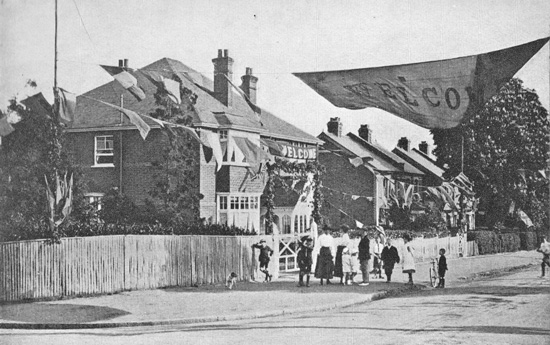
Meanwhile on 27th May, after a 9½hrs 890 miles flight from the Azores, the US Navy flying boat NC-4 lands in the harbour at Lisbon, Portugal (below) to a 21 gun salute, completing the first crossing of the Atlantic Ocean to Europe by air, albeit over eleven days.
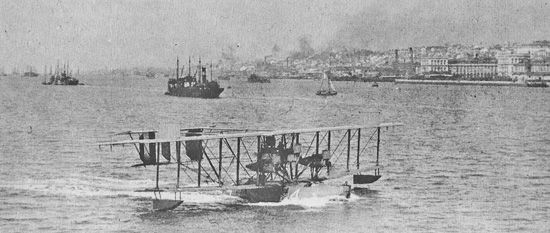
At 10.30am on 28th May, Harry Hawker in a morning coat and silk hat accompanied by Kenneth MacKenzie-Grieve in his naval uniform arrive at Buckingham palace in a Rolls Royce for an audience with the King, Queen and Prince Albert all keen to hear first-hand about their adventure. They are each awarded the Air Force Cross despite Harry never having been in the military. Large crowds cheer them as they leave (right) for a Daily Mail luncheon at the Savoy Hotel with speeches by leading figures in aviation and humble responses by the adventurers. They are presented with a £5,000 cheque from the Daily Mail as a consolation prize “in recognition of the plucky attempt to win the prize itself and by way of appreciation of the endeavour to uphold the honour of Britain”.
At 4pm, the SS Lake Charlotteville arrives in Falmouth with the remains of the Sopwith ‘Atlantic’ on deck. (above) It has sustained further damage being winched aboard and again in storms when the sea swept over it on the deck.
Meanwhile on 28th May, ‘Snipe’ F2378 is wrecked on a travelling flight as 208 Sqdn relocates from Strée to their new base at Heumar whilst 80 Sqdn, which has also been supporting the Army of Occupation at Strée, has packed its ‘Snipe’ and travelled to Marseilles where they are embarking for active service at Aboukir in Egypt.
Canadian 45 Sqdn ace Cpt Mansell James having been refused permission to take his own 8 victory ‘Camel’ D8211 back to Canada has managed to purchase two war surplus ‘Camels’ from the Air Ministry with support from his brother and a cousin, both ex-RAF. On 28th May, he is photographed in F5235 at the Atlantic City Air Meeting (below) before flying 340 miles to Boston in 4hrs 7mins including a 40mins stop. He takes three prizes amounting to $7,000 repaying in one flight most of the gratuity money the three have staked on the enterprise.
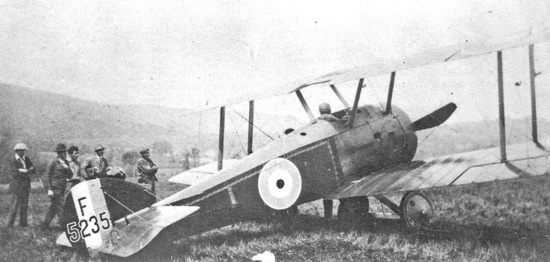
On 29th May, Cpt Mansell James goes missing flying back to Atlantic City and cannot be found.
In the last week, prototype Sopwith ‘Buffalo’ two-seat armoured contact-patrol fighter H5893 is crashed by a ferry pilot on arrival at Bickendorf (below) delaying service trials of this type with 43 & 70 Squadrons.
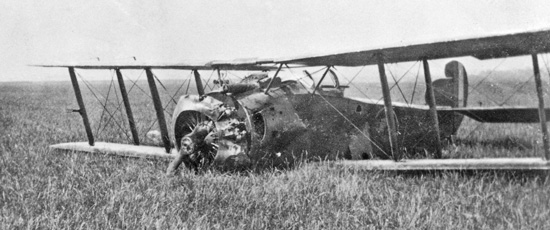
At the Aboukir Training Depot Station in Egypt ‘Camel’ H760 has been struck off charge after being overturned. (below)
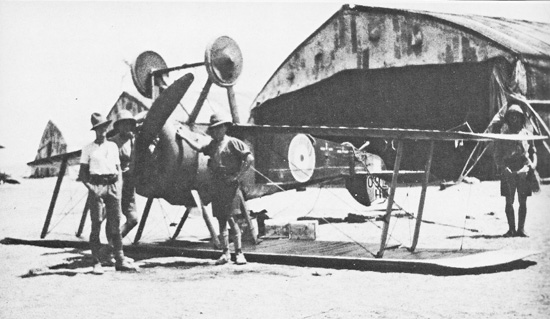
The latest issue of the ‘Flight’ has a detailed map of the Sopwith ‘Atlantic’ flight and rescue (below) and is covering all these events with photographs and quotes from the speeches. The map also shows the US Navy flying boat NC-4 route and the remaining distance from Lisbon to Plymouth.
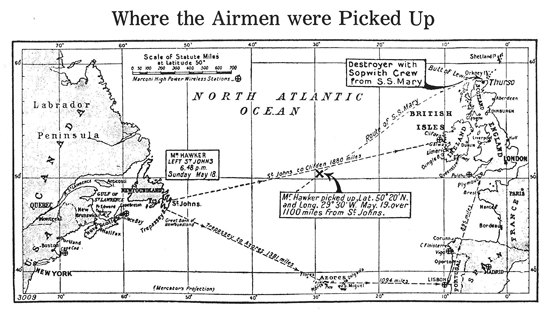
At dawn on 30th May, after three days in Lisbon the US Navy flying boat NC-4 leaves for Plymouth but has to land for repairs and only reaches Ferrol in northern Spain befor an overnight stop. In London, Muriel and Harry Hawker with Kenneth MacKenzie-Grieve are received by Queen Alexandra who is especially interested in the rescue by the Danish ship. They go on to a Royal Aero Club luncheon at the Savoy with more congratulatory speeches including one by Thomas Sopwith who reveals that the adventurers had originally agreed to share the Daily Mail prize 70/30 if they won it but Harry has insisted that the consolation prize is shared 50/50 as they had suffered equal risks.
Meanwhile representatives of Sopwith, the Daily Mail and Selfridges have travelled by train to Falmouth to secure the purchase of the ‘Atlantic’ aircraft with the receiver of wrecks. It is trans-shipped from the SS Lake Charlotteville and brought ashore to be taken to London to be displayed on the roof of Selfridges department store in Oxford Street. The Sopwith ‘Atlantic’s’ jettisoned undercarriage carried by the strong currents some 60 miles around the Newfoundland coast has been picked up by a fisherman and taken to St John’s.
In the last four days, the Vickers ‘Vimy’ has arrived at St John’s and with great difficulty brought a mile up the narrow streets to Raynham’s airfield at Quidi Vidi where the thirteen man team are re-assembling it behind canvas screens in the cold raw weather working ten or twelve hours a day. Today they have the engines mounted (below) and are starting on the wings whilst the search continues for a long enough field for a fully loaded take-off. The Vickers team have already caught up with Handley Page ‘V/1500’ team 60 miles away at Harbour Grace who had a two week advantage but have been frustrated by bad weather.
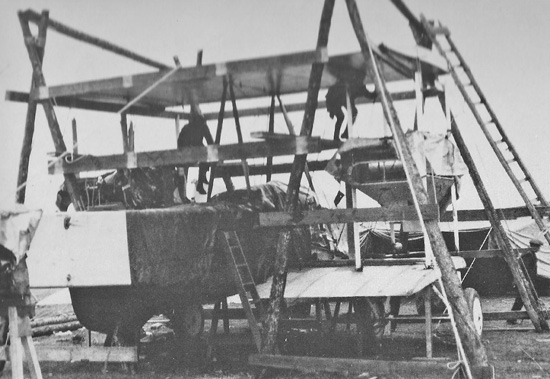
On 31st May the US Navy flying boat NC-4 leaves northern Spain and accompanied by three RAF Felixstowe flying boats across the Channel lands at Plymouth to be greeted by ships’ sirens, a large crowd, the crews of the other two unsuccessful Nancy flying boats before an official reception at the Grand Hotel.
The flying display at Hendon on 31st May, is held in honour of Hawker and MacKenzie-Grieve. (below)
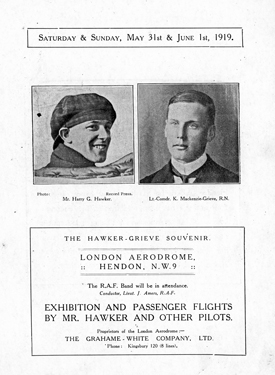
To everyone’s surprise Harry flies in from Brooklands in 200hp Bentley-engined ‘Gnu’ K101 with his wife as a passenger in formation with the second ‘Gnu’ K136 and the Sopwith ‘Scooter’ monoplane now registered K135. Seats for flights with Harry are auctioned for charity by Hendon proprietor Claude Graham-White, the first going to a Miss Daisy King of Leeds for 60 guineas. With half of the glazed roof hinged back, she is helped down from the wheeled access steps into the cabin by Harry and Fred Sigrist. Her flight is photographed air-to-air from a ‘DH9’ (below)
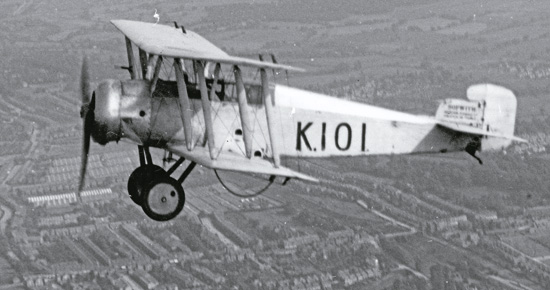
Also giving joyrides is ‘Gnu’ K136 which has “Sopwith” emblazoned pre-war style on the fuselage and a smaller diameter 110hp Le Rhône engine. (below)
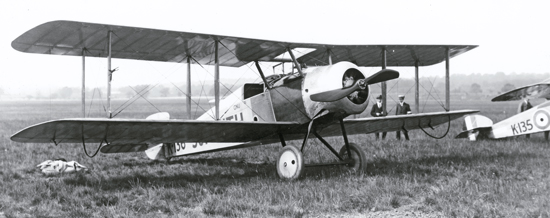
Alongside it is the 130hp Clerget ‘Scooter’ K135 in which Harry Hawker performs a spirited solo display later in the afternoon. (below)
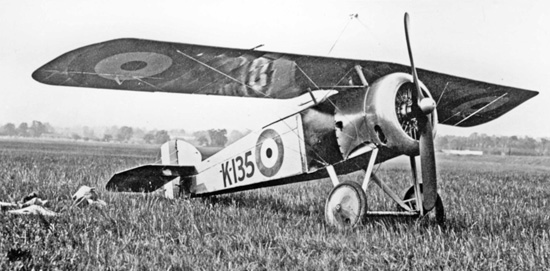
On Sunday 1st June, Harry Hawker and Muriel greet the crew of US Navy flying boat NC-4 at Paddington. Despite the officials and a guard of marines they are grabbed by American troops and taken shoulder high to Harry’s car who drives them to the Royal Aero Club for another reception. Meanwhile at Hendon the two ‘Gnus’ have been giving more joyrides. By the time the American crews arrive to great acclaim from the crowd Harry is up in the ‘Scooter’ giving an impeccable display of loops, spins and rolls engaging in a mock dog-fight with a ‘DH9’. He is photographed with NC4’s Commander Read. (below)
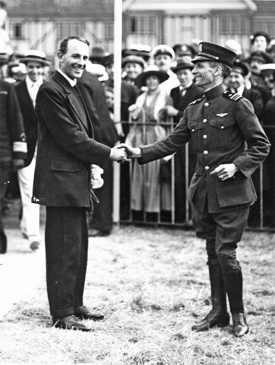
Whilst in London, on 1st June, Harry and Muriel visit the roof of Selfridges department store to see his recovered Sopwith ‘Atlantic’ finding it much more badly damaged than when he last saw it floating in the mid-Atlantic. He does not find any evidence of the blocked radiator water filter creating speculation about the possibility of a water leak having developed or even a reverse connected radiator shutter control but the latter is unlikely as they had flown for 5 hours before the overheating started. The machine will be on show to the public from 2nd June and Selfridges are selling postcard mementos. (below)
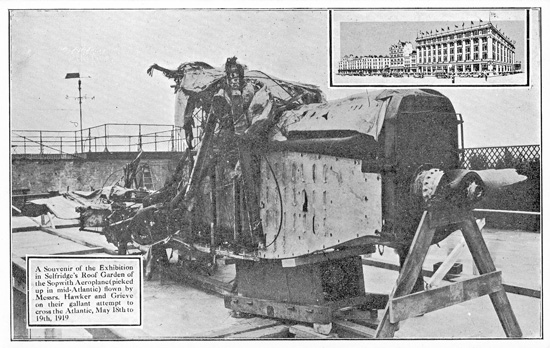
After 137 aircraft delivered in January, 100 in February, 61 in March and 68 in April, the Sopwith factories deliver 92 military aircraft in May completing 40 ‘Salamanders’ and their last 52 of their 556 ‘Snipe’ whilst the first prototype Sopwith ‘Snapper’ F7031, completed engineless last September, has finally made a first flight at Brooklands with one of the few flight-cleared ABC Dragonfly engines. Sopwith have also completed but not yet sold the second ‘Gnu’ K136 and are building at least four others alongside more ‘Doves’. The prototype ‘Dove’ two-seater is now registered as K122 and has a certificate of airworthiness. Another ‘Dove’ registered as K133 is possibly Hinkler’s unmarked single-seater but more likely a second two-seater.
The number of new Sopwith aircraft from other contractors after 415 in January, 249 in February, 304 in March and 341 in April has fallen to around 229 in May. The 229 comprise 126 ‘Snipe’ from Boulton & Paul (36), Coventry Ordnance Works (18), Napier (30), Portholme (12) and Ruston Proctor (20) plus the first 9 from Kingsbury Aviation and the last one from Nieuport. There are 35 ‘Salamander’ from Bleriot/Air Navigation (16) and Glendower(17) plus the first 2 from Palladium Autocars and 23 new ‘Dolphins’ from Hooper plus a final one from Darracq. There are another 5 ‘F1 Camels’ delivered by March Jones & Cribb despite officially being obsolete whilst it appears that Arrol-Johnson have started to deliver the final 50 ‘2F1 Ships Camels’ on contract from Beardmore possibly 8 last month and 21 this month whilst Blackburn have completed around 18 ‘Cuckoos’.
On 2nd June, the Sopwith Board Meeting seals an agreement confirming Herbert Larkin as the sole agent in Australia for the sale of Sopwith aircraft and spare parts trading as the Larkin-Sopwith Aviation Company of Australia which is being registered in London this week. Cpt Herbert Larkin scored 11 victories in Sopwith ‘Dolphins’ C4173 & C8163 from June to September 1918 when he commanded ‘A’ Flight of 87 Squadron in France.
On 4th June, Fairey Aviation announces that since its test pilot Sydney Pickles withdrew from their trans-Atlantic challenge they already have more than enough offers from potential replacement pilots and the Fairey ‘IIIH’ dubbed ‘Threelantic’ is ready to be crated for shipping to Newfoundland.
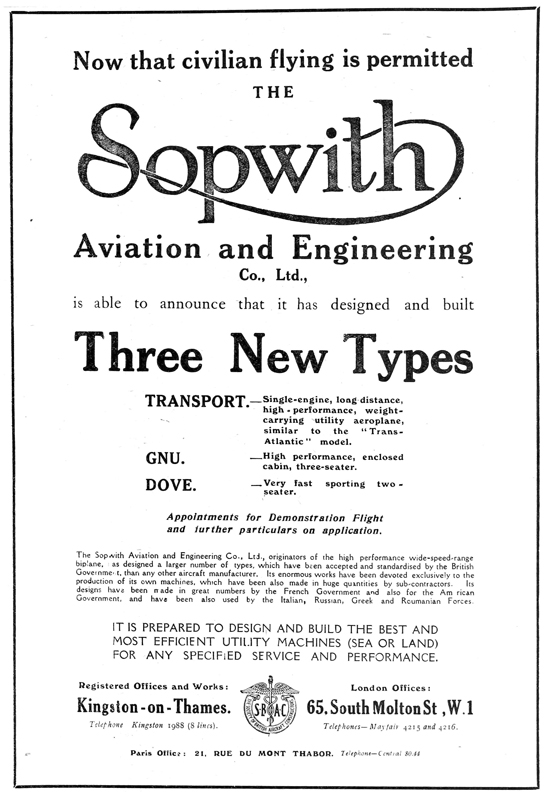
“Now that civilian flying is permitted”, Sopwith are advertising three civil types revealing the ‘Atlantic’ to be the precursor of a standard “long distance, high-performance, weight-carrying utility transport model”. (above)
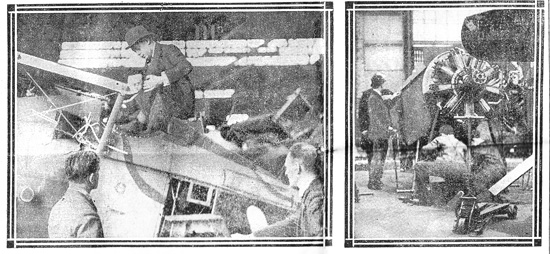
On 5th June, HRH the Prince of Wales drives to Kingston to inspect the Sopwith Aviation works.(above) He is received by Mr. T. O. M. Sopwith, Mr. R. O. Carey and Mr. H. P. Musgrave with factory superintendent Mr. L. Fowler and works manager Mr. H. Mitchell. Entering the works he is greeted by a hammer chorus. He sees the processes for making armoured plating for ‘Salamanders’ before visiting the experimental workshops. The Prince then drives to the factory at Ham to see the assembly of ‘Salamanders’ and ‘Dragons’ and climbs into the pilot’s seat of a ‘Salamander’ (Daily Sketch photos below) and Mr. Sopwith explains its details.
‘Snipe’ production at Sopwith’s Ham factory has now switched entirely to the ABC Dragonfly-engined ‘Dragon’ version alongside the ‘Salamanders’ which are still Bentley BR2 powered. On 7th June, the first production Sopwith ‘Dragon’ F7001 makes a first flight at Brooklands with one of the few flight-cleared ABC Dragonfly radial engines. Meanwhile, the Grand Fleet School of Aerial Fighting and Gunnery at Leuchars get their first 3 ‘Snipe’ E6864 to E6866 to add to their ‘Strutters’, ‘Ships’ Strutters’, ‘Camels’ and ‘Ships’ Camels’.
The Children’s Newspaper explains the news of the flight and rescue with several articles and a family photograph of Harry, Muriel and little Pamela (below)
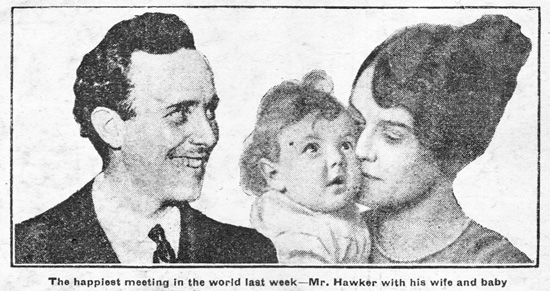
On 8th June, the four engined Handley Page ‘V/1500’ is finally assembled and Rear Admiral Kerr and his three man crew make a brief handling flight from their long but bumpy field at Harbour Grace now cleared of walls and rocks.
By 9th June, the Vickers ‘Vimy’ is also now ready but they discover that their fuel is contaminated. Rainham loans them enough for Jack Alcock to fly the lightly loaded ‘Vimy’ from Martinsyde’s short field at Quidi Vidi to the longer Lester’s field to the north west. Lester’s field has only recently been found but in three days gangs of men have filled a drainage ditch and cleared the trees, a stone wall and many large boulders, some requiring dynamite.
On 10th June, ‘Buffalo’ armoured two-seat fighter H5892 is collected from Marquise by an experienced 43 Sqdn pilot but after a forced landing short of fuel is overturned failing to take-off in long grass. With H5893 already crashed on arrival, service trials with 43 & 70 Sqdns at Bickendorf will have to wait for H5892 to be repaired.
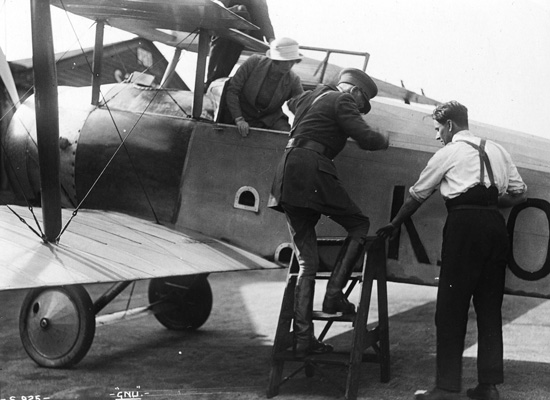
‘Gnu’ K101 has been kept busy since its first flight ten weeks ago initially giving flights from Brooklands. (above) Access for the passengers is clearly not easy. It has since been flown to Southport by Cpt Barnard to give pleasure flights from the beach (below) and after returning to Brooklands for Harry and Muriel’s flight to the Hendon event is now back at Southport as advertised in the Southport Guardian.
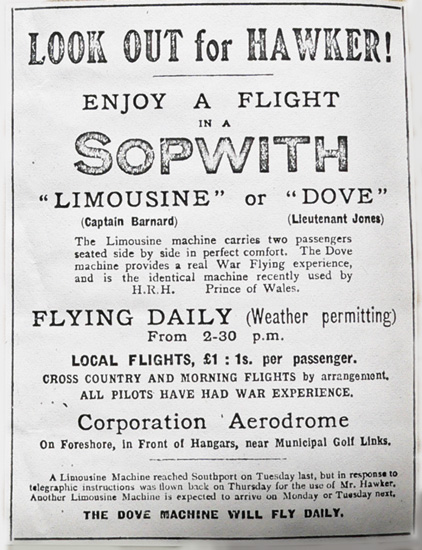
On 10th June, with two passengers aboard, Cpt Barnard experiences difficulty in starting the Bentley BR2 engine and notices the cockpit by the carburettor is wet with petrol but does get away. At about 400ft, the engine backfires and an explosion of the petrol vapour in the cockpit blows off his goggles. He dives steeply with the aircraft on fire but overturns landing on the seashore severely injuring himself with minor injuries to the passengers. The aircraft is completely burnt out. Within days, an Air Ministry enquiry concludes that the flight should not have commenced and recommends a sump under carburettors to drain off any petrol that escapes.
During the war, Sopwith ‘Pups’ were used as advanced trainers in 5, 6 & 8 Australian Flying Corps Training Squadrons in Britain. Over the last few months twenty Avro 504s and twelve new Standard Motors built ‘Pups’ C521 to C532 have arrived at the Australian Central Flying School at Point Cook near Melbourne to modernise their equipment. On 12th June, four 504s and three ’Pups’ set out on a cross country flight to Ballarat but most turn back in the strong headwinds. The one ‘Pup’ that completes the 60 mile trip takes 110 minutes. The return trip the next day with the tailwind takes just 35 minutes.
On 13th June, 80 Squadron with its ‘Snipe’ is reported to be established at Aboukir in Egypt whilst 51, 61, 75 & 112 Home Defence Squadrons re-equipped earlier this year with ‘Snipe’ are all disbanded. Home Defence ‘Snipe’ have been equipped with flare brackets under the wingtips, navigation lights and a wind-driven generator on the starboard undercarriage leg. (below)
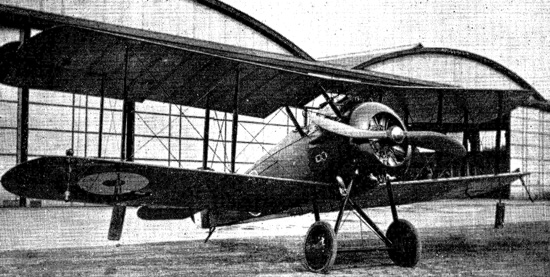
In Newfoundland on 13th June, the Handley Page team attempts a 5 hour test flight from Harbour Grace with their ‘V/1500’ (right) but the four engines boil after 90 minutes. They will have await the replacement revised radiators which are on a ship held up by thick fog 200 miles off St John’s.
Since arriving at the exposed Lester’s Field on 9th June, the competing Vickers team have had near gale force winds but on 13th June decide to fuel their ‘Vimy’ with its full trans-Atlantic complement of 865 gallons of petrol, 40 gallons of oil and 6 gallons of water. That weight exposes a failed undercarriage shock absorber. By the time the fuel is pumped out, a stronger shock absorber fitted and the fuel carefully pumped back in the weather rules out any Atlantic attempt.
On Saturday 14th June, crowds gather at Lester’s Field (right) to again watch the Vickers team carefully prepare their ‘Vimy’ but the wind changes direction and the six-ton loaded aircraft has to be manhandled with the help of thirty local men to the other end of the field.
At 1.45pm (4.13 GMT), now into the 30mph wind but with only a 400 yards uphill run, 40 volunteers stand along the front of the wings and tail to hold the plane back until, at full power. Jack Alcock gives the signal to them to lie down and it lumbers forward only just managing to rise enough in the final 100 yards to clear the high stone dyke and trees at the end of the strip before dropping from sight behind the hill. To everyone’s relief, it soon appears again slowly climbing away. (below)
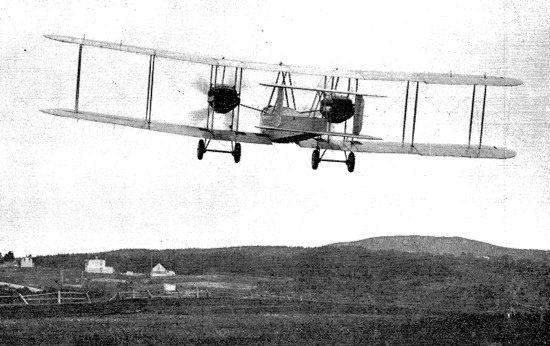
Within an hour they hit dense fog and fly purely by compass. Brown tries to send a message with their estimated position but discovers that the propeller on the generator for the radio transmitter has sheared off and they have no means of communication.
After two hours, an exhaust pipe on an engine burns away and it is now so noisy they can only communicate in writing. After four hours, Brown gets a fleeting fix on the sun to confirm his dead reckoning location. In the dark it is cold and the heating in their suits has failed but the 30mph tail wind sees them averaging 120mph. By midnight, tired and slightly frost bitten, they are half way across. In the grey dawn, they suddenly plunge into the blackness of a towering cumulonimbus cloud and are tossed around with hail beating down on them in the open cockpit and ice building up on the wings. Disorientated with no horizon, they finally sense from the wind on their faces that they are descending fast and come out of the cloud in a spiral dive less than 500ft above the water. Alcock manages to right the machine and climb away. Determined to go higher and higher to get above the next bank of cloud he takes them through rain, then snow and freezing rain which starts to freeze up the ailerons and coat the whole aircraft with ice. Most worryingly, ice is building up in the engine air intakes and some reports state that Brown “despite being a cripple” climbs out along each slippery wing in turn to clear some of the ice from the intakes. They go lower to get thawing air but the engines stutter and Alcock stops them before gliding down to 500ft. With engines restarted, they peer forward and finally at 8.15am see two islands and the mountains of Connemara. By 8.25am, they cross the coast near Clifden. In a hurried exchange of notes, both agree they are too tired and shaken by their experiences to go on to England. They have flown the Atlantic and taken the Daily Mail prize. After dropping flares around Marconi’s radio masts at Clifden, they choose a level green field only to discover at the last moment that it is green tussocks in a muddy bog. The aircraft is rapidly slowed and comes to a standstill nose down in the peat. They are unhurt. After a 16 hours 20 minutes flight, their fate unknown, they are soon surrounded by people. An armed guard is mounted around the aircraft to avoid any more souvenir hunter’s damage. (below)
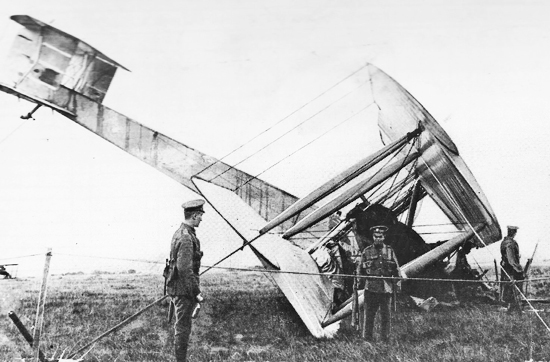
On Monday 16th June, Alcock and Brown are headline news in the London papers as they leave Galway to cross Ireland by train to Dublin and another official dinner and reception. The workers at Vickers at Brooklands and the Rolls-Royce Derby aero engine works are given a day’s holiday to celebrate the achievement.
On Tuesday morning, 17th June, the victors take the mail packet for Holyhead and are again met by large crowds Their train is escorted from Rugby by a squadron of RAF aircraft to a reception at Euston Station which matches that received by Hawker and Mackenzie-Grieve. Harry and Muriel Hawker are there to congratulate them and escort them to the Royal Aero Club where they confirm the flight details for the prize and hand over the bag of 197 airmail letters to the Postmaster General.
Meanwhile. 208 Squadron ‘Snipe’ E8054 is wrecked flying from their new base at Heumar near Cologne.
By 18th June, the Handley Page team has fitted the replacement radiators on the ‘V/1500’ and manages a third test flight at Harbour Grace fully aware that the Trans-Atlantic prize has been claimed by Alcock and Brown. Instructions are coming from the Handley Page to cancel the Atlantic flight and prepare to fly non-stop to New York. Fred Raynham is still determined to make the first single-engined Atlantic crossing and the Martinsyde team are rebuilding the aircraft in a garage in St John’s. With “Fax” Morgan injured in the take-off crash he has a new navigator/co-pilot and the “Raymor” is being renamed “Chimera”.
As the Surrey Comet reports that Bert Hinkler is ready to start his sole flight to Australia, new rules issued on 19th June by the Australian Government disqualify his entry in the single-seat Sopwith ‘Dove’. On safety advice from experts all competitors must now have a qualified navigator aboard. The earliest start date is also put back to 8th September when the weather through Asia is likely to be more clement. Hinkler has to go it alone with no prospect of race winnings or seek a navigator and sponsor for a more powerful more expensive two-seat aircraft.
On Friday 20th June, Cpt John Alcock and Lt Arthur Whitton Brown attend the Daily Mail luncheon at the Savoy Hotel in their honour. Secretary of State for War Winston Churchill presents them with the £10,000 and other prizes and makes a memorable speech drawing a dramatic picture of their journey over the Atlantic through inhospitable weather at constant risk before announcing that the King has decided they should be knighted.
On the morning of Saturday 21st June, whilst all sorts of hastily civil registered aircraft are arriving at Hendon for the first Aerial Derby race since the war and Alcock and Brown are being knighted by the King at Windsor, the skeleton German crews on the German Navy fleet locked up in Scapa Flow are secretly opening sea-cocks, torpedo tubes and portholes to scuttle over 50 ships rather than see them in the hands of the allied navies.
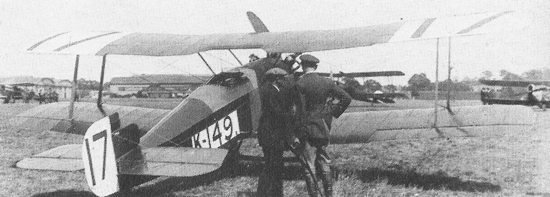
Amongst the aircraft at Hendon for the “Victory” Aerial Derby is Harry Hawker in No.17 Sopwith ‘Snapper’ K149, (above), the first of this type to fly having waited so long for flight cleared ABC Dragonfly engines. However it is one of the aircraft refused permission to compete by the Air Ministry reportedly on the grounds that the Government owns the engine. A Nieuport “Land Commercial” ‘LC1’ two seat civil version of the ‘Nighthawk’ with a Dragonfly engine does compete but suffers an engine failure on the second lap. Having lunched with the King and Queen at Windsor, Sir Jack Alcock rushes by taxi from Paddington to Hendon but is too late to fly his Aerial Derby entry. The race is won by a clipped wing 450hp Napier Lion-powered ‘DH4R’ averaging 129mph for the two 94½ mile laps around London, closely followed by a 270hp Rolls-Royce Falcon- powered Martinsyde ‘F4’ at 124mph.
At Bickendorf, on 21st June, 79 Squadron Sopwith ‘Dolphin’ pilot Lt Turkington is killed in a flying accident.
The annual report of Whitehead Aircraft (1917) Ltd of Richmond upon Thames to 30th September 1918 shows a profit of £19,686 of which £9,304 has been paid in preference share dividends. In 1917/18 the company built 550 Sopwith ‘Pups’ and 116 DH9s. Now, two creditors have filed a petition for the company to be wound up.
As a consequence of the last Jacques Schneider Trophy race being won for Great Britain by Howard Pixton in a Sopwith ‘Tabloid’ seaplane at Monte Carlo in April 1914, the FIA (International Aeronautic Federation) has asked the Royal Aero Club to organise this international seaplane race in England in September. It is to be 200 miles over the sea with a minimum circuit of 5 miles and will be held on the South Coast. Entries are promised from Great Britain, France, Italy, Spain, U.S.A. and Belgium.
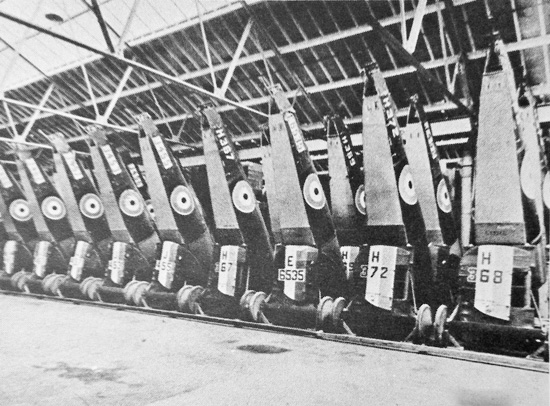
Flight journal reports that National Aircraft Factory No1 at Waddon next to Croydon aerodrome is now Aircraft Salvage Depot No.3, centre for the disposal of surplus aircraft and material and the salvage of damaged and obsolete aeroplanes and parts. Typical of the hundreds of carefully stacked new airframes are these Boulton & Paul and Ruston Proctor built ‘Snipe’. (above) There are also racks of wings, propellers and cleaned and greased engines whilst the mostly injured ex-soldier and sailor workforce are reducing damaged or obsolete aircraft to “produce”. (below) Saleable spare parts are removed and stored, fabric is stripped for the dope to be extracted and used to make high quality paper, the wood is used for the racks and engine stands, non-ferrous metal parts are sorted and melted into ingots in their foundry and the steel parts are sold for recycling.
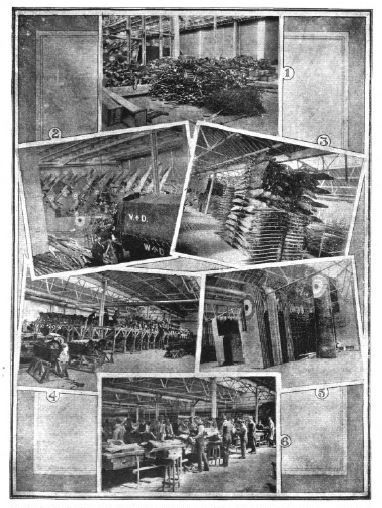
On 28th June, Muriel Hawker hosts the promised “Joy Day” for the children of Hook in the recreation ground in thankfulness for her husband’s rescue. There are numerous prizes for the sports events and a splendid tea party which is attended by Harry and baby Pamela.
On 28th June, the Treaty of Versailles is finally signed formally ending the war with Germany.
In Russia, the situation is not fully resolved. The Communist Bolsheviks control the heartland but un-coordinated White Russian forces are attacking them around the edges with some support from allied forces. In the Caucasus, in the south, a third RAF squadron No.47 arrived in early June with Sopwith ‘Camels’ and DH9s and they have started daily bombing and strafing raids this week. 47 Sqdn is commanded by Canadian Major Raymond Collishaw the highest scoring RNAS ace in the war with at least 59 victories, all in Sopwith aircraft: 2 flying ‘Strutters’ in 1916, 2 flying ‘Pups’ in 1917, 34 flying ‘Triplanes’ in 1917 and 20 flying ‘Camels’ in 1917 and June to September 1918. He will be flying a 47 Sqdn ‘Camel’ when other duties allow.
In the Baltic, the Admiralty is sending an aircraft carrier to join the ships supporting White Russians and the independent Baltic states whilst in the far north around Archangel and Murmansk the long standing small British force has been supplemented this month by a “Relief Force” including 15 ‘Snipe’ and 33 DH9/9A bombers. There are now three RAF Squadrons, two of them sharing an airfield with No.1 Slavo-British Squadron with Russian pilots who get 3 ‘Snipe’ and 4 ‘DH9s’ to supplement their old “Sopwith single seaters”, ‘Strutters’ and ‘DH9s’. (below ‘Snipe’, DH9s and ‘Strutters’ in Northern Russia)

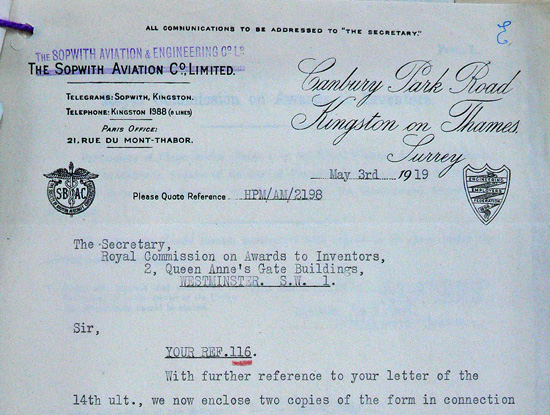
On 30th June, the Royal Commission on Awards to Inventors accepts a claim of £3,950 for the 3,950 sets of Sopwith-Kauper synchronizing gun gear “supplied by or ordered from contractors other than Sopwith for the service of the Crown.” Since May, the company has been using over-stamped letter headings in its correspondence with the commission. (above)
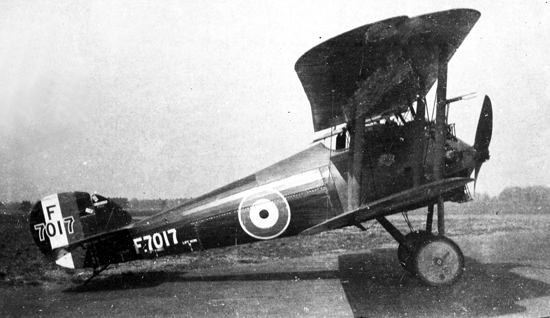
After 137 aircraft delivered in January, 100 in February, 61 in March, 68 in April and 92 in May the Sopwith factories deliver 64 military aircraft in June completing 30 ‘Salamanders’ and the first 34 of their production Dragonfly radial engined ‘Snipe’ known as ‘Dragons’. Among the ‘Dragons’ delivered in June is F7017. (above) It has the late ‘Snipe’ style horn balanced outward tapered ailerons and fully rounded fin and rudder and appears to be complete and flyable. Many of the orders for 12,000 Dragonfly engines on 17 manufacturers have been suspended but some are arriving despite not yet being reliable enough to go into service. The photograph taken in Sopwith’s Ham factory shows at least 25 Dragonfly engines fitted to ‘Dragons’ but the four across the back are already wrapped for storage.
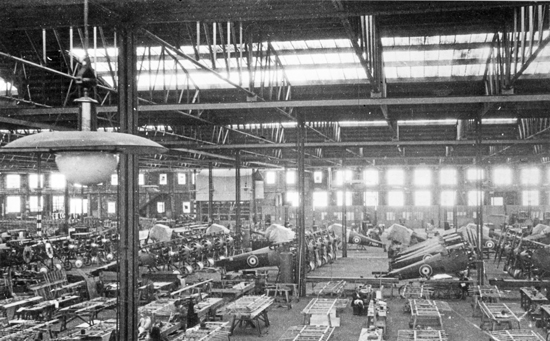
Sopwith’s Canbury Park Road factories, whilst producing parts for ‘Salamander’ and ‘Dragon’ assembly at the Ham factory, are working on a few more civil ‘Gnu’ and ‘Doves’ although none have yet sold.
The number of new Sopwith aircraft from other contractors is around 250 in June after 415 in January, 249 in February, 304 in March, 341 in April and 229 in May. This month’s total includes 165 ‘Snipe’ from Boulton & Paul (14), Coventry Ordnance Works (24), Kingsbury (19), Portholme (82) and Ruston Proctor (22) and the final 4 of 135 from Napier. There are 54 ‘Salamander’ from Bleriot/Air Navigation (28), Glendower (17) and Palladium Autocars (9) plus 24 ‘Dolphins’ from Hooper. Blackburn have probably completed 2 more ‘Cuckoos’ this month and there are a final 5 ‘Camels’ of 217 built by March Jones & Cribb bringing the total ‘F1 Camels’ built over the last 30 months to 5,720. In addition some 250 ‘2F1 Ships Camels’ have been built leaving just 25 more to come at some time from Clayton & Shuttleworth.
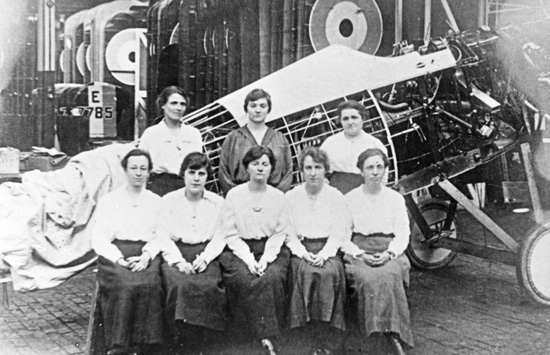
The photograph (above) most probably at the Ruston Proctor works in Lincoln shows women workers with fabric draped over a bare ‘Snipe’ fuselage in front of completed wings and fuselages including E7785, one of those delivered in June.
Six months after the peak total of 22,796 aircraft on charge in the Royal Air Force on 31st December 1918 that total has fallen to 18,043. The total of Sopwith designed types has fallen by 812 to 4,292 still well over 20% of the total although the mix has changed with 2,025 fewer ‘Camels’, 560 fewer ‘Pups’, 76 fewer ‘Strutters’, 1,142 more ‘Snipe’, 324 more ‘Salamander’, 137 more ‘Dolphins, 86 more ‘Cuckoos’ and 60 more ‘Ships Camels’.
On 1st July, the Sopwith Aviation and Engineering Co Ltd Annual General Meeting approves last year’s annual accounts and dividends but the Sopwith Board meeting minutes reflect concern about cash outflow as they invest in the specialist machinery, equipment and training needed to start volume motorcycle production. They have declined to invest in Victory Stock and sold the company’s motor screw yacht Vashti to Montague Graham-White.
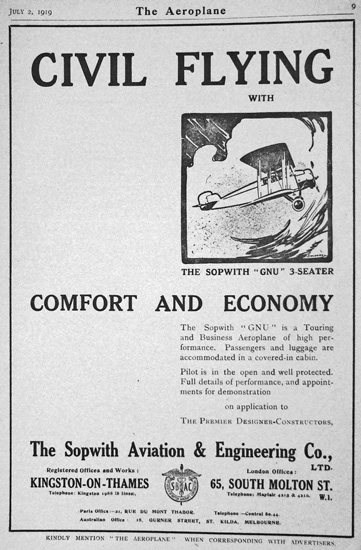
The day after the drawing office issues the general arrangement drawing for the ‘Gnu’ it is the focus for an advertisement with Sopwith Aviation and Engineering described as “The Premier Designer-Constructor” and the Sopwith Board seals agreements with Southport Borough Council “as to facilities for civilian flying” and indemnities “in respect of the aerodrome north of the municipal golf links”. In a parallel attempt to ensure there will be enough work for the factories, Sopwith announces that Major H. A. Geaussent is to take charge of their export department for the A.B.C. motor-cycles. “Major Geaussent was for several years before the War export manager for the Hutchinson Tyre Co. He has a thorough knowledge of the trade overseas gained by continual visits to and residence in South Africa, Australia, New Zealand and other parts. During the War, Major Geaussent has seen a great deal of active service in the Dardanelles, Egypt and France.”
On 1st July Sopwith ‘Snipe’ equipped Home Defence 37 Squadron at Biggin Hill is renumbered 39 Squadron whilst 43 Squadron moves its ‘Snipe’ to North Weald Bassett from Hainault Farm.
On 2nd July the 643 ft long, 5-engined, hydrogen-filled airship R-34 built by Beardmore for the Admiralty departs East Fortune in Scotland with a crew of thirty to attempt a non-stop east-west Atlantic crossing to New York.
On 2nd July HMS Vindictive leaves for the Baltic with a dozen aircraft, a mix of ‘Ships Camels’, ‘Strutters’, Grain Griffins and Short 184 bombers to join the British campaign in support of the newly independent Baltic states. Meanwhile in the Firth of Forth the pilot of ‘Ships Camel’ N7147 is drowned spinning-in probably flying from HMS Furious. ‘Ships Camel’ N6776 also crashes but is recovered. At Bickendorf crashed Sopwith ‘Buffalo’ H5892 has been repaired and is finally available for service trials with 43 & 70 Sqdns as an armoured two-seat fighter.
On 3rd July ‘Baby’ N2103 makes the first flight of a Chilean “naval hydroplane” in the bay of Talcahuano piloted by British instructor Victor Huston.(below) It was shipped out to Chile almost a year ago with N2104 & N1068.
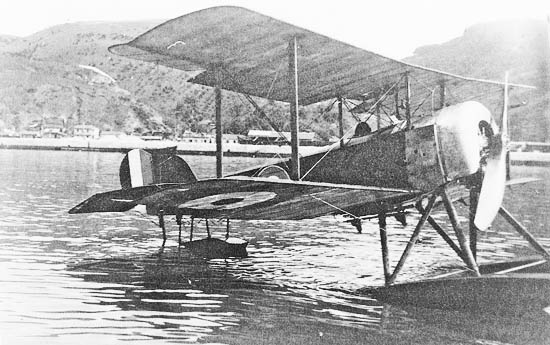
On 4th July the Handley Page V/1500 with a crew of five and 1,300 gallons of fuel leaves Newfoundland on a non-stop 1,000 miles flight to New York to greet the British airship R34. Twelve hours later the engines are boiling and eventually one engine seizes. They make a forced landing on a racecourse in Nova Scotia hitting fences and a hollow tipping the aircraft onto its nose rather crumpled.
On 6th July the airship R-34 lands at Long Island New York from a 108 hours east-west non-stop Atlantic crossing from East Fortune. It has taken just five hours less than the normal sea voyage and is low on fuel having battled adverse winds and diverted around thunderstorms. Meanwhile HMS Vindictive with her precious cargo of aircraft runs aground on a shoal at speed near Reval in northern Estonia and is stuck hard in the tideless Baltic. Accompanying cruisers cannot tow her free and the crew set about dumping her fuel and ammunition and off-loading 2,200 tons of stores.
The Aeroplane Supply Depots’ Repair Parks which did such a vital job through the war continue to receive crashed and badly damaged aircraft. With plenty of new machines now available aircraft re-building has stopped but there is still the task of reducing damaged machines to spares and produce. 70 Sqdn Snipe F2367 which arrived at Bickendorf in April has been overturned and appears in the foreground of the photograph probably at No.1 Aeroplane Supply Depot close-by in Cologne at Merheim. (below) Beside it is 208 Sqdn ‘Snipe’ F2378 which crashed on 28th May and two more ‘Snipe’. Many others shown are DH9s with some ‘Dolphins’.
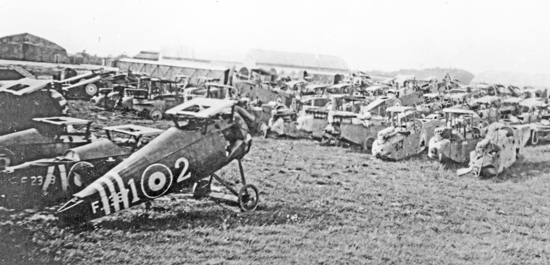
It is reported that at least 75 Sopwith ‘Camels’ from the seven U.S. Aero Squadrons which used them in France are being shipped to the United States along with numbers of French built Sopwith ‘Strutters’ and Nieuport 28s. The U.S. Navy Department have now requested another 17 of the ‘Camels’ and 16 of the ‘Strutters’.
On 10th July after just four days in New York the Admiralty airship R-34 leaves on its return flight to Britain and on 13th July it arrives at Pulham in Norfolk after a 75 hours flight from New York. With some help from the prevailing winds it has taken 33 fewer hours than the outbound journey.
On 14th July the pilot of 80 Sqdn Sopwith ‘Pup’ C480 is killed crashing at Aboukir after “an error of judgement”. HMS Vindictive, grounded for eight days off the Estonian coast with her precious cargo of aircraft, is finally pulled free by the escorting cruisers when a westerly wind raises the water level in the tideless Baltic by 8 inches. The entire operation has unknowingly taken place in a minefield.
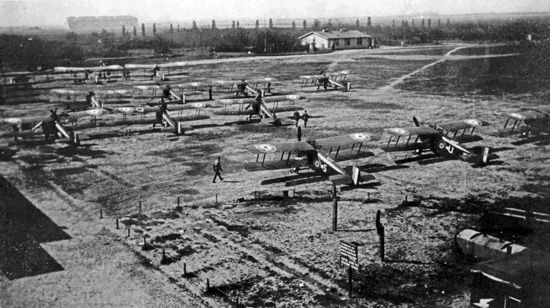
Sopwith ‘Dolphin’ equipped 79 Squadron in service over the Western Front from February 1918 arrived at Bickendorf, Cologne on 20th December last year (above) as part of the Army of Occupation to help police the demilitarised zone. With the Peace Treaty now signed the squadron is being disbanded this week, the last of the four “Dolphin” squadrons which saw active service abroad. This leaves Sopwith ‘Snipe’ equipped 43 & 70 Squadrons at Bickendorf alongside single squadrons of Bristol Fighters, SE5As and DH9s whilst 208 Squadron’s ‘Snipe’ are based nearby at Heumar.

The last seven months at Bickendorf has been quite intensive with one squadron on standby from first light every day to intercept any aerial threat at a moment’s notice. (70 Sqdn above) Flying rules stipulate all take-offs and landings must be into the wind, no climbing turns off the ground, left hand circuits only and no stunting over the aerodrome under 2,000ft. Each squadron has weekly gunnery practice flying east to west, one aircraft at a time, diving steeply at targets and only firing below 1,000ft. There is quite a lot of other practice and test flying and there have inevitably been accidents. (below. The striped engine cowl is unusual)
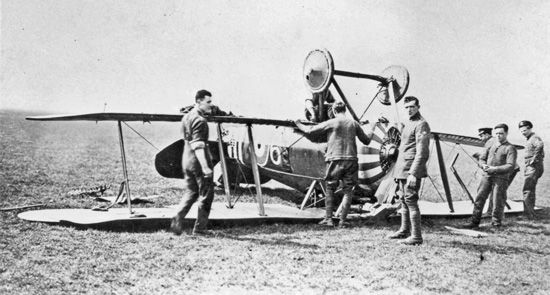
Bickendorf Standing Orders cover every aspect of daily routines from reveille at 6am to lights out at 10pm. They define sentry duties, parade times, meal times and exercise times and include detailed instructions, for example, water must be boiled before drinking whilst football and rugby teams are each to remove one set of posts from the aerodrome after each match.
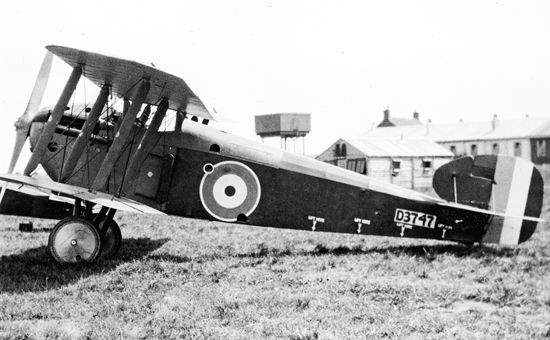
On 16th July unarmed ‘Dolphin’ D3747 (above) transfers from Orfordness to continue experimental work at Martlesham Heath.
Despite the take-off crash on 18th May at Quidi Vidi on Newfoundland, Fred Raynham is still determined to make the first single-engined trans-Atlantic flight. His Martinsyde Raymor has been repaired and renamed Chimera. It had its first test flight on 4th July, suffered tyre burst on 13th and had another flight on 14th which had to be abandoned after an hour with radiator problems. However at 3.15pm on 17th July Raynham and his new navigator are finally ready for their trans-Atlantic flight. The fully loaded machine struggles into the air after 300yds but is caught by a gust of wind. A wing dips and hits the ground. Raynham manages to level the machine before it crashes heavily. The crew are not seriously injured but the aircraft is damaged beyond local repair and will have to be returned to England by boat with a downcast Fred Raynham and his Martinsyde support team.
On 18th July No.143 Home Defence Training Squadron Snipe E7428 is wrecked at Detling in Kent. Meanwhile 80 Sqdn, now well established at Aboukir in Egypt after their time with the Army of Occupation in Germany, have in the last week received at least 21 replacement Sopwith ‘Snipe’ via X Aeroplane Depot at Alexandria. These include Ruston Proctor built E7511 to E7530 (below) and Sopwith built E8105.
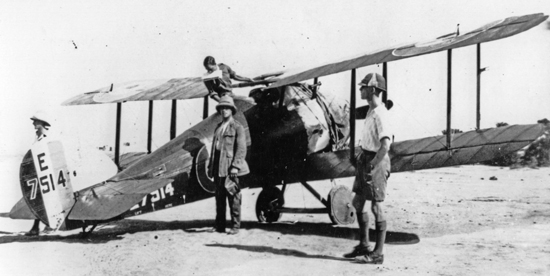
On Saturday 19th July there are hastily arranged “Peace Day” events around the country to recognise the long awaited signing of the Peace Treaty including a large military parade through London witnessed by the King. The aircraft carrier HMS Furious, which launched her ‘Ships Camels’ for the successful raid on the airship sheds at Tondern, is in the Thames estuary off Southend dressed overall. (below)
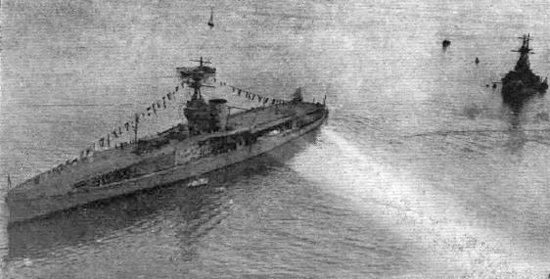
By 20th July in the Baltic re-floated aircraft carrier HMS Vindictive has sent off ‘Ships Camel’ N6616 to the Estonian Air Force where it is to be flown by their Chief Flying Instructor RAF Captain Claude Emery. The following day at Biorko in Finland she unloads the rest of her air group with two ‘Camels’ going ashore by lighter to be taken to the airstrip under construction near Koivisto whilst the Short seaplanes are being moored on the shore.
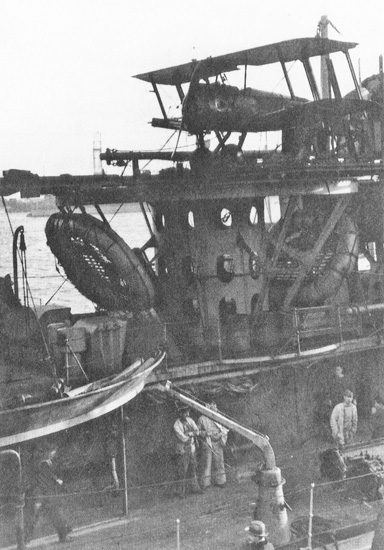
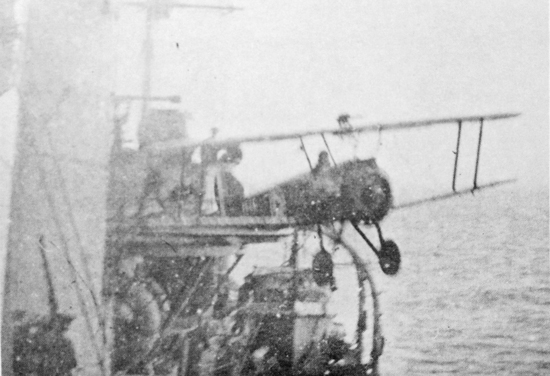
Cruiser HMS Caledon is also in the Baltic back for a third time this year having been out there in January and March. Her ‘Ships Camel’ N6602 is flown from a rotating platform amidships aft of the funnels. (above) During the war three cruisers were fitted with these platforms aft and six had them forward. They were prefabricated ashore and fitted quickly when the ships had to enter the dockyard for any reason. In addition twenty-six larger battle cruisers and battleships have been operating with pairs of ramps mounted on their main gun turrets, typically for a reconnaissance ‘Strutter’ and a ‘Ships Camel’ interceptor.
On 22nd July Sopwith-built ‘Strutter’ 9670 is finally struck off charge after three years in service most recently with the transport flight at Dover. Alcock & Brown have donated £2,000 of their Trans-Atlantic flight prize money to Vickers and Rolls-Royce employees which the companies have supplemented in order to give their workers a week’s paid holiday.
On 25th July 208 Squadron ‘Snipe’ E8154 crashes on take-off at Heumar, Cologne.
The Royal Aircraft Establishment at Farnborough continue to encounter delays testing the ABC Dragonfly Mk.II radial engines in ‘Snipe/Dragon’ B9967 and ‘Bulldog’ X4 suffering failed exhaust domes, a burnt exhaust valve and broken valve spring. When they are running, these engines start to cut out at 0˚C to -3˚C. RAE’s 25th July report on heating the air going into the two carburettors finds that standard exhaust gas muffs work but they fail at welds and crack after a few hours making them too dangerous to use being located inside the wooden aircraft structure.
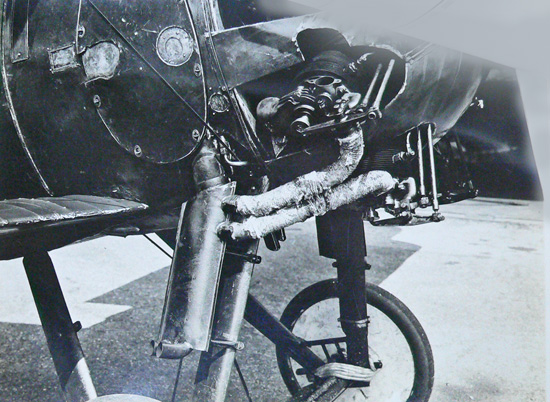
They have tried two exhaust pipes through an induction muff down each undercarriage leg (above) but that only works down to -6˚C. Drawing heat from the cylinder walls was equally ineffective. They have now tested induction pipes extended forward surrounding a central finned pipe each carrying the exhaust gasses from two cylinders. (below) These have kept the engine running satisfactorily down to -26˚C and this is expected go even lower when more high altitude flight testing is completed.
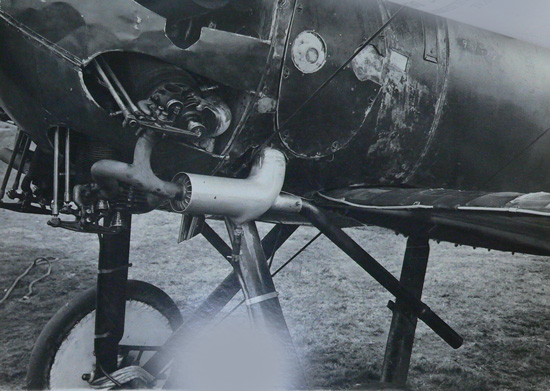
On Saturday 26th July it is the third annual Sopwith Sports Day at the Norbiton Sports Ground in aid of the Employees’ Sick Club Benevolent Fund. It attracts a crowd of 2,000 and entries from some of the top-class athletic clubs including Surrey A.C. Many of the “foot races” for boys, girls, men and ladies are handicaps with competitors given appropriate number of yards start over the scratch entry. Judges include T O M Sopwith and Fred Sigrist whilst Harry Hawker gives “a brilliant exhibition of flying”. He flies on to do the same over Hook and Southborough’s own Peace Day “Rustic Revels” at Hook Recreation Ground “performing all manner of evolutions from looping the loop to spinning nose dives before swooping down to 20 feet and skimming the tops of some young plane trees”. At Hook there are not just “running races”, tug-of war and high jump but also “kangaroo, apple, obstacle, skipping, needle-threading, potato, blindfold, egg and spoon and veteran’s races”. A bountiful tea is provided for 321 children in a large marquee and both events include an orchestra with dancing into the evening.
On 26th July despite Koivisto airfield still being under construction HMS Vindictive’s aircraft are able to fly a reconnaissance mission over the major Bolshevik naval base at Kronstadt while she sailed to Copenhagen to load more aircraft and spares left for her by the carrier HMS Argus.
On 30th July HMS Vindictive’s aircraft attack Kronstadt at night. Her flying-off deck has been extended to 118 feet to better allow the bombers to take off with their 112lb bombs. She steams out in Bjorko Sound and at 0.23am the first Sopwith ‘Strutter’ flies off with the ship at 19 Knots. 50 minutes later a second ‘Strutter’ leaves followed by Grain Griffin N105. (below, on Vindictive’s deck)
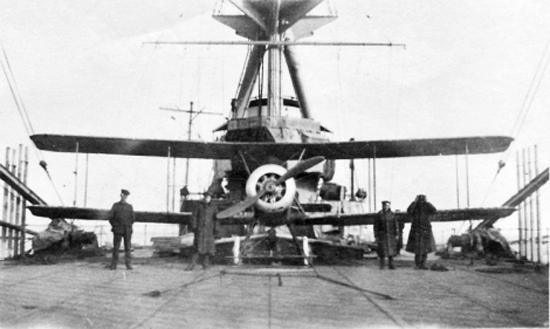
Three Short 184 floatplanes join the raid plus three ‘Camels’ from Koivisto airfield. The raiders meet accurate anti-aircraft fire and stay high but drop 16 bombs and do manage to set a tanker on fire. All get back safely by 3am. Vindictive goes out again at 4am and a Grain Griffin flies off at 5am but has engine trouble, jettisons her bombs and heads for the airfield. This same day eight RN coastal motor boats arrive and, with her aircraft ashore, Vindictive is to serve as their depot ship.
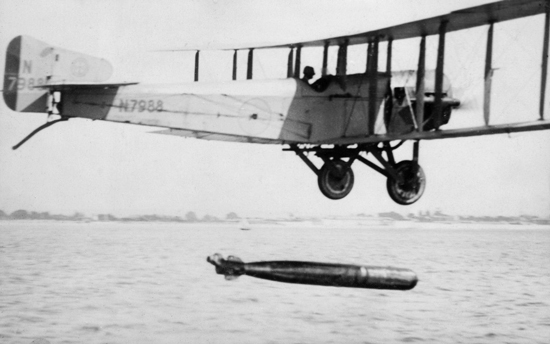
Meanwhile No.186 Torpedo Development Squadron at Gosport is practising daylight massed torpedo attacks, the original reason for ordering Sopwith ‘Cuckoos’ in October 1917 but they were too late arriving from the various contractors to be used during the war. ‘Cuckoo’ N7988, now painted “dead grey all over” with dark grey numbering is photographed off Spithead. (above) The extensions to the exhaust pipes are to heat the torpedo’s motor chamber. The drogue is just deploying to slow the torpedo before entry which with the flat trajectory should ensure a successful attack even in shallow water. (below, torpedo, drogue and tail attachment)
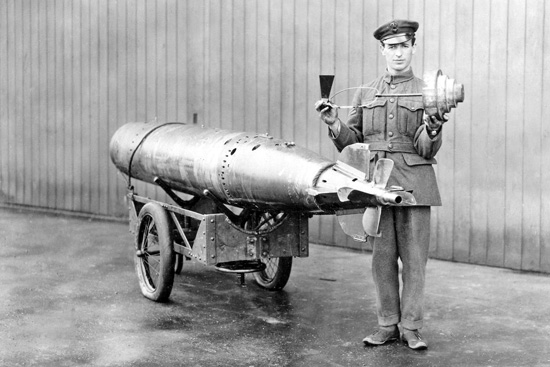
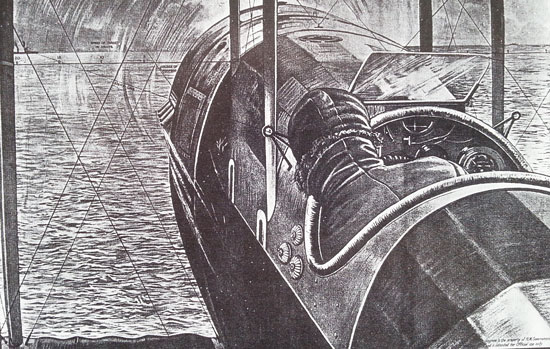
The aiming of a torpedo, being at very low level, is done with forward looking sights. (abovet, RAF Technical Diagram) It was originally proposed that ‘Cuckoos’ could also be used as bombers This is not being pursued because they found no practical way to install a downward looking bombsight for the pilot but at least three have been fitted with interchangeable bomb gear to carry two large smoke bombs to use in conjunction with torpefo attacks. (below)
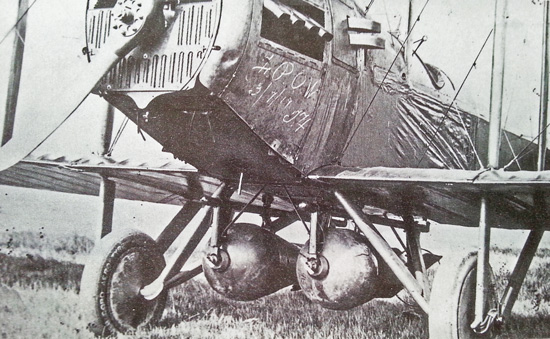
On 31st July 208 Squadron ‘Snipe’ F2343 is wrecked landing from fighting practice at Heumar in Cologne. At Grain ‘Pup’ B5940 has been fitted with an over-wing hook on the top wing centre section for their long promised experiments with overhead landing wires. B5939 with deck landing and arrester gear has re-appeared at Grain apparently also being readied for cable landing experiments.
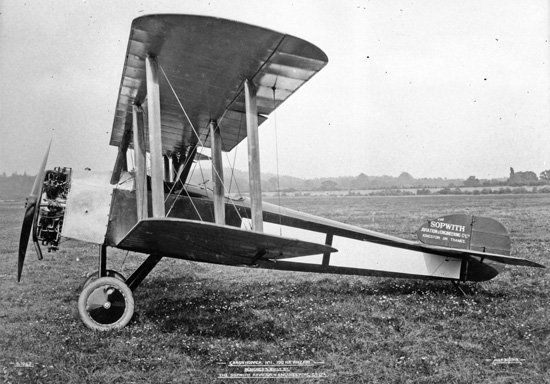
A surprise arrival at Brooklands from Sopwith’s experimental shop in Kingston on 31st July is a new two-seat ‘tourer’. (above) The Sopwith ‘Grasshopper’ is slightly larger than the ‘Dove’, has two-bay wings. (below)
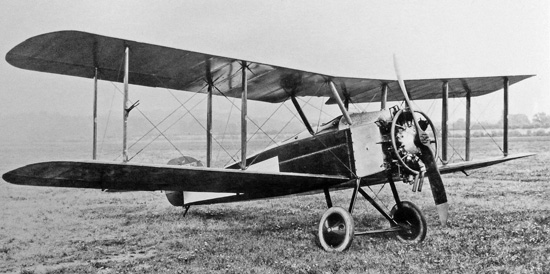
It has an unusual 100hp Anzani radial engine. (below) with 10 cylinders in two staggered rows of 5 with an exhaust ring at the front and is similar if not identical to the engines used by Sopwith in three floatplanes built for the RNAS way back in mid 1913.
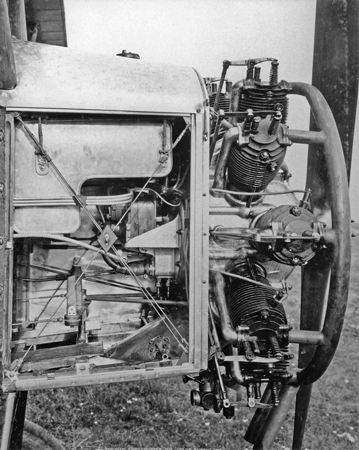
Sopwith have also had photographs taken of one of their newest ‘Dragons’ J3704 in the field behind the Ham factory. (below) They show the neat cowl and exposed cylinder heads of the powerful Dragonfly radial engine, the front view emphasises the comparatively fragile undercarriage and wing structure.
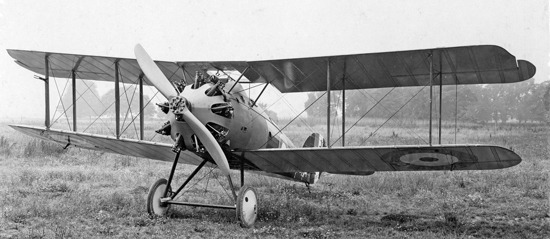
After 137 aircraft delivered in January, 100 in February, 61 in March, 68 in April, 92 in May and 64 in June the Sopwith factories deliver 92 military aircraft in July completing 22 ‘Salamanders’ and a record 70 ‘Dragon’ radial engined ‘Snipe’. Sopwith’s Canbury Park Road factories continue to produce parts for ‘Salamander’ and ‘Dragon’ assembly at the Ham factory and have now turned out the ‘Grasshopper’ and a total of 7 civil ‘Gnu’ and 5 ‘Doves’. Their current urgent project is a building a high-performance floatplane for September’s Schneider Cup Race.
The number of new Sopwith aircraft from other contractors is around 146 in July after 415 in January, 249 in February, 304 in March, 341 in April, 229 in May and around 250 in June. This month’s total includes 81 ‘Snipe’ from Boulton & Paul (36), Coventry Ordnance Works (28), Portholme (15) and the final 2 of 30 from Kingsbury. There are 42 ‘Salamander’ the first 5 from Wolseley Motors, the last 24 of 107 from Air Navigation, the last 5 of 50 from Glendower(17) and the last 8 of 29 from Palladium Autocars. Hooper have delivered the last 13 ‘Dolphins’ bringing their total to 309 of the 1,774 built. Blackburn have probably delivered another ‘Cuckoo’. It is not clear if any of the final 25 ‘Ships Camels’ have been completed by Clayton & Shuttleworth.
The International Commission for Air Navigation conference in Paris has now allocated the British Empire the registration prefix G followed by four letters. With effect from 22nd July 1919 the United Kingdom has decided to use the G-Exxx sequence for heavier-than-air aircraft and G-Fxxx for lighter-than-air aircraft. Aircraft flying on temporary former military serials and those allotted in the K-100 sequence are all to be re-registered sequentially from G-EAAA. Sopwith already have 7 ‘Gnu’ and 5 ‘Doves’ on the K register and new G registrations have been allocated as follows including one for Gnu K101 which was wrecked at Southport (G = Gnu, D = Dove):- K101/G-EAHH G, K122/G-EACM D, K133/G-EACU D, K136/G-EADB G, K140/G-EAEP G, K148/G-EAFI D, K156/G-EAFR G, K157/G-EAGA D, K163/G-EAGP G, K164/G-EAGQ G, K168/G-EAHP D & K169/G-EAHQ Gnu. ‘Scooter’ K135 is to be G-EACZ and ‘Snapper’ K149 gets G-EAFJ but is reverting to its military serial number.
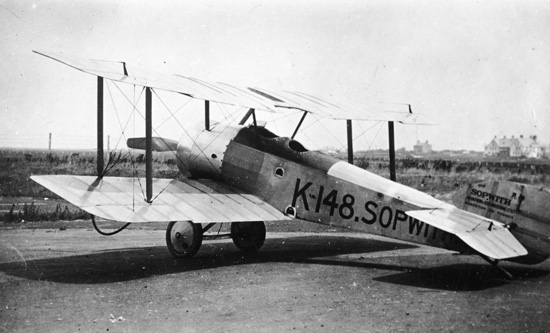
Sopwith are in no hurry to apply the new registrations to their busy machines taking passengers for pleasure flights at Southport which is probably the location of the first three of these photographs showing the “Sopwith” name boldly displayed pre-war style. (above ‘Dove’ K148 and below, ‘Gnu’ K136 with the standard enclosed two-seat passenger cabin behind the pilot and ‘Gnu’ K140 which has a non-standard open two-seat passenger cabin.)
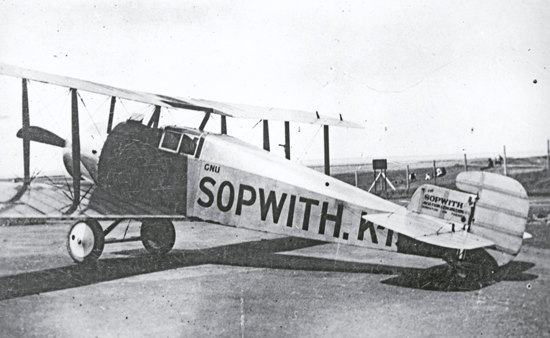
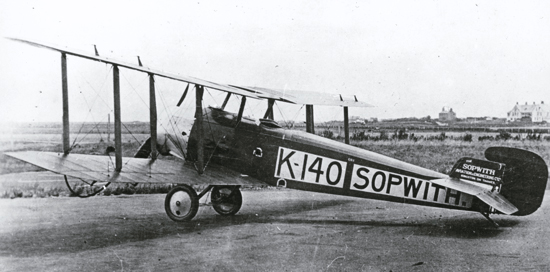
K136 & K140 are the only ‘Gnu’ yet to have been awarded a formal Certificate of Airworthiness (C of A). K163 & K164 are currently at Brooklands and will probably immediately carry their G-E registration marks. K169 is apparently being held back until some orders arrive.
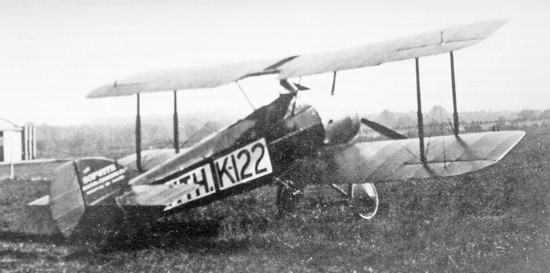
Of the other K registered ‘Doves’, the prototype is photographed at Brooklands carrying its retrospectively allocated K122 number (above). There is no record of “Hinkler’s” single-seat ‘Dove’ carrying a K number although it may be the machine which was allocated K133. It is awaiting a decision on its future and may be converted to a standard two-seater. K157 & K168 are complete with their K numbers and will be next to go through the airworthiness certification process at Brooklands.
Recognising the need to diversify like Sopwith Aviation, the ex-Bleriot Air Navigation Co of Addlestone which has just completed its orders for Sopwith ‘Salamander’ has now added “engineering” to its name to become The Air Navigation & Engineering Co which abbreviates to ANEC.
On 1st August, the pilot of 186 Squadron Gosport ‘Cuckoo’ N7193 is seriously injured spinning-in from 2,000ft. Meanwhile, at Bereznik in North Russia, the commander of the Russian Air Unit Major Kozakov is killed testing the recently overhauled RAF ‘Snipe’ E6350 when it spins into the ground from a right turn at 300ft with the engine still running. (below) The word goes around that he has done this deliberately now it is clear that the Allies are preparing to withdraw and he could expect no mercy from the Bolsheviks.
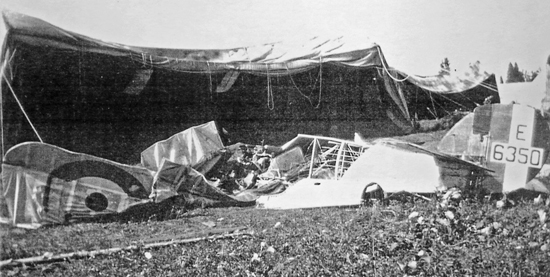
The 2nd August, Financial Times’ “Saturday Causerie” column contains the following article: “It is now understood that the purchaser of Lord Lovelace’s Surrey seat, Horsley Towers, which was disposed of by auction on 29th July for £150,000, is Mr. “Solly ” Joel, and that Mr. T.O.M. Sopwith, of the Sopwith Aviation Co., is also considerably interested in the deal. Mr. Sopwith, who lives close by at Cobham and already rents the Earl of Lovelace’s shooting, is credited locally with a keen desire to secure the Horsley Towers estate for the purpose of erecting an aerodrome in the park, which covers 260 acres, and he is believed to have offered £200,000 for the property before the public auction. If that be so, the terms on which Mr. Joel has secured it would appear to be very favourable. The total area of the estate is 2,750 acres, with a rent roll of £2,500, excluding the Lovelace seat. The estimated value of the timber alone is put between £64,000 and £80,000. Horsley Towers is one of Sir Charles Barry’s Tudor-Gothic mansions. It has looked on many changes but none so strange as that which may eventually cause it to witness within its shadow the rearing of Sopwith Pups.”
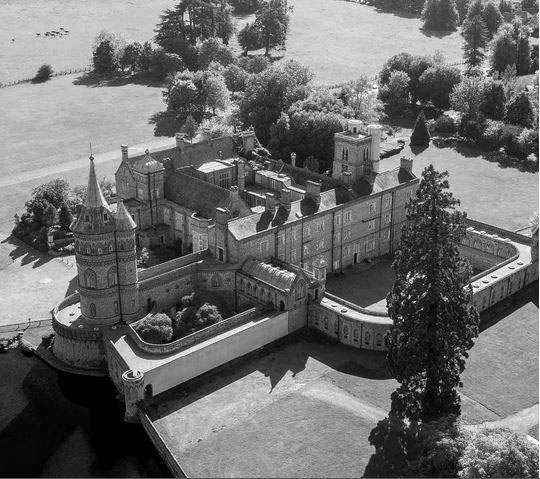
The article does not explain that the Sopwith and Joel families are close friends and Thomas Sopwith’s sister Olive is married to Jack Joel, a brother of Solomon “Solly” Joel. Although English born and now living in England, both have made fortunes through the South African gold and diamond mining industries. Solly has bid for the property on behalf of, or knowing he can sell it on to, Thomas Sopwith. It is likely that part of the huge purchase price will be on a loan or on a mortgage from the Sopwith Aviation Company’s significant reserves as was Thomas Sopwith’s current home Ordsal House, Cobham when he purchased that in 1914.
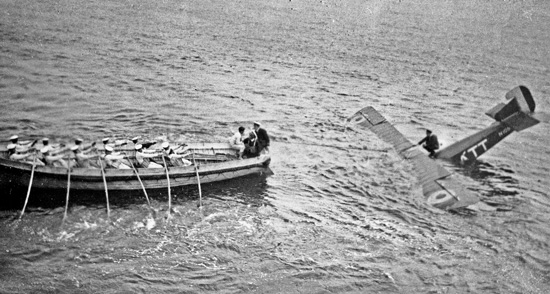
On 13th August, in the Baltic, an aircraft carrier demonstration to the Rear Admiral does not go well. At 5.30, Grain Griffin N105 flies off the foredeck of HMS Vindictive but ditches. The crew are saved and it is recovered with the assistance of a tug and a rowed whaler. (above) ‘Ships Camel’ N6825 which follows off the deck also crashes and this time the pilot is killed. There are suggestions that the fuel might have become contaminated.
Meanwhile in Germany on 13th August, 208 Sqdn ‘Snipe’ E8188 is wrecked on a test flight. All three ‘Snipe’ squadrons currently based around Cologne with the Army of Occupation are preparing to return home. They each have remarkably long and distinguished records flying Sopwith aircraft. 43 Squadron went to France in 1917 with ‘Strutters’ re-equipping with ‘Camels’ from September 1917 and from September 1918 with ‘Snipe’. They carry their post-March 1918 sloping bar squadron markings either side of the roundel and on the top wings. (below)
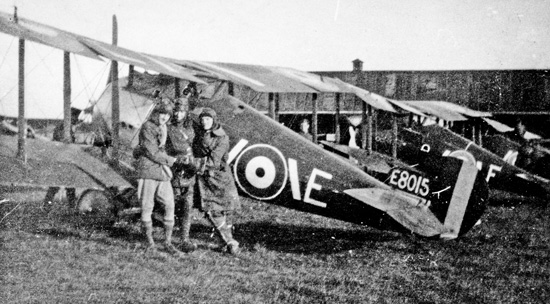
70 Squadron was the first RFC squadron to fly ‘Strutters’ taking them, transferred from the RNAS, to France between end May to end July 1916. They re-equipped with ‘Camels’ from June 1918 and only re-equipped with ‘Snipe’ when already at Bickendorf early in 1919. They still carry their post-March 1918 banded squadron markings. (below)
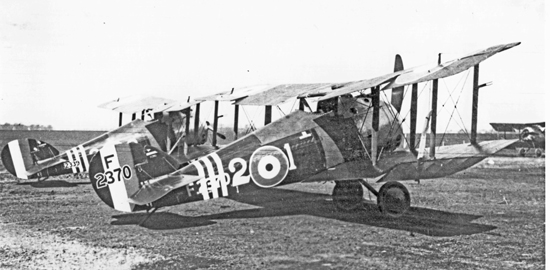
208 Squadron started as No.8 Squadron RNAS at St Pol, Dunkirk in October 1916 with ‘Pups’ and ‘Strutters’ becoming the first completely ‘Pup’ squadron in December and the first RNAS squadron to be attached to the RFC on the Western Front. From April 1917, “Naval 8” had considerable success with Sopwith ‘Triplanes’ before changing to ‘Camels’ from July 1917, still supporting the RFC until 1st March 1918 before re-equipping with new ‘Camels’ in England. They returned to France as RAF 208 Squadron in April and re-equipped with ‘Snipe’ from November 1918. They carry sloping bar squadron markings behind the roundel. (below) and this photograph shows one with the reversed-taper extended upper ailerons and bomb racks under the fuselage.
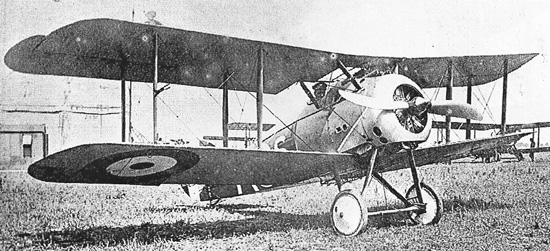
In the 1919 Jacques Schneider Trophy contest at Bournemouth in September, Nieuport and SPAD from France and Savoia from Italy will face formidable opposition from Great Britain where trials are to be held to select the best three of the entries from Sopwith, Supermarine, Avro and Fairey Aviation.
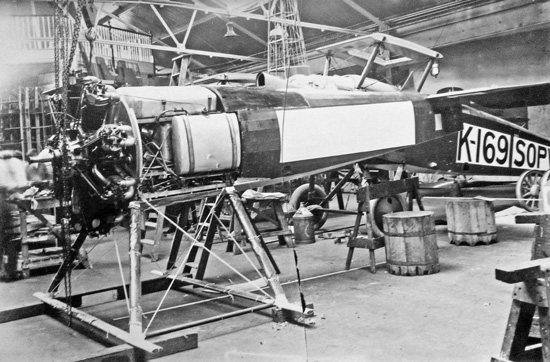
The first image (above) of Sopwith’s 1919 Schneider Trophy floatplane contender in the factory at Canbury Park Road shows the large 450hp Cosmos Jupiter radial engine on a fairly short rounded fuselage packed with fuel and oil tanks with a sturdy float attachment frame. Behind it is Sopwith ‘Gnu’ K169 stored awaiting a buyer.
It is eight months since a pair of experimental 290hp high-compression versions of the 236hp Siddeley Puma engines were delivered to Sopwith’s experimental workshop to be fitted to the first prototype Sopwith ‘Cobham’ triplane bomber in place of the specified 360hp ABC Dragonfly radial engines. The delay may be a combination of the redesign work to incorporate these water-cooled engines and development problems with them compounded by Sopwith’s business focus on developing a range of civil aircraft to help secure its future. Whatever the reason Sopwith’s first ever twin-engined product, ‘Cobham Mk.II’ H671, has apparently finally been completed for company testing at Brooklands and is then to go to Martlesham Heath.
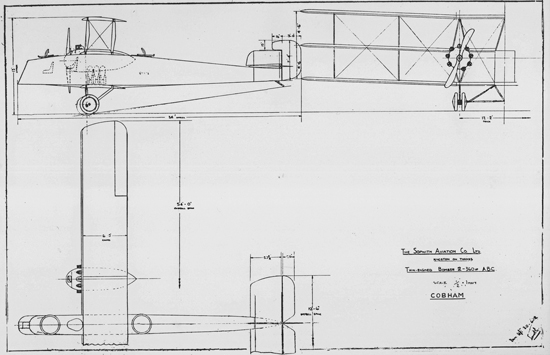
The only differences from the original general arrangement drawing (above) are that the in-line six cylinder Puma engines have been installed in cowlings which fill the gap between the two lower wings and it has more back stagger on the top wing to balance the revised weight distribution. The almost complete second and third prototypes H672 & H673 are to await flight cleared Dragonfly engines. Like its competitors the ‘Cobham’ is a three-seat design with two Scarff ring mounted defensive guns and an internal bomb bay but it is the only triplane. A competing Avro Manchester has been fitted with similar substitute Puma engines for some months, a Boulton & Paul ‘Bourges’ has recently been fitted with substitute Bentley BR2 engines whilst the Airco DH.11 Oxford has had Dragonflys since January but it is not clear if it has spent much time in the air.
On 15th August, ‘Pup’ C478 is written-off at Aboukir in Egypt.
On 16th August, in northern Russia, ‘Camel’ F4055, returning from an attack on a Bolshivik convoy suffers an engine failure and is damaged ending on its nose after hitting a fence forced landing. It is one of at least six Ruston Proctor built ‘Camels’ now reported to be with the RAF in the Syren Force at Limbushi.
Although no further missions are being flown from HMS Vindictive’s deck in the Baltic, her aircraft continue to support British operations against the Bolsheviks shooting down helium filled observation balloons and spotting for ships bombarding targets on the shore. During the night of 17th/18th August 1919, nine of them including ‘Strutters’ and ‘Camels’ attack Kronstadt providing a diversion for successful attacks by Royal Navy coastal motor boats on battleships in Kronstadt harbour.
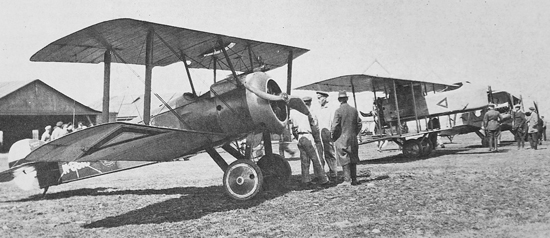
’Ships Camel’ N6616 off-loaded by HMS Vindictive in Estonia back in July has been photographed (above) with Estonian triangular underwing markings beside other Estonian machines at Koivisto in Lithuania where Vindictive’s other ‘Ships Camels’ are currently shore-based.
By 19th August, Sopwith have registered two more ‘Gnu’ G-EAIL and AIM making ten so far and are planning to build at least 4 more. They have also registered four more ‘Doves’ G-E AJI, AJJ, AKH and AKT making nine in total. With no firm sales of either type yet in the UK Sopwith continues to advertise in Flight & Aeroplane journals (below) and are now looking to Larkin-Sopwith to actively market these civil machines in Australia.
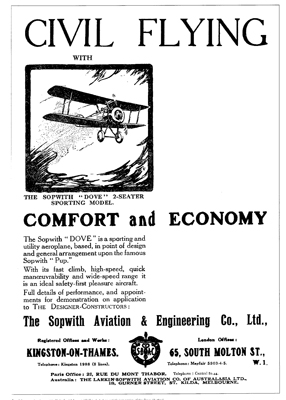
By 20th August, there are five formal entries for the £10,000 prize flight from England to Australia – Bert Hinkler, Charles Kingsford-Smith, Harry Rigby and two aircraft companies not yet declaring the crew names, Alliance Aeroplane of Acton and Martinsyde of Woking. Like Sopwith, both of these companies built trans-Atlantic contenders. Sopwith Aviation have not yet announced that it too is working on a machine for this challenge, the Sopwith ‘Wallaby’, inevitably based around the Sopwith ‘Atlantic’ design.
However their most urgent project is the 450hp floatplane for the Schneider Trophy competition which must be ready for the Royal Aero Club elimination trials on 3rd September at Cowes. It is nearing completion and is to be taken for its test flights to a slipway at Hythe opposite Southampton on the west bank of Southampton Water.
The Government Deputy Chief Valuer and Sopwith General Manager Mr Carey have now agreed £18,000 per annum rent to be paid for the use of the National Aircraft Factory at Ham when it was in full production between 18th August 1918 and Christmas, half-rent for two months before that when it was still being handed over by the contractors and for this year, with Ministry orders drastically reduced, a rent in proportion to the output compared with the output in the wartime months. The long-term future of the factory however is now not to be a lease but an outright sale by the Government. Without Sopwith Board authority, Mr Cary has suggested that the company would be prepared to buy the building and its immediate surroundings, just 10 acres of the 38 acre site, for £50,000 a fraction of the £225,000 cost of construction. The valuer thinks Mr Cary might raise this to £80,000 and recommends that the Director General of Lands seriously considers such an offer even if “Sopwith are obliged to ask to pay by instalments spread over a number of years”. He lists his reasons: “1) That owing to its great height, it is solely suitable for aeroplane assembly and erection, 2) The cost of warming is very high indeed, 140 tons of fuel per week being required in winter time and 3) It is not a place where one would ordinarily put a factory, owing to the fact that it is a considerable distance from any working class population and in a neighbourhood which has been looked upon as far more residential than industrial”. He adds “the building is a curious mixture, the steel stanchions and roof trusses being exceedingly good but the roof and gutters of asbestos sheeting and rubberoid are so weak they will not stand the weight of a man and I understand three fatal accidents have already occurred”. Another ministry official adds that the factory “is far from any railway line” and recommends that any offer of £15,000 or more should be accepted. These recommendations assume that the land which was requisitioned under the Defence of the Realm Act can readily and inexpensively be purchased from Lord Dysart of Ham House.
On 21st August, the pilot of ‘Snipe’ E6202 is killed in a flying accident at the Central Flying School, Upavon.
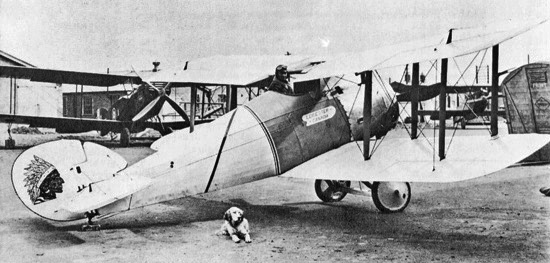
‘Long-range Snipe’ E8213 “City of Leicester” formally handed over to the Canadian High Commissioner at Hendon last January, has been photographed in this most unique colour scheme (above) after being renamed “Leicester Canada”. Earlier this month it was formally taken on charge by the Canadian Air Force but now H S Quigley has had permission to borrow it and enter it at his expense in the Toronto to New York Air Race. However, on 25th August, it is crashed at Toronto while being tested prior to the race.
On 27th August, the Ministry’s Director General of Lands responds curtly to his Deputy Chief Valuer’s advice that they should accept a possible maximum £80,000 offer from the Sopwith Aviation Company for the purchase of the National Aircraft Factory at Ham. He handwrites on the Valuer’s report: “I cannot consider any such offer in view of the prices we are securing for other factories, we had better advertise it.”
By 27th August, 70 & 43 ‘Snipe’ squadrons have arrived at Spittlegate on return to England from the Army of Occupation in Cologne. 208 Squadron are still there but preparing to leave for Netheravon by 9th September.
On 28th August, Ruston Proctor built ‘Snipe’ E7636 to 47 arrive at the Middle East Aeroplane Supply Depot at Aboukir in Egypt, even more replacement machines for 80 Squadron. Meanwhile ‘Baby’ floatplanes N2132 & N2133 are back from 269 Squadron at Port Said joining 268 Squadron at Calafrana on Malta.
Flight journal reports that at Southport, where Sopwith Aviation have the sole concession for passenger flights, a ‘Dove’ and three ‘Gnu’ machines have taken about 1,000 passengers up over the past seven weeks.
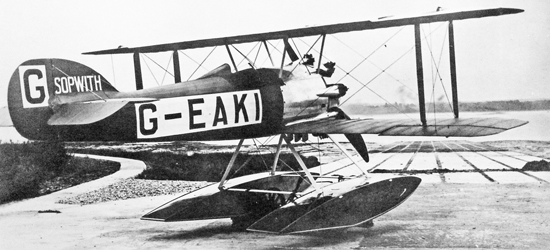
On 29th August, Sopwith’s new ‘Schneider’ floatplane G-EAKI is on the slipway at Hythe which Harry Hawker has decided to use for flight testing. (above) He and his wife Muriel are commuting across Southampton Water to Hythe in his racing hydroplane ‘Kangaroo II’. At first glance a very grown-up version of the 100/130hp Sopwith ‘Baby’, the new ‘Schneider’ floatplane has many interesting features beyond the huge 450hp Cosmos Jupiter engine. Drag reduction has been addressed by the use of simple lightweight unstepped floats and no tail float plus fairings behind each engine cylinder head and the pilot’s head. The fin is smoothly faired into the fuselage and a bulbous lower rudder “continues the fuselage streamlining” whilst rudder and elevator control runs and levers are all contained within the fuselage. The pride and confidence in the new design is slightly dented when Harry Hawker starts the testing. As soon as he brings the engine up to power the aircraft noses into the water with the tail almost perpendicular. Harry struggles to escape from the tiny cockpit and signals to the ground team to urgently pull the tail down. It becomes clear that the short floats have been mounted too far back. Once recovered the machine is rapidly disassembled and loaded onto a lorry to be taken back to Kingston for modifications but the lorry refuses to start. With the elimination trials at Cowes in just five days, time is of the essence. Harry races in his hydroplane across to Southampton, drives his 225hp Sunbeam-powered Mercedes car round to Hythe, hitches up the lorry complete with the aircraft and tows the whole assemblage back to Kingston.
Harry Hawker developed his workshop skills in his father’s small engineering and blacksmith business in what is now a suburb of Melbourne leaving school at 14 to work in local garages and motor companies and going on to become a chauffeur/mechanic whilst building himself a motorcycle and has since owned many cars including an Austro Daimler which he overturned into a ditch at Brooklands in 1917 with an Admiralty representative on board. Harry he was determined to create a truly sporting car and at their home in Hook was soon modifying a 35hp Mercedes chassis to take a 225hp Sunbeam aero engine with a huge low ground clearance flywheel and an aircraft radiator. He designed the aluminium body and Muriel helped him construct the 7ft long bonnet. (below, Harry with the Sunbeam- Mercedes outside the west doors of the Ham aircraft factory. Note the Sopwith Aviation Co name.)
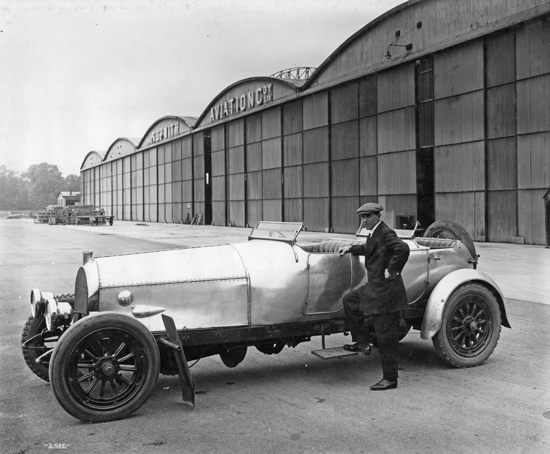
On 31st August, the Sopwith ‘Schneider’ G-EAKI is back at Hythe for testing with the floats repositioned. (below) After an engine test (below) the performance in flight exceeds expectations with a reported top speed of 165mph or more. The Sopwith team are finally ready for the elimination trials at Cowes on 3rd September.
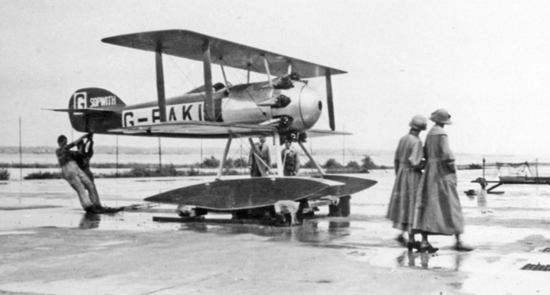
Meanwhile, in Northern Russia on 31st August, ‘Camel’ F4055 is damaged in a forced landing and the RAF pilot is taken prisoner by the Bolsheviks.
After 137 aircraft delivered in January, 100 in February, 61 in March, 68 in April, 92 in May, 64 in June and 92 in July the Sopwith factories deliver just 14 ‘Dragon’ radial engined ‘Snipe’ aircraft in August. With only 129 more aircraft on order Sopwith are cutting right back on employees at the Ham factory. The August wage bill was half that of July and one fifth of October 1918 their highest employment month. Sopwith’s Canbury Park Road workforce is also being reduced as they finish the components for the outstanding military orders and start to change the skill mix and convert the main workshops for ABC motorcycle production.
The number of new Sopwith aircraft from other contractors after 415 in January, 249 in February, 304 in March, 341 in April, 229 in May, around 250 in June and 146 in July is around 52 in August. This month’s total comprises 36 ‘Snipe’ from Boulton & Paul (13), Ruston Proctor (22) and a final one from Coventry Ordnance Works plus 11 ‘Salamander’ from Wolseley Motors whilst Blackburn have probably delivered another 5 ‘Cuckoos’.
This is the last month of surviving official records of aircraft deliveries into military service. These records do not distinguish between aircraft taken on charge after flight testing and those taken into storage without engines or even taken on as unassembled sets of parts for spares. From the best available sources the total numbers of Sopwith aircraft built to date is 3,546 by Sopwith themselves with 129 still on order and 14,646 from all British sources with 342 still on order. Had the war continued into 1919 the Sopwith aircraft total would have risen to at least 20,000 with the addition of the orders for over 5,000 aircraft which have been cancelled since November 1918. None of the above figures include Sopwith aircraft built overseas most notably the 4,200 Strutters built in France.)
After the peak total of 22,796 aircraft on charge in the Royal Air Force on 31st December 1918 that number has fallen to 17,450 by the end of August 1919. The total of Sopwith designed types is still almost 25% of the total but the 1,029 ‘Dolphins’ and 62 ‘Strutters’ have joined the ‘Camels’ and ‘Pups’ in the obsolete category leaving 1,775 ‘Snipe/Dragons’ and 543 ‘Salamanders’ as front line Sopwith landplanes alongside 449 uncategorised “ship aeroplanes” comprising 198 ‘Ships’ Camels’, 61 ‘Ships’ Strutters’, 3 ‘Ships Pups’ and 187 ‘Cuckoos’.
On 2nd September, Sopwith ‘Bulldog’ X3 leaves Orfordness after 14 months. An engine cut-out at 500ft within sight of its Hendon destination forces an emergency landing in a small field running hard enough into a tree to push the engine right back. The pilot is injured around his eyes from his goggles when thrown forward on impact.
On Wednesday 3rd September, the three Royal Aero Club officials patiently await the arrival of the four British Schneider Cup contenders at Cowes for the elimination trials. Word comes through that the Supermarine flying boat was only completed late last evening on the arrival of a propeller from a factory which has been on strike and after waiting for the deluge to stop this morning the tide has dropped too low to launch it from their slipway at Woolston.
At 2pm, Fairey floatplane G-EALQ arrives with a “very slow and perfect landing” and taxies to the slipway at S E Saunder’s yard. It is experimental carrier-based seaplane N10 built for the Admiralty in 1917 which Fairey have bought back, converted to a single seater, fitted a 12-cylinder three-bank water-cooled 450hp Napier Lion engine and reduced the 46ft span two-bay wings to 28ft span single-bay. It has Fairey’s full-span variable-camber gear on the lower wings, hence the “very slow” landing.
Next a small black speck on the horizon grows rapidly into the Sopwith floatplane, passing overhead and landing on the east side of the harbour. The landing is fairly fast but it quickly starts sinking into the water until the engine is opened up again and the machine makes rapidly for the beach on the opposite side to Saunder’s yard. With Harry Hawker sitting on the port wing tip and a rowing boat under the starboard wing it is brought across the river with floats nearly submerged and the tail plane awash. (below)
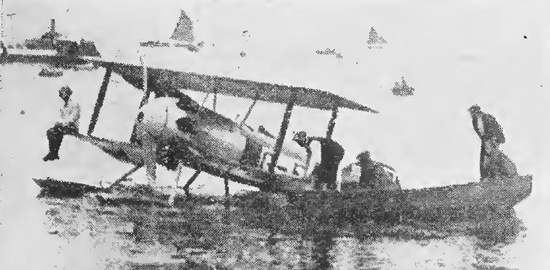
On lifting the machine out of the water it is discovered that 2 sq ft of bottom of the starboard float is missing and the port one is also punctured. Harry Hawker believes the main damage occurred taking off at Hythe when he hit something in the water. A motor-boat arrives from Hamble with Mr A V Roe, the pilot and the designer of the Avro floatplane to explain that it has hit a floating bully beef tin while taking off at Hamble which has wiped the step off one of the floats. Later the Supermarine team arrive by boat to explain that they heard of Harry Hawker’s mishap, concluded that the trials would be washed out and had, therefore, not brought their machine across. The whole day has proved rather a fiasco. The officials announce that the Fairey and Sopwith machines are worthy contenders and the Supermarine and Avro machines should meet next Monday to decide the third British representative. Harry Hawker supervises the removal of the damaged floats and ties them securely on the bows of his hydroplane ‘Kangaroo II’. With his sister-in-law on his wife’s lap in the second seat and two workmen sitting on the stern he sets out towards the Solent. Rounding the bend out of Cowes harbour the slender high-powered boat flips right over pitching them fully clothed into the sea. Harry checks all are safe and gets a non-swimmer to a float. Eventually a launch picks them up and tows the hydroplane to the shore. Harry works on the wet magneto of the hydroplane whilst the others get back to Southampton by steamboat. It is 9pm before Harry gets his boat’s engine running and after a further magneto problem in the middle of the Solent it is 11pm before he reaches the hotel in Southampton still in his wet clothes. New floats are urgently needed from Kingston with the race just seven days away.
Some of the twelve Sopwith ‘Pups’ bought for the Australian Air Force are currently touring districts of the country on Peace Loan flights with the legend “Buy Bonds” under the wings. For many people it is the first time they have seen an aeroplane and they draw a crowd wherever they land. (C528 below)
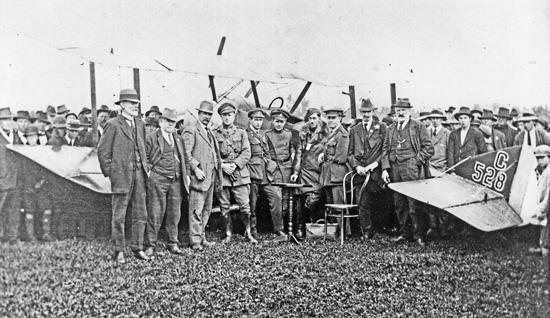
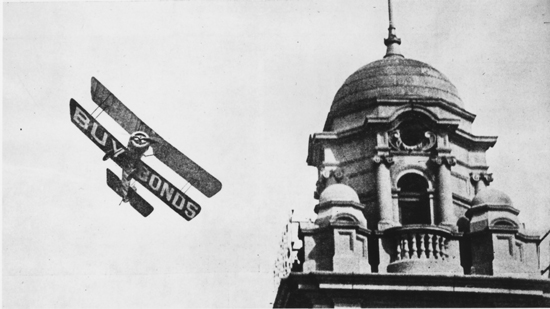
“Buy Bonds” Pup C523 is photographed circling Hobart General Post Office (above) and on 4th September carries the first “Tasmanian Aero Mail” between Hobart and Launceston.
On 6th September, No.186 Torpedo Development Squadron at Gosport practise their ideas for a mass daylight torpedo attack. Eleven Sopwith ‘Cuckoos’ in two flights attack the Second Battle Squadron of the Atlantic Fleet moored in Portland Harbour. Eight carry torpedoes with dummy warheads and three carry smoke bombs. The first flight of five torpedo aircraft and two smoke bombers attack from over the land, making hits on the battleships Barham, Malaya and hitting Implacable twice. The second flight of three torpedo aircraft and a single smoke bomber, benefiting from the distraction caused by the first flight, make an undetected attack hitting Queen Elizabeth with two torpedoes. Only two of the torpedoes dive to the seabed largely confirming the effectiveness of the squadron’s preparation for the shallow water in Portland Harbour with ‘the centre of pressure of the torpedoes being brought further aft by the drogues, which are towed for about 50 yards and then disengage.’ (below, an aircraft and torpedo splash in the harbour and recovered successful torpedo heads)
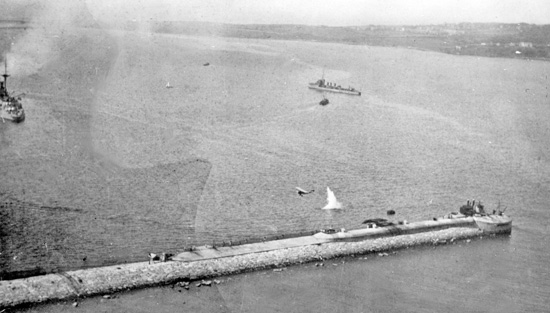
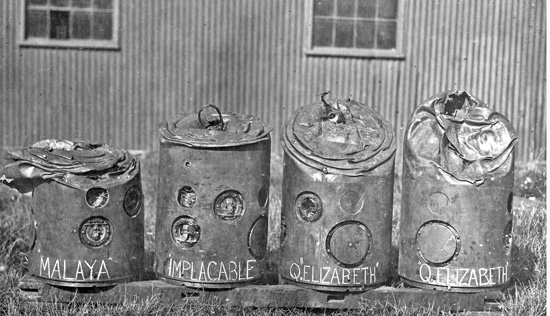
The two French Nieuport floatplane entries for the Schneider Trophy race have both crashed being tested on the Seine but the short-span one has been repaired and flies to Cowes from Paris via Brighton in 2½ hours on Sunday 7th September. On landing it strikes a buoy, breaking the floats and undercarriage before sinking. In the spirit of sportsmanship Sam Saunders has agreed to have S E Saunders’ aircraft fitters work day and night to remake the wings and rebuild it with a spare engine and floats from France.
By Monday 8th September, Avro 539A floatplane G-EALG has had its fin extended forward and a horn balanced rudder fitted whilst replacement floats are built. It is flown to Cowes for the Royal Aero Club to select the third British competitor for the Schneider Trophy race on Wednesday but the Supermarine Sea Lion flying boat G-EALP is chosen largely due to its landing and take-off performance. The Avro is to be Britain’s reserve entry. Meanwhile, Harry Hawker has been carried out piggyback to his 450hp Sopwith machine for a successful test with its latest pair of floats (below) whilst the second Nieuport has left Paris but comes down in the English Channel. The pilot clings onto a float overnight before being found and rescued Tuesday morning.
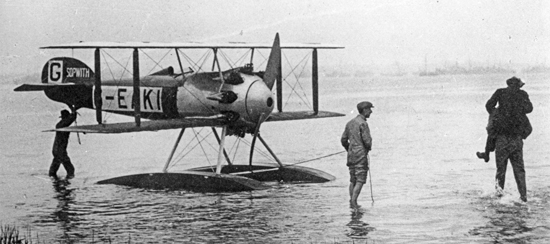
On Tuesday 9th September, the 300hp SPAD S.20bis floatplane which arrived by ship from France is tested at a disappointing 154mph and they decide to crudely saw over 2ft off each of the upper wing tips roughly patching and doping over the ragged edges. The 200hp Isotta-Fraschini powered Savoia S.13 flying boat having been reduced to a single seater and having had its wings clipped to a single bay has arrived safely by rail from Italy. The S E Saunders sheds are sheltering an exotic collection of foreign competitors.
By lunchtime on Wednesday 10th September, the weather is good as the aircraft make their way to Bournemouth for the 2.30pm start of the Schneider Trophy race. The Supermarine Sea Lion ties up to their launch ‘Tiddlewinks’ whilst the reserve Avro arrives and is towed by boat to the beach. The starboard float of the chopped-upper-wing SPAD is damaged on landing and starts sinking. It eventually has to be drawn up on the beach. The Sopwith machine, clearly the fastest on its fly-by, is also drawn up on the beach (below) and is soon also engulfed in a large uncontrolled crowd.
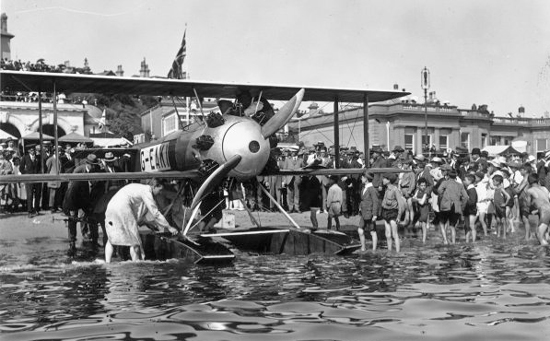
As the due start time arrives the clear view from Bournemouth of the other two turning points around the 20 mile triangular course becomes obscured by fog rolling in on the faintest of breezes. The Nieuport 29 floatplane rebuilt over the last two days by S E Saunders arrives late but a float is damaged as it is pulled onto the beach. Despite hurried attempts to repair their floats both French contestants have to retire. It is 4.30pm before it is considered clear enough for the first competitor, the Fairey floatplane, to set out but as he approaches the first turning point he finds Swanage Bay still full of fog hiding the mark-boat with only the tops of the cliffs to be seen. He returns to Bournemouth deciding it is too dangerous and withdraws from the race. The Supermarine flying boat also fails to find the mark-boat, loses his bearings and lands to avoid hitting the cliffs. On take-off he hits a floating object which holes the hull. On his first planned landing at Bournemouth the machine fills with water and turns half over. He is rescued and the aircraft salvaged by Supermarine’s boat.
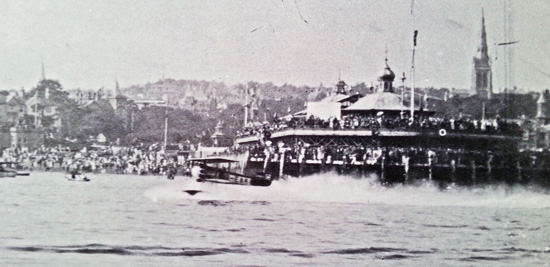
Harry Hawker in the Sopwith machine (above, taking-off between the luxury yacht being used as the Royal Aero Club official’s boat and Bournemouth Pier) also fails to find the Swanage mark-boat. Landing back at Bournemouth on a hard flat sea he damages a float and has to be beached listing heavily to starboard.(below)
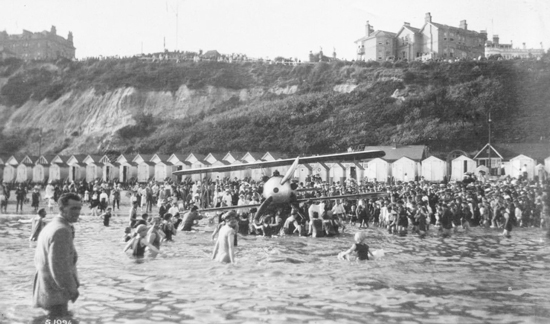
Meanwhile, the third man out, the Italian Guido Jannello in his chopped-wing 300hp Savoia flying boat has set off. After immediately completing his two mandatory touch-downs, he appears back over Bournemouth at regular intervals and lands safely after eleven laps to use the last ten, uninterrupted by landings, for the speed record. Concerned that Jannello’s lap times indicate he cannot have been completing the full lap distance his team send him off for yet another lap to ensure he has done 200 miles despite low fuel level. He does not re-appear at Bournemouth and, after growing concern, much later in the fading light is towed to the beach by a speedboat. The Italian team race off in the speedboat to join the others at Cowes to be told that the Swanage mark-boat have reported that they have never seen the Savoia. When asked to pinpoint the location of the southerly mark-boat Jannello points to Studland Bay not Swanage Bay. The spare red-and-white RAF mark-boat was moored in Studland Bay. The Italians are disqualified and the race is declared void. Four of the six competitors are stranded damaged on Bournemouth beach and have to leave the next day by road including the Sopwith ‘Schneider’ floatplane. (below)
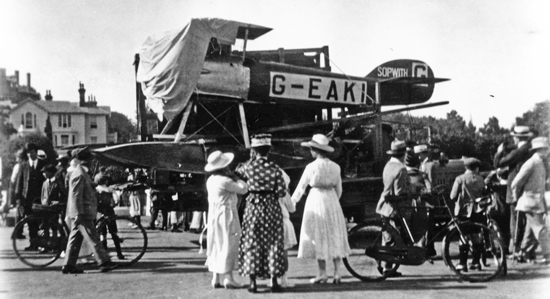
Whilst the Italian team prepare to protest their disqualification, the Royal Aero Club officials decide to pass the final decision to the FAI recommending that at the very least the next race should go to Italy. Like the Italians, other competitors and observers complain about the poor organisation citing the choice of an unsupervised public beach without even providing nominated support/mooring boats, failing to adequately communicate with the competitors as the situation changed through the day and failing to properly check the visibility all around the circuit before starting the race.
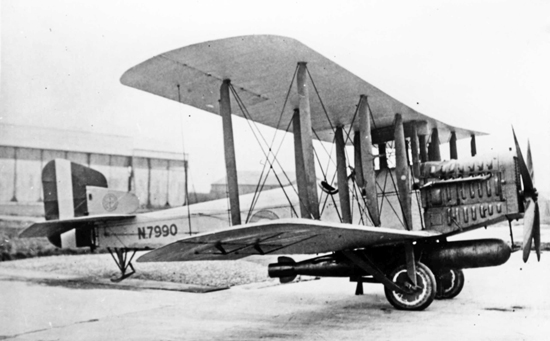
On 11th September, ‘Cuckoo’ N7990 arrives at Grain for type and performance trials experimentally fitted with a 275hp Rolls-Royce Falcon III engine and known as a ‘Cuckoo III’. (above) The almost circular radiator and curved engine cowl are gone, replaced by a more rectangular radiator matched with a heavily louvred flat-sided engine cowl.
Meanwhile, Britain’s first purpose-built through-deck aircraft carrier HMS Hermes is launched from the yard of Sir W G Armstrong, Whitworth & Co on the Tyne but it is apparently not to be proceeded with at present. 548 ft long and 70 ft beam, she will have a displacement of 10,950 tons and a speed of 26 knots. The funnels are arranged horizontally and there is an “island” superstructure on the starboard side of the flight deck as satisfactorily tested with a mock-up island on the flat-top carrier HMS Argus.
A meeting of creditors of the Whitehead Aircraft Co, Richmond upon Thames has resolved that another petition be raised to put the company into voluntary liquidation despite the Judge’s three previous rejections. The Company’s claim of solvency hinges on a disputed large sum “owed to them by the government”.
The Australian Air Force “Buy Bond” marked ‘Pup’ C523 which carried the first “Tasmanian Aero Mail” between Hobart and Launceston last week has suffered a broken push rod and forced landing flying on to Devonport. The replacement parts have been shipped over from Melbourne and on 13th September it is flown to Wynyard only to strike a tennis court fence on landing at the recreation ground. The propeller is shattered, the wings damaged and the fuselage strained. C523 is taken back to Hobart and displayed outside the Commonwealth Bank building awaiting more parts. There is also now a privately owned ‘Pup’ in Australia. New Zealander Charles Pratt who was taught to fly in 1917 at Heliopolis, has bought from RAF disposal stocks in Egypt an Avro 504, two DH6s and ‘Pup’ C476. He has shipped them to Australia setting up the Geelong Air Service and is photographed standing by the tail of his ‘Pup’. (below)
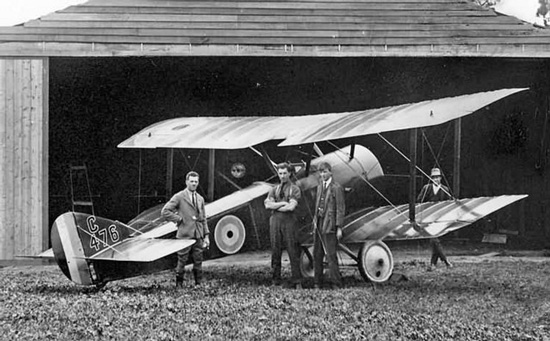
The latest project in Sopwith’s experimental workshop is a challenger for the £10,000 prize for the first flight from England to Australia. The fuselage is built and fitted with a 360hp Rolls-Royce Eagle 8 engine in front of the huge fuel tank. (below)
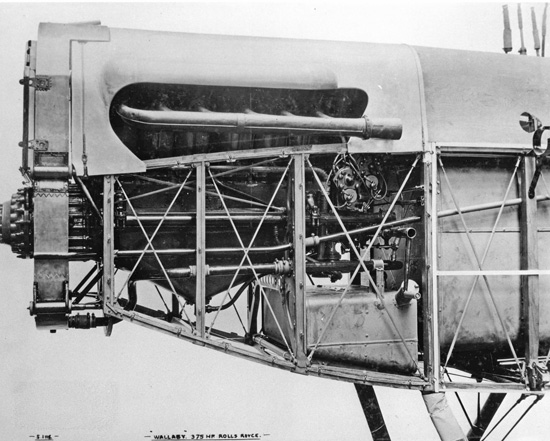
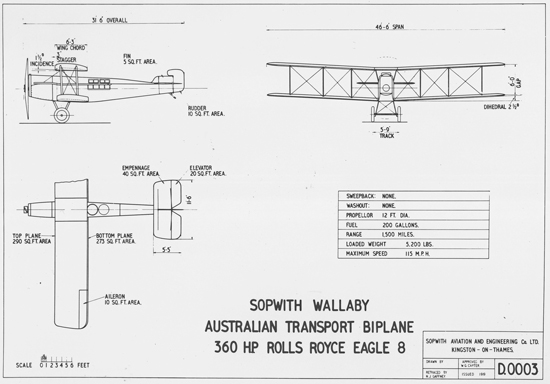
The general arrangement drawing (above) shows the ‘Wallaby’ to be very similar to Harry Hawker’s ‘Atlantic’ with identical wing span and chord albeit now three bay. Dual-control tandem cockpits in a slimmer fuselage have seats that can be lowered to use the side and floor windows when the protective cockpit lids are in place. There is no lifeboat and about half the fuel load. The pilot is to be Cpt Matthews, one of four Australian pilots engaged by the Larkin-Sopwith Aviation Co. for its ambitious plans for civil aviation in Australia.
On 17th September, in the Baltic New Zealander Lt Dawson Unwin goes missing during a raid on Kronstadt flying a ‘Strutter’ from HMS Vindictive.
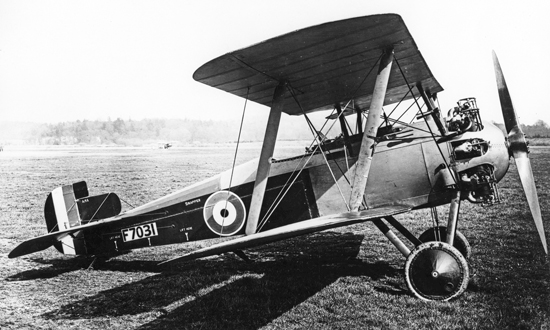
The first of three Sopwith ‘Snapper’ high-altitude fighter prototypes F7031 was photographed at Brooklands in April or May (above) after waiting over seven months for a flight cleared 360hp ABC Dragonfly engine. Apart from this engine it is ‘Pup’ like in appearance but with twin Vickers guns and longer span wings. It has been at Martlesham Heath for performance trials for the last few weeks now with a large spinner in front of a larger engine cowl (below) and modified lower exhaust pipes to heat air going into the carburettors. Testing is being hampered by engine problems but it has been recorded at a creditable 138mph at 10,000ft.
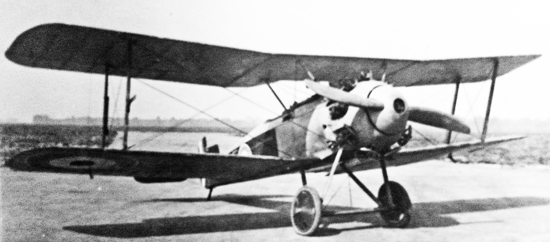
Now Sopwith ‘Snark’ F4085 is on trial at Brooklands. (below) It is the Sopwith’s alternative Dragonfly powered high-altitude fighter prototype and like the ‘Snapper’ has been waiting months for a flight cleared engine.
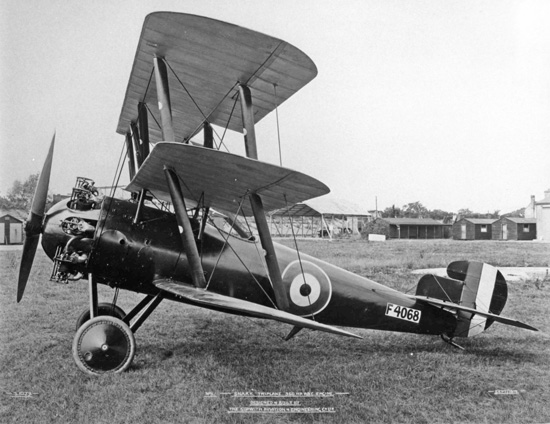
The ‘Snark’ has a wooden monocoque fuselage encompassing two Vickers forward firing machine guns as pioneered in the smaller Sopwith ‘Snail’. The triplane wings have less stagger on the upper bays and six ailerons for high-altitude performance and handling. If the engines can be made reliable it could become the RAF’s first six-gun fighter as there is provision for an additional four Lewis machine guns, two under each bottom wing outboard of the propeller with access panels in the top of the wing to load the ammunition. (below)
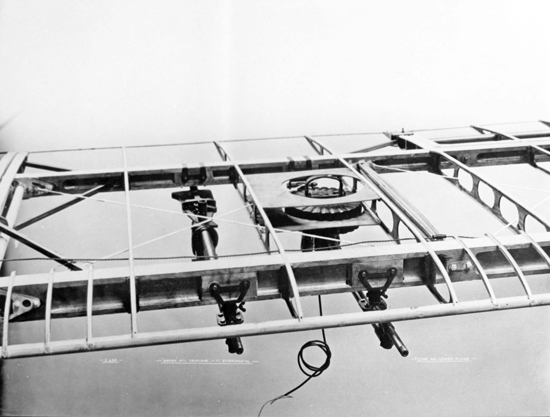
With no firm sales for their civil aircraft at home Sopwith have now shipped ‘Doves’ K157 & K168 off to Larkin-Sopwith Aviation Co. in Australia.
One of the few standard production Sopwith “Dragon” J3726 fitted with a flight cleared engine has gone to Farnborough for evaluation and they are not impressed. They report that three of the eight wing struts are bowed and useless as is the fourth port vertical fuselage strut from the tail which has been replaced with some difficulty due to the fabric only being laced on the other side. There is concern about the use of rubber joints along the fuel system which with the slightest leak would put the venturi tank pressure system out of action whilst the heater muff is a design Farnborough have already condemned. There are issues with various controls in the cockpit being difficult to use and the compass being positioned between the guns surrounded by steel. (below) There is approval of the installation and accessibility of the twin Vickers guns, ammunition boxes and Type C Constantinescu hydraulic synchronising gear but there are “no jamb [sic] clearers or devices for holding up the rear covers to get out the locks should a gun stoppage occur”.
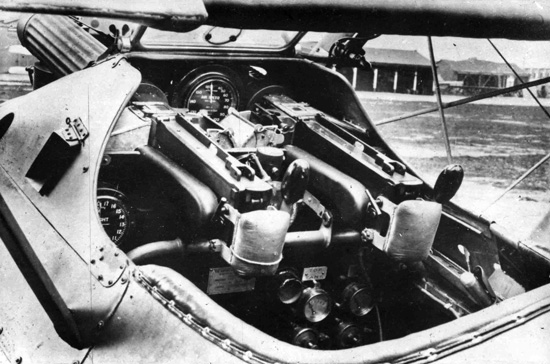
Meanwhile the Dragonfly engine in their ‘Snipe/Dragon’ prototype B9967 fails in flight after 32hrs 20mins flying time, 38 hours total running. A broken exhaust valve smashes a piston and falls into the crankcase jamming between two connecting rods and the balance weight bending the rods. (below)
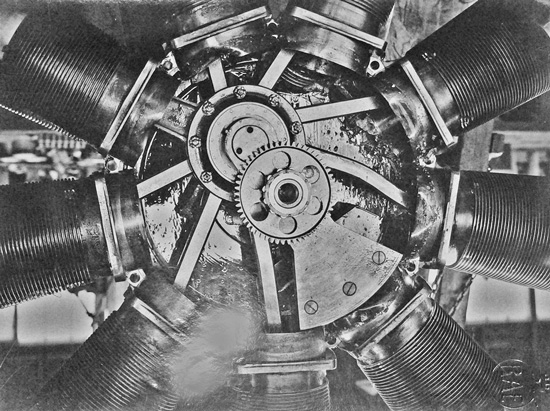
The full engine strip-down reveals broken exhaust ports and inlet valve locking nuts and serious carbonisation on the induction side. The embarrassing decision to cancel the Dragonfly engine programme seems increasingly likely. Those who approved orders for over 11,000 engines from 17 contractors as the future standard RAF air-cooled engine have moved on and there are no foreseeable solutions to the vibration, cooling and reliability issues. There are prototype next generation RAF aircraft still awaiting Dragonfly engines all around the country in addition to the 124 Nieuport Nighthawks and 230 Sopwith ‘Dragons’ being completed. Hundreds of engines are still being built mostly by Vickers at Crayford but only a dozen or so have actually flown.
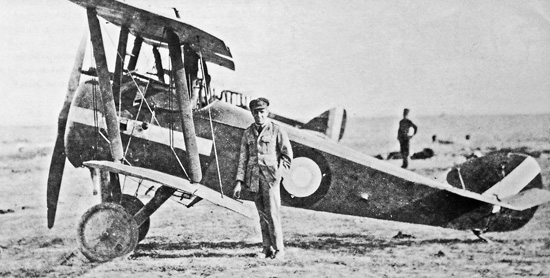
Since June, the White Russian 1st Kuban Aviation Otyrad (Squadron) has had a few ‘Camels’ at Beketovka in southern Russia like F1956 (above) overpainted with their white tail stripe, a white fuselage side stripe and Russian roundels – white centre, blue ring and red outer ring.
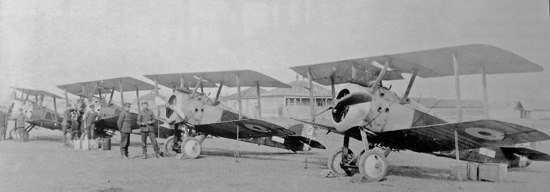
In the last two weeks B Flight of RAF 47 Squadron has received eight ‘Camels’ at Yekaterinodar (above) and has now joined the 1st Kuban Otyrad at Beketovka. On 30th September 47 Sqdn’s F1955 claims victory over a Red Russian Nieuport, co-incidentally of their 47th Aviation Otryad.
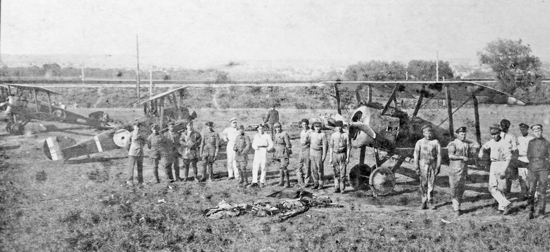
Also in southern Russia are a few ‘Camels’ of the 6th Aviation Otryad of the White Russian Volunteer Army mostly still carrying British markings (above) but F1954 has had the roundel overpainted with the skull and cross bones emblem of the assault brigade they are supporting. (below)
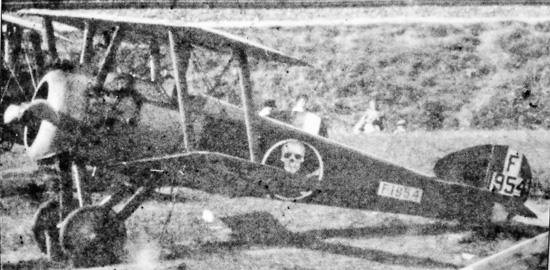
After 92 aircraft delivered in July and just 14 aircraft in August, the Sopwith factories squeeze out the final 17 ‘Salamander’ and around 50 ‘Dragons’ in September, the last month of their financial year. This leaves fewer than 60 aircraft to deliver, underlining the urgent need to get volume ABC motorcycle production under way if they are to maintain a sustainable sales income.
It is estimated that the number of new Sopwith aircraft delivered by other contractors in September is between 50 and 70, very similar to August. These are mostly ‘Snipe’ from Boulton & Paul, Ruston Proctor and Portholme plus most if not all of the final 14 ‘Salamander’ from Wolseley Motors and the final 6 ‘Cuckoos’ from Blackburn. Ruston Proctor have recently been instructed to stop work on their last 32 ‘Snipe’. By sending parts for 23 machines to Portholme for completion Ruston Proctor will finish ‘Snipe’ production next month. Most recent ‘Snipe’ output has been delivered directly to store without engines.
By 1st October the particulars and conditions for the sale of National Aircraft Factory No.2 by public tender have been approved by the Disposal Board for immediate release now Lord Dysart’s agent has agreed to sell the land at Ham to the Ministry for £500 per acre plus compensation for the gravel already extracted from the site. There are other conditions: Buildings must be no higher than the existing National Aircraft Factory, use electrical power and carry out no noisy trade whilst the site is to be screened with more trees and a 40ft road constructed up the north-east side to provide access to the “Dysart back lands”.
On 2nd October, Flying Officer Culley in ‘Ships Camel’ N7119 bombs a Bolshevik Russian ship in dry dock at Krondstadt.
On 3rd October, the Sopwith ‘Wallaby’ is photographed at Brooklands. (below) The rear view shows the main structural differences from the Sopwith ‘Atlantic’, the tandem cockpits in a narrower fuselage and the three bay wings.

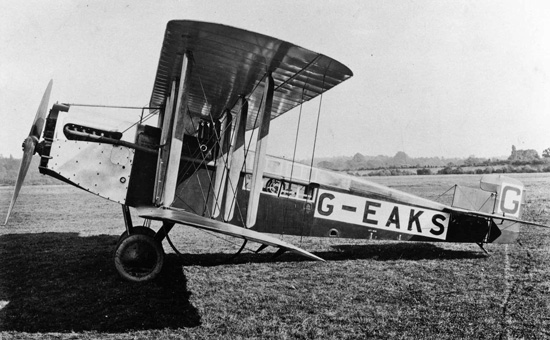
The side view show the two rows of Triplex windows either side of the tandem seats to use when the seats are lowered by some twelve inches and the cockpit openings covered by sliding panels for weather protection. The pilot’s rudder pedals are duplicated one above the other for use at either seat position. Four of the windows can be opened and there is a fresh air pipe from the front of the radiator. There are gravity fuel and water header tanks under the top wing centre section. The wingtips are protected by underwing bumpers. Harry Hawker will probably make the initial test flights but the Australian crew are no doubt keen to start flying it. 36 years old Cpt Matthews was a master merchant marine navigator before the war, learnt to fly in 1917 and became a Flight Commander in No.4 Australian Squadron flying Sopwith Camels. He has flown 21 aircraft types and recently been at Sopwith Aviation preparing to fly this one whilst Sgt Kay has been on an engine course at Rolls-Royce. Kay is not a qualified pilot but is to be trained as the relief pilot during flight testing at Brooklands. The aircraft has dual controls with an adjustable tailplane for trimming the aircraft.
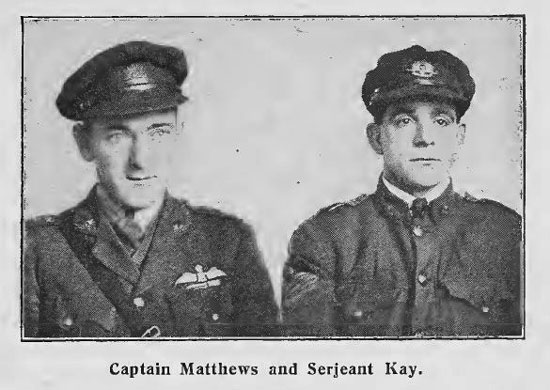
Cpt Matthews is determined to use his maritime navigation skills to the full. His front cockpit has two pull-out map trays with clips for dividers, parallel rulers etc. and his cockpit opening is surrounded by a circular aluminium beading marked out in degrees for use with his sextant. There is one large and two small compasses and a unique “turn indicator” for blind flying. A window in the floor in front of the pilot is marked out with a grid to assess drift, the difference between the direction of travel across the ground and the compass heading of the aircraft. There are also racks for automatic igniting smoke bombs to assess drift when over the sea. Behind the second cockpit are lockers for food and other necessities. They can also carry a spare propeller. The aircraft is designed for conversion to carry eight people on routes up to 500 miles in Australia by altering the cabin arrangement and size of the fuel tank.
The damaged Australian Air Force “Buy Bonds” marked ‘Pup’ C523, which has been on display in Hobart awaiting parts, resumes flights on 3rd October. It is to visit each community in Tasmania which reached its quota of contributions to the Peace Loan but progress is hindered the very next day by the need to repair a broken axle. On 4th October, Flying Officer Culley is out again dropping four bombs on a Bolshevik destroyer from ‘Ships Camel’ N8184 before suffering an engine failure and making a forced landing on a Finnish beach.
On 6th October, Flying Officer Culley is out yet again from Koivisto in Finland this time dropping two bombs on a railway station near Petrograd from ‘Ships Camel’ N6612. (Stuart Culley is the pilot who shot Zeppelin L53 down in flames off Heligoland Bight in August 1918 flying ‘Ship’s Camel’ N6812 from a destroyer-towed lighter.)
By 7th October, the Public Tender document for the sale of National Aircraft Factory No.2 at Ham is printed ready for distribution. The description is on a single page (below) with the purchase site acreage open for discussion. There are two pages of conditions plus financial terms and arrangements for the potential owners to study before making an offer. Terms include a 10% payment on acceptance of an offer prior to completion.
On 7Th October, in southern Russia RAF 47 Sqdn ‘Camels’ F1955 and F1957 each claim a Bolshevik Nieuport victory whilst escorting a bombing mission on Dubkova.
On 9th October, Major Collishaw in ‘Camel’ F6396 claims a Bolshevik Albatros which crashes into the banks of the Volga in southern Russia. It is his 60th victory all in Sopwith aircraft – 2 in ‘Strutters’ in 1916, 2 in ‘Pups’, 34 in ’Triplanes’ and 2 in ‘Camels’ in 1917 then 19 more in ‘Camels’ June to September 1918 and now one more. He is commanding officer of 47 Sqdn which, with growing criticism of British direct involvement in the Russian domestic conflict, is being disbanded to become B Flight, A detachment RAF Instructional Mission South Russia with the survivors of its eight ‘Camels’ being nominally handed over to Nos 11, 12 & 13 White Russian Squadrons.
During flight trials from Brooklands, the performance of the Sopwith ’Wallaby’ is meeting expectations with a maximum speed of 121 mph, a cruising speed of 107 mph at 5,000 ft and a cruising range of 1,500 miles. (below)
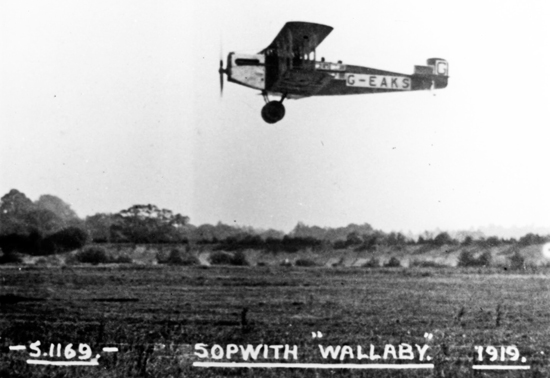
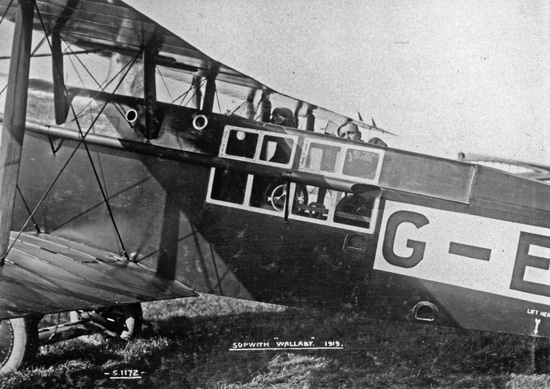
Ex-Australian Flying Corps Capt George Campbell Matthews and Sgt Tom Kay can now take the opportunity to familiarise themselves with handling the machine whilst finalising their arrangements for the flight to Australia. From his 12 years pre-war as a navigator at sea in the Australian mercantile marine Cpt Matthews holds an extra-master’s certificate and claims an intimate knowledge of the Malay Archipelago, the Celebes Island, and other islands of the Pacific. Surprisingly, the ‘Wallaby’ will carry no wireless, this being heavy and not considered a necessity.
Not eligible for the competition but determined to be the first to fly to Australia is the very experienced French test pilot Etienne Poulet. Poulet sets out from Paris with mechanic Jean Benoist on 14th October, in a Caudron G4 with two 80hp Le Rhône engines. Etienne Poulet is paying for the flight himself in memory of the great French aviator Jules Védrine who was planning a round the world flight including Australia before his death earlier this year in a flying accident.
Meanwhile the first two Sopwith aircraft for the Larkin-Sopwith Aviation Co of Australasia Ltd arrive in Melbourne by boat and reach their airfield nearby at Glen Huntly on 15th October.
N106, the seventh and final Grain ‘Griffin’, is finally ready for erection over a year after the sixth one. ‘Griffins’ have only operated from HMS Vindictive and N105 is still with her in the Baltic despite ditching into the sea in August. The original prototype ‘N50’ converted at Grain from single-seat Sopwith built ‘B1 Bomber’ has at some point been fitted with a hydrovane (below) but this does not seem to have been fitted to the others.
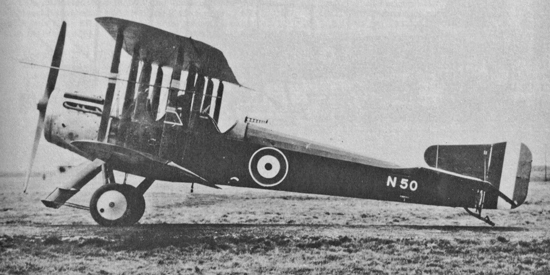
The ‘Ships’ Strutter’ and ‘Griffin’s’ shipboard reconnaissance role is to be taken over by Parnall ‘Panthers’ despite their slower speed, lower ceiling and slower climb than the Griffin with the same Bentley BR2 engine. Parnall have fallen out with the Air Ministry over the cancellation of a second order for 162 Panthers and most of the first order for 150 Panthers has been willingly taken on by the British & Colonial Aeroplane Co. also situated in Bristol.
On 14th October, the Sopwith Aviation & Engineering Co board unanimously agree not to make a formal bid to purchase the National Aircraft Factory No.2 at Ham, “it should be vacated as soon as possible removing all the company’s stores and machinery”. They will also seek to let their waterside premises at Woolston, Southampton. After debating abandoning aircraft manufacture altogether “due to the very low demand in the next few years” all agree that it would be impossible to take it up again and resolve to continue design and experimental work at a cost limited to £10,000 a year including advertising plus any profit made by the sale of experimental machines. On ABC motor cycle production, Mr Fowler states that six will be completed next week, numbers increasing slowly thereafter but it will be “about two months to turn them out on a real production basis”. He is to urgently report on the extent of the delays and the scrap due to ABC Motors so they can consider taking action against them. Due to the high cost of production it is agreed that the price must be increased from £85 whilst agreeing that purchasers should get a three months guarantee. A further issue is whether the ABC Skootamota is by law a motor cycle and ABC are breaching their agreement with Sopwith by having them built elsewhere. They decide to urgently pursue their own “cheap motor bicycle” providing facilities for Mr Bennett to build a prototype.
On 14th October, in the Baltic Flying Officer Culley in ‘Ship’s Camel’ N7140 bombs Krasnaya Gorka, repeating this the next day and gunning a fort. On 16th October, he is out in ‘Ship’s Camel’ N7106 bombing a Bolshevik destroyer. On 18th October, in N7140 he bombs a fort at Kronstadt, the next day again bombs Krasnaya Gorka before attacking a kite balloon and on 20th October, is back bombing Krasnaya Gorka.
Etienne Poulet, who set out for Australia from Paris on 14th October in the low-powered slow Caudron G4, landed at Fréjus the first day, only reached Genoa the second day due to strong winds, Rome the third day battling through snow over the Apennines, then Naples. On 20th October, after two days in Naples they leave for Salonica through heavy cloud, sleet and snow before a strong gale over the Adriatic carries them to Valona in Albania.
Meanwhile, by 20th October, Cpt Matthews and Sgt Kay and their Sopwith ‘Wallaby’ are the first of the qualifying competitors ready to attempt a flight to Australia to claim the Australian Government £10,000 Prize. The expected route is about 12,000 miles over France, Italy, Greece, then across the Mediterranean to Egypt, through Mesopotamia, along the north coast of the Persian Gulf to Karachi, then cross India to Calcutta, down the Malay Peninsula, landing at Rangoon and Singapore, and on to Batavia, then along the Dutch East Indian Islands to Timor and finally to Port Darwin on the north coast of Australia. The longest sea passages are the 300 miles across the Mediterranean and the 400 miles from Timor to Australia. The Air Ministry have offered all possible facilities in connection with their establishments on the route to India, and beyond that point dumps of fuel have been established at 500-mile intervals by the Shell Marketing Co and the Wakefield Oil Co. Under favourable conditions, Cpt Matthews hopes to average about 90 miles an hour whilst in the air, but he will not fly more than about five hours per day. The terms of the prize allow a maximum time of 30 days but Cpt Matthews points out he is, as a member of the Larkin-Sopwith Company of Australia, far more interested in demonstrating the utility of the single-engined aeroplane for long distance flights than in winning the cash prize, although he will do his best to win it.
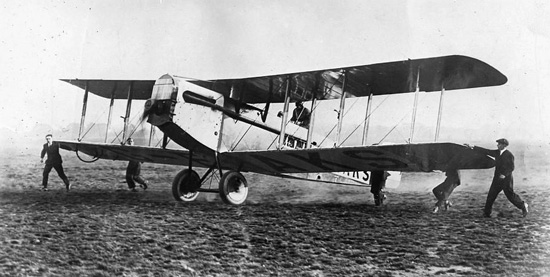
On 21st October, Matthews and Kay fly the ‘Wallaby’ to Hounslow Heath the official starting point for the competition and have it checked and sealed by Royal Aero Club officials. (above) They wave farewell at 11.44 am. (below)
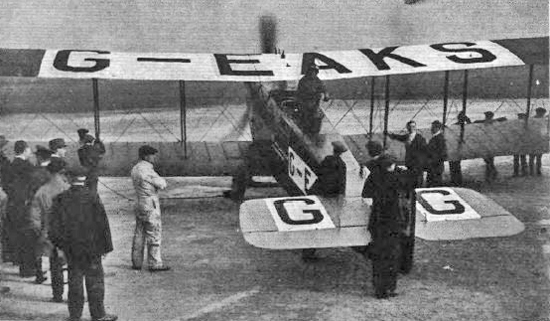
Harry Hawker accompanies them for some way from Hounslow in a Sopwith triplane, probably the ‘Snark’. Wearing their Australian military khaki they cross the Channel but are forced by fog to land at RAF Marquise only achieving about 100 miles the first day. It is 23rd October, before they can leave but soon meet very bad weather and unexpectedly strong winds. They descend through a gap in the clouds and search around for an hour before finding the landing ground at Cologne where the aircraft is damaged and Kay slightly injured. They receive a cable from the Australian Prime Minister wishing them, personally and on behalf of every one of their fellow citizens, every success in their great adventure without taking unnecessary risks, “plug on day after day doing your best”. That is not immediately possible as they are stuck in Cologne for repairs and better weather.
Taking off from Martlesham Heath, the starboard undercarriage frame of the twin Puma-engined Sopwith ‘Cobham Mk.II’ prototype H671 has become detached from the two wing fittings and is left swinging in the air suspended from the end of the axle. Very flares warn the pilot and he makes a careful engine-off landing which ends with him shocked and bruised trapped in the collapsed nose. Martlesham formally report “bad workmanship and a most serious omission in inspection” explaining that “there is no countersinking and the rivet heads have been practically filed off”. The ‘Cobham’ is to be brought back to Brooklands for repairs.
On 25th October, Flying Officer Culley attacks a Russian kite balloon over Krasnaya Gorka fort this time flying ‘Ship’s Camel’ N6767 from Koivisto, Finland. This aircraft has previously been photographed aboard HMS Furious, with its all too often overlooked fitter, rigger and armament airmen. (below) Its markings are painted out like the others on board Furious at the time of the Tondern airship shed raid although N6767 did not take part.
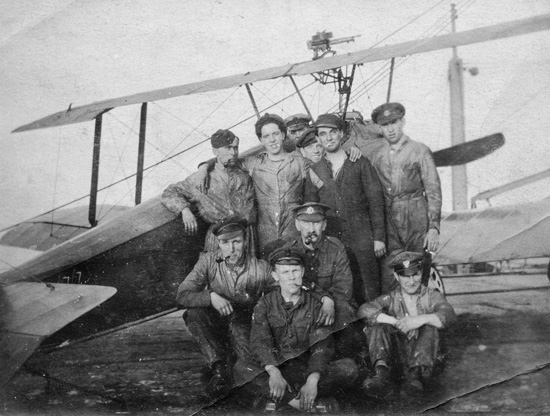
Meanwhile, in Australia, the Larkin-Sopwith Co’s two recently received Sopwith ‘Doves’ K157 & K168 have been assembled at Glen Huntly. (below) After Cpt J Larkin and Capt Vigers have “rolled, spun, stalled and looped one”, they declare the ‘Doves’ are “remarkably easy to land and could easily be flown by a woman”.

At 9pm on 25th October, Larkin makes the first night flight in Australia in ‘Dove’ K-168. It makes a dramatic spectacle for the crowds at the Melbourne Henley Regatta droning into sight illuminated across the wings and with the fuselage outlined with green light, it spirals down and flies along the river at a few hundred feet.
Apart from these two ‘Doves’ in Australia, Sopwith still have no customers for the rest of their nine ‘Doves’ and eight surviving ‘Gnu’ civil aircraft. Three of the ‘Doves’ are currently stored without Certificates of Airworthiness. ‘Gnu’ G-EAIM obtains its C. of A. on 27th October, leaving two without theirs but there is no hurry, any more than there is a hurry to complete four additional ‘Gnus’ recently registered G-EAME to AMH.
On 27th October, the third Sopwith Aviation & Engineering Company Board Meeting in two weeks clarifies their future plans. The Southport pleasure flight operation is closed down and the pilots and mechanics are to be given notice. Cpt Barnard who was injured in the Gnu crash at Southport has been offered one year’s salary. All work is to be concentrated at Sopwith’s Canbury Park Road factories in Kingston and the sheds at Brooklands. They will maintain an experimental aircraft design and manufacturing capability within a restrictive £10,000 annual budget. Priority goes to the sale and high volume manufacture of ABC motor cycles whilst also developing their own cheaper motor cycle. A unanimous decision to raise the price of the ABC machines from £83 to £110 covers the higher than predicted cost of manufacture and reflects recent price rises by competitors. This price includes “tools and tool accommodation, kick starter, pump, speedometer drive and dynamo driving pinion. A chain guard for some export markets will be extra”. Mr Fenn the Sales Manager is requesting five ABC motor cycles for Sopwith’s stand at the Olympia Motor Show in late November. They are talking to ABC about taking over all competitions “with ABC making a quid pro quo contribution to the expenditure” whilst still considering demanding compensation from ABC for losses due to their “late deliveries and scrap”.
On 29th October, the Sopwith ‘Wallaby’ is still snowbound in Cologne on its way to Australia but the French Caudron finally leaves Albania after eight days of bad weather and reaches Salonika in Greece.
Meanwhile, Flying Officer Culley in ‘Ship’s Camel’ N8184 drops four bombs on a Bolshevik destroyer in the Baltic before machine gunning it. Officially in a policing role, the ex-HMS Vindictive Short floatplanes, ‘Camels’ and ‘Strutters’ have continued to attack the Bolshevik naval fleet based at the island fortress of Kronstadt to prevent them interfering in the affairs of the new Baltic states of Estonia, Latvia and Lithuania. However Kronstadt’s AA guns have been very accurate forcing them to bomb from up to 14,000ft probably inflicting minimal damage but making their presence felt and reportedly having a significant impact on morale. They have only twice seen enemy aircraft and on one occasion three, assumed to be British, were shot down by their own AA guns.
Martlesham Heath’s report on Sopwith ‘Cuckoo’ N7990 with a 275hp Rolls-Royce Falcon engine in place of the 200hp engines shows a marginally better rate of climb but no overall significant improvement in performance.
On 30th October, ‘Camel’ F1955 of the RAF South Russia Instructional Mission escorting a raid on Tcherni-Yar claims a Bolshevik Nieuport crashed into the river.
In the race to be first to fly to Australia, the French Caudron, after nine days trapped in Albania, yesterday flew on to Salonica and today reaches Constantinople. The Sopwith ‘Wallaby is still trapped by snow in Cologne. Meanwhile, in London the day before its planned dawn departure for Australia, there is a naming ceremony for the Alliance Aeroplane Company’s ‘P.2 Seabird’ “Endeavour” with the Royal Aero Club officials affixing the competition seals. Cpt Douglas and Lt Ross are confident knowing that the initial ‘Seabird’ built for the trans-Atlantic challenge has made a record non-stop flight from London to Madrid in 7hrs 40mins. After the naming they take “Endeavour” on a final test flight but it is damaged in a “mishap” on landing. The crash is hushed up with the press told that the delayed departure is due to bleak misty weather and fog in the Channel.
Around 60 Sopwith aircraft have been delivered to the RAF during October. Sopwith have completed 40 ‘Dragons’ at the Ham factory not yet all delivered whilst Ruston Proctor, Boulton & Paul and Portholme have completed most if not all of their outstanding ‘Snipe’ orders and Wolseley Motors most of their remaining ‘Salamanders’. It seems likely that any remainders of those orders and a final 10 ‘Dragons’ from Sopwith’s Ham factory will be delivered during November completing all outstanding orders for Sopwith aircraft for the RAF.
By 31st October, the Ministry of Munitions Land Disposal Board has already received three provisional offers for the purchase of the National Aircraft Factory No.2 at Ham. The bidders, Leyland Motors, a Mr Clark and Messrs Douglas Kershaw (on behalf of clients), have been made aware of Lord Dysart’s restrictions on further development of the site and appear to be offering £200,000 plus the cost of the land. Two are seeking occupation within a month which is thought possible providing Sopwith can retain some space to store aircraft and parts.
At the Canbury Park Road factory, volume motor cycle production is yet to get going and Sopwith are employing the skills of otherwise idle key workers to produce various “sidelines” including two designs of pull-along mechanical wooden toys for the Bentalls department store in Kingston to sell this Christmas.
The minimal need for aircraft test flying has left Harry Hawker with time to indulge his interest in cars and prepare for next season’s motor racing. He is currently being quoted by Cosmos Engineering as praising their 450hp Jupiter radial engine in the 1919 Sopwith Schneider Cup floatplane. (below) “The smoothest running radial I have ever seen. There was no vibration on any wire of the machine”
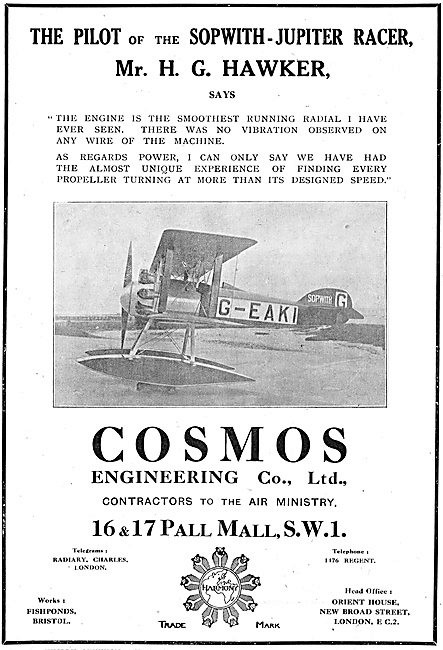
British military support in Northern Russia is being withdrawn and the early converted ferry boat aircraft carriers HMS Nairana and HMS Pegasus with their hangars, floatplane cranes and foredeck take-off ramps have now returned home. Now that many capital ships have their own reconnaissance ‘Strutters’ and interception ‘Camels’ on turret ramps, Nairana is to be paid off and Pegasus is to have her flight deck removed to revert to a floatplane mother ship.
On 31st October, ex-78 Home Defence Sqdn ‘Snipe’ E7434 & E8091 are wrecked en-route to their new base, or possibly storage depot, at Scampton, E7426, E7575 & E8090 each forced land near Cambridge on the same journey whilst E7574 reaches Scampton after a damaged fulcrum post at Harlaxton. 39 Home Defence Sqdn at Biggin Hill has also now been reduced to cadre and 143 Home Defence Training Sqdn disbanded ending the Snipe’s potentially important but ultimately not needed home defence role during the Peace Negotiations.
On 2nd November, Matthews and Kay in the Sopwith ‘Wallaby’ finally leave Cologne after nine days of repairs and then snowbound but they only reach Mayence on the Rhine just 85 miles south-west of Cologne. The French Caudron crew are working their way across Turkey and have now reached Konya.
On 3rd November, after studying a letter from Larkin-Sopwith claiming they are “losing a good opportunity of selling some aircraft in Australia by reason of having no stock” the Sopwith Board agree to offer to supply certain machines on special payment terms, a percentage on order and the balance when the aircraft are sold. They also decide that all but six of their many patents should now be allowed to lapse. The remaining six include their centre pivoted split axle construction.
After early reluctance to supply Poland with military aircraft due to uncertainty over the situation in Eastern Europe, the Foreign Office has now agreed. Poland has requested 4 to 17 Scouting Machines, 4 to 15 Bombing Machines and 7 to 15 Racing Machines preferably SE5s, Martinsyde Buzzards or Sopwith Dolphins. The Foreign Office decision may have been influenced by the fact that the Ministry of Munitions is openly advertising surplus stock of many such aircraft at 15% to 60% of actual cost. (below) Other similar current advertisements are for 30,000 gallons of dope and Bessonneau portable canvas hangars.
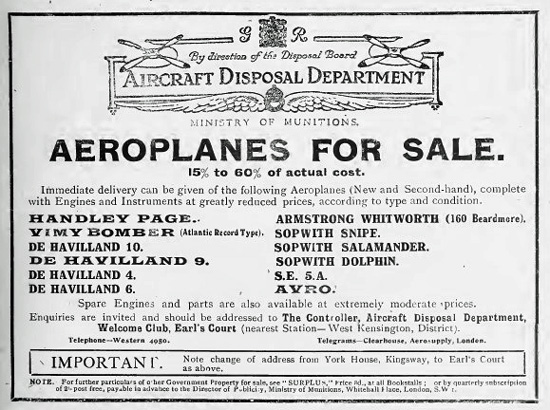
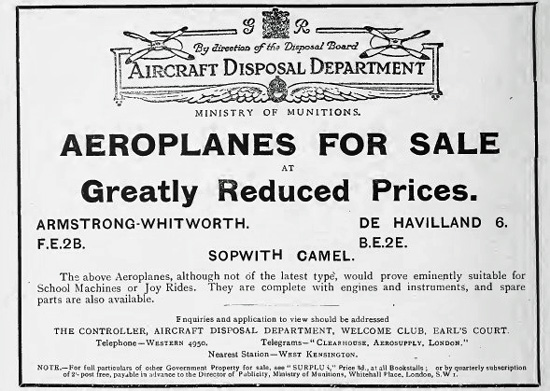
On 5th November, Leyland Motors write to the Ministry of Munitions to confirm their offer of £225,000 for the National Aircraft Factory No.2 at Ham including all the land and all the plant and machinery belonging to the Ministry including the sub-station and the sawdust extraction plant. The purchase to be completed within three months on the understanding that the Ministry will purchase the land by compulsory requisition if necessary and hand the title to Leyland Motors. Negotiations continue between the Ministry and Lord Dysart’s agent who is now asking £16,000 for the land and with Ham Urban District Council for them to take over the Sewage Plant built on the site.
At the Sopwith Board Meeting on 10th November, it is resolved to limit further meetings to one a month and hold a Heads of Departments meeting each Monday morning. The discussion on the production of “sidelines” “including lamp shells, collapsible tubes and the like” will go to that meeting and no new ones will be taken on unless agreed there. The Board agrees to send a letter to ABC Motors asking what action and recompense is to be provided for the financial loss owing to faulty, incomplete and delayed drawings and estimated £10,000 of scrap. The letter will also draw attention to the infringement of their agreement by the construction of the ABC Skootamota by another company.
Meanwhile the Bentalls Department Store advertisement in the Surrey Comet for the opening of their Christmas childrens’ attraction includes the Sopwith-made wooden toys declaring simply that they are “Made in a British aeroplane factory”. (below) “The Newest Toys Out. The Kingston Crocodile which opens and closes its mouth and wags its tail as it is drawn along. 8s/11d The Toyland Pug with similar mechanical movements. 4s/11d”
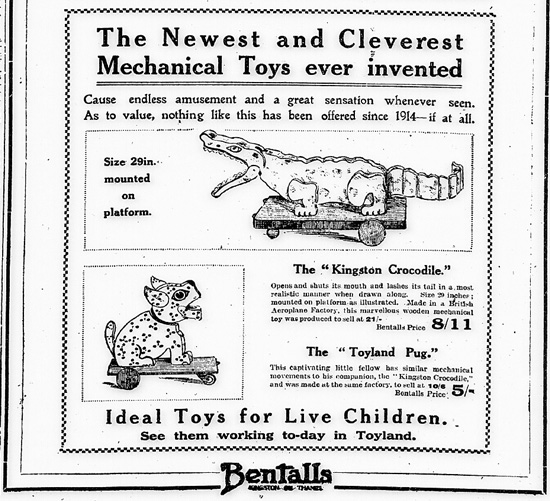
Larkin-Sopwith do not have a monopoly of British-built civil aircraft in Australia. Australian Air Force “Buy Bond” marked ‘Pup’ C523 has made two final flights in Tasmania in the company of a civil Boulton and Paul P.9 brought over by Lt Long. The P9 is to continue the Peace Loan flights and the military ‘Pup’ returns to the Central Flying School at Point Cook on 11th November.
After a test flight at Brooklands on 7th November the Vickers Vimy England to Australia race contender entered by Vickers Ltd leaves a snow-covered Hounslow Heath at 9.05am on 12th November. It is a standard Vickers Vimy bomber with two 360hp Rolls-Royce Eagle engines and a cruising speed of 90mph. The empty weight of 3 tons rises to 5.8 tons with four crew, 516 gallons of petrol, 40 gallons of oil, 10 gallons of water, essential spares, kit, tools and other sundries even after they have dispensed with the radio and despatched personal effects by sea. The pilot is Capt Ross Smith with his brother Lieut Keith Smith as assistant pilot and navigator accompanied by mechanics Sgt A W Bennett and Sgt W H Shiers all distinguished members of the Australian Force through the war. On this first day despite meeting dense clouds and getting iced up they cover the planned 510 miles to Lyons.
At Martlesham Heath on 12th November, production Sopwith ‘Dragon’ F7017 joins the various prototype scouts testing the troublesome ABC Dragonfly engines including Sopwith ‘Snark’ triplane F4068. Their latest report on the ‘Snark’ is not encouraging. Aileron control is heavy and its manoeuvrability and turning radius are inferior to the Nieuport ‘Nighthawk’ and Armstrong Whitworth ‘Siskin’. Performance in the climb is good reaching 2,000ft in 1min 24secs, 10,000ft in 7mins 36secs and 15,000ft in 13mins 48secs but “speeds are low for a modern scout”, 128.5mph at 10,000ft and 5mph less at 15,000ft. Martlesham do not like the restricted view forward and above compared with the biplanes but do like the guns mounted low down inside the fuselage “readily accessible to the pilot for clearing and adjustments”. They have had to replace the propeller spinner which cracked after 5 hours and the cowling supports which were too weak.
On 13th November, with the Sopwith ‘Wallaby’ still trapped by the snow near Mayence in the Rhine Valley, the Vickers Vimy flies on from Lyons to Pisa in Italy whilst the two Frenchmen in the Caudron are now about half way to Australia having reached Karachi.
At Hounslow since dawn, a fourth team has been ready to set out for Australia. The Alliance Aeroplane Company’s P.2 ‘Seabird’ “Endeavour” is nearly a fortnight later than planned but is now repaired after the hushed-up crash on 30th October. Australian pilots Lt Roger M Douglas and Lt J S Leslie Ross are in this unusual single 450hp Napier Lion powered biplane, a sister aircraft has flown from London to Madrid. The instruments and radio equipment are in front of the navigator in the front of the enclosed cockpit. Lt Douglas behind him has a large steering wheel. He has to put his head out of the triangular side windows to get any view forward.(below)
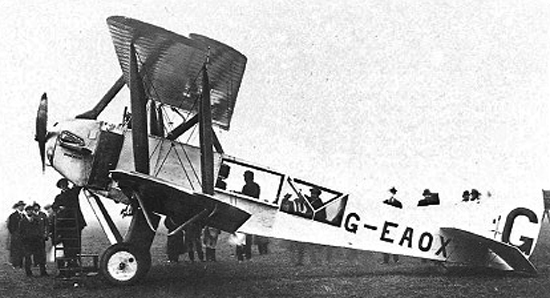
At 11.33am they wave farewell and depart on their carefully planned 3,000 mile non-stop attempt at a record-breaking first leg to Brindisi on the heal of Italy. A few minutes later the machine is heard passing low over Teddington but over Surbiton it suddenly appears out of the clouds in a spin, straightening out somewhat before spinning again and nose-diving into an apple tree in an orchard in Lower Marsh Lane. Lt Douglas is killed instantaneously and Lt Ross dies within a few minutes. The inquest at Surbiton into the crash hears that the engine and flying controls have been found to be in perfect mechanical order and the most likely explanation is the pilot losing his orientation in cloud, getting into a spin and coming out too low to recover. A verdict of accidental death is recorded despite frequent interjections from Lt Douglas’ fiancée and a friend of his claiming that the previous accident damage was very significant with repairs only completed the night before the flight and L Douglas had hardly had any time to practice flying the machine. Both points are contested by the aircraft’s designer.
Meanwhile, on 15th November, the Smith brothers and their mechanics in the Vickers Vimy fly on to Rome and since then day by day to Taranto, Suda Bay on Crete and Cairo reaching Cairo on the 18th November as the Frenchmen in the Caudron are leaving Karachi for Delhi
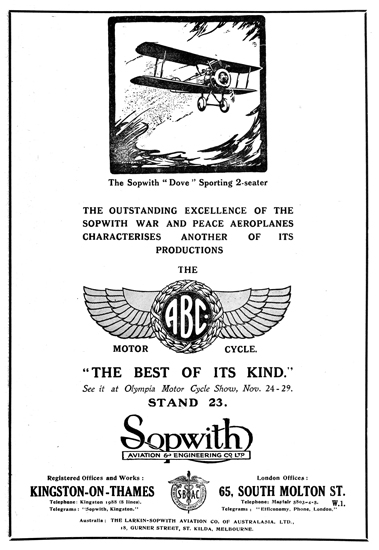
By 19th November, preparations for the Sopwith ABC stand at the Olympia Motor Cycle Show next week are complete. Advertisements appear in the journals and Sopwith’s fleet of vans carry large images of their motor cycle and advertising for the show. (below, parked in Elm Road on the east side of the Canbury Park Road factory)
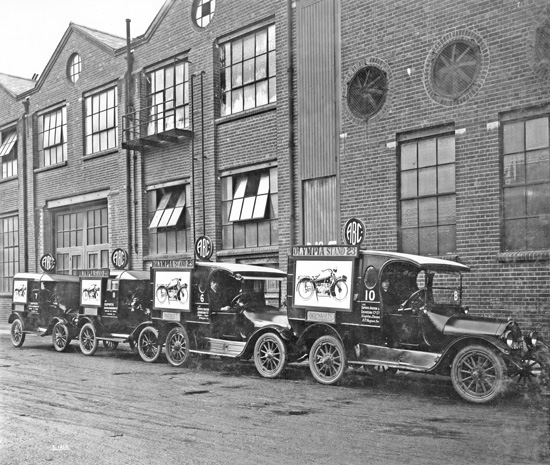
On 21st November, the Vickers ‘Vimy’ reaches Basra in Iraq, as the latest contender in the race to Australia is ready to leave Hounslow. Originally one of twenty naval reconnaissance bombers, this Blackburn ‘Kangaroo’ biplane is similar to the 8-passenger conversions recently giving pleasure flights but with a large extra fuel tank in part of the open passenger seating area and duplicated flying and engine controls in the front cockpits. The two Rolls-Royce Falcon engines have been uprated to 275 hp. Its long fuselage is mounted on “well sprung landing wheels with telescopic struts and rubber buffers and should be able to alight safely on grounds none too suitable for the purpose”. “A number of spare parts are on board and the machine is not altogether unarmed should natives show signs of hostility”. Blackburn have supplied the aircraft but the cost of the flight is being financed by the Australian crew who are also making all their own arrangements along the way. The ‘Kangaroo’ leaves Hounslow at 10.37am on 21st November in bright sunshine and circles the airfield three times. They are soon confronted by a blinding rain-storm over the Channel and fog over France and have to land at Romilly 62 miles east of Paris. After heavy snow falls overnight they are trapped as still is the Sopwith ‘Wallaby’ possibly for several days.
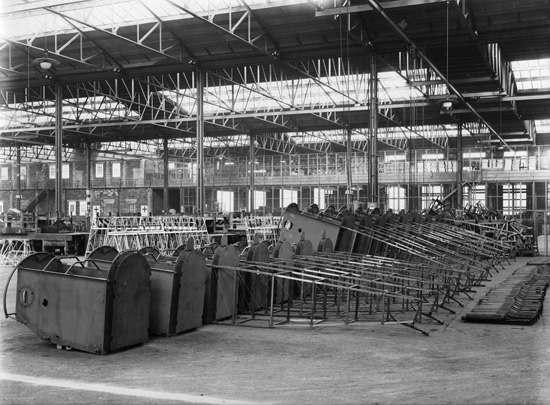
Sopwith Aviation has been given notice of the imminent sale of the National Aircraft Factory at Ham by the Ministry of Munitions and on 21st November make a photographic record of the remaining stock on site. (above & below) This includes ‘Salamander’ fuselages and wings on the main assembly floor surrounded by piled up benches and equipment. On the surrounding balconies are more spare ‘Salamander’ wings, engine cowls, fuselage panels, fuel tanks and oil tanks. With all aircraft orders complete, these must be for outstanding spares orders and/or over-manufactured items and/or sub-standard or trial parts.
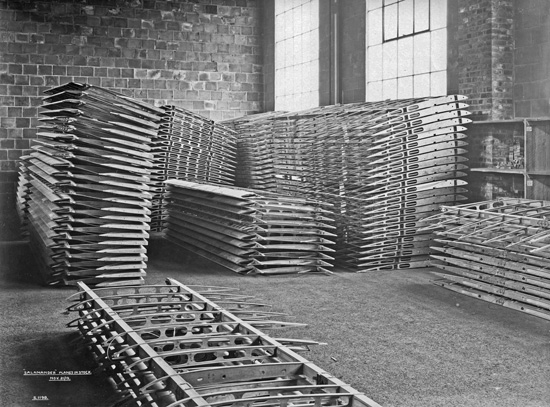
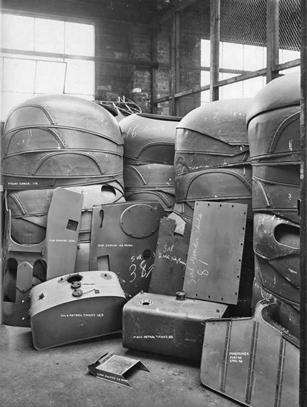
On 24th November, the Vickers ‘Vimy’ reaches Karachi via Persia. The French Caudron left Karachi six days ago and has now reached Delhi whilst the Sopwith ‘Wallaby’ and Blackburn ‘Kangaroo’ are still trapped in snow in northern Europe. On 25th November, the ‘Vimy’ reaches Delhi (right) after the Caudron has left for Allahabad and the following day the Frenchmen reach Calcutta.
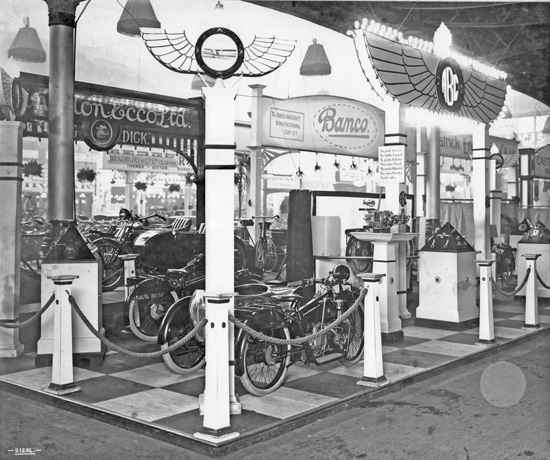
Sopwith have made a significant investment exhibiting at the Olympia Cycle and Motor Cycle Show. The large “island” stand has motor cycles and “sporting style” sidecar combinations on either side of the triumphal central arch with its winged motif surrounded by bright lights. Inside the arch is an ABC machine mounted like a work of art. Raising it up turns out to be useful as the hall is often packed with visitors.
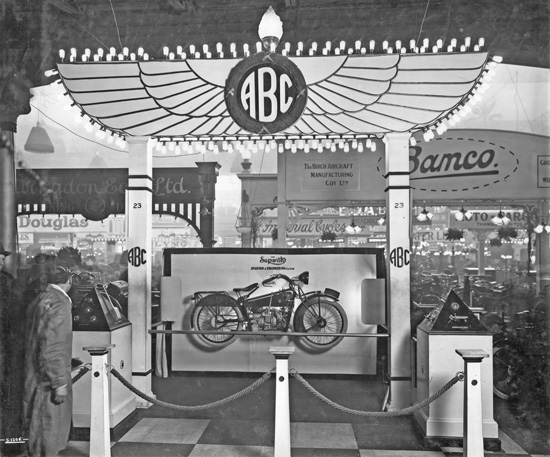
Sopwith is promoting the ABC motor cycles with sales captions which include:- “The machine that suits every kind of rider”, “A car on two wheels” and “Distinctive, neat, compact, complete – in 4 words DESIGN”.
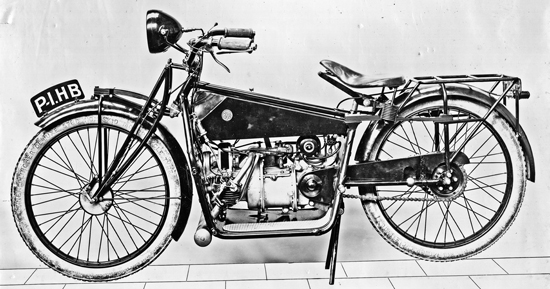
The touring or TT handlebars in horizontal clamps are easily raised and lowered. The hand controls from right to left are brake, throttle, ignition, exhaust valve lifter and clutch. There are broad mudguards and an undershield protecting the engine and rider from mud and debris “but with adequate cooling”.
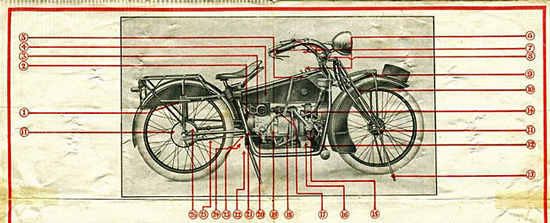
Other features numbered in the sales brochure (above) are (1 & 9) front and rear leaf spring suspension with a sprung saddle all providing “car riding comfort”, (11 & 31) self-adjusting mud-proof enclosed cone brakes on both wheels, (22 & 33) front and rear stands and (2 & 3) optional dynamo, battery and lighting switchgear.
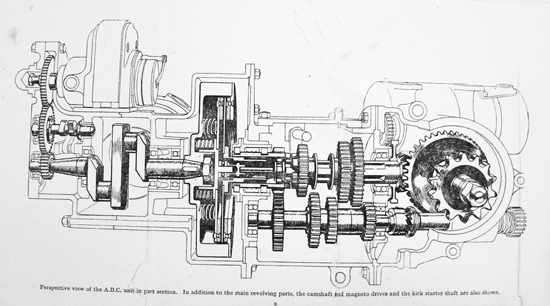
The two-cylinder horizontally-opposed 400cc engine has an integral clutch, four speed gearbox and bevel gear driven cross-shaft for the chain sprocket. Overhead valves are push rod activated by the camshaft in the gear train at the front of the engine. The magneto and carburettor are mounted on top of the engine with the carburettor air intake heated by exhaust gases. The long H-gate gear change lever is on the righthand side as are the rear brake pedal and the speedometer which is mounted on the side of the fuel tank. Only the “sporting sidecar combination” (below) is at the show but they have been testing a prototype “touring sidecar combination” around Richmond park. (below again)
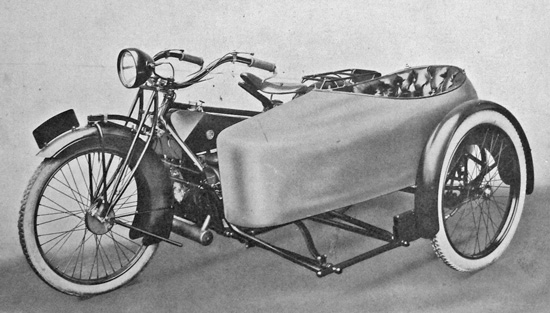
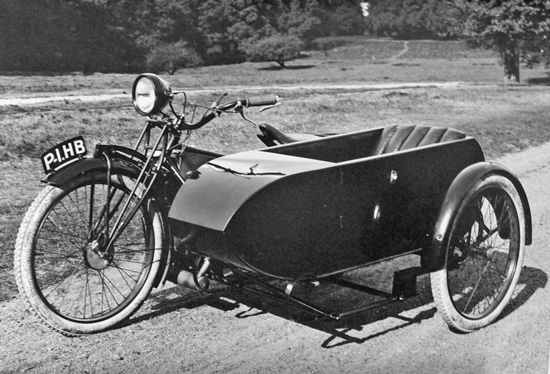
Martinsyde, Sopwith Aviation’s long-time friends and rivals, have also chosen motor cycle manufacture as the way to keep their business running alongside the minimal demand for civil aircraft and have been exhibiting a prototype 680cc V-twin Martinsyde motor cycle at the Olympia Cycle and Motor Cycle Show. Martinsyde have also entered the air race to Australia, sponsoring Capt C E Howell and his mechanic Corpl G H Fraser on the promise of £8,000 of the £10.000 prize money should they win. Capt Howell is a Sopwith ‘Camel’ ace having claimed 19 victories with 45 Sqdn in Italy in 1918. The aircraft is a Martinsyde Type A civil two-seater, a development of the Buzzard fighter and Raymor trans-Atlantic challenger and like the Sopwith ‘Wallaby’ has a 275hp Rolls-Royce Falcon engine. A unique feature of the Type A is that its undercarriage can easily be exchanged to a pair of floats and G-EAMR has been tested on these before they were shipped off to Calcutta ready to be fitted for the last leg of their journey to Darwin.
On 28th November the Vimy arrives at Calcutta via Allahabad to find that the Frenchmen in the Caudron had left Calcutta that morning and flown to Akyab becoming the first aircraft to land in Burma.
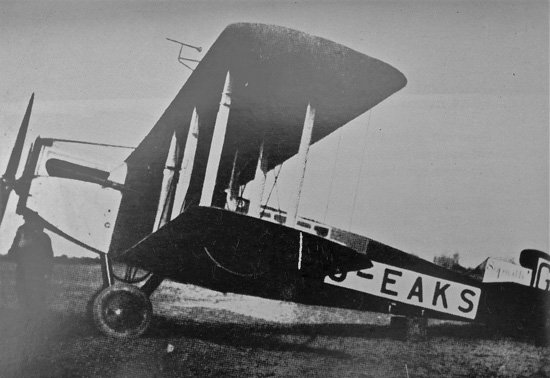
Finally on 29th November Matthews and Kay who left England 39 days ago in the Sopwith ‘Wallaby’ manage to escape from the deep snow at Mayence in Germany. (above) Flying towards Belgrade they run into thicker and thicker mist and are eventually forced to land near Vienna where they are again held up, initially finding it impossible to buy fuel. Meanwhile the Blackburn Kangaroo has flown on through France to Pisa in Italy whilst the Frenchmen in the Caudron are joined at Akyab in Burma by the Smith brothers in the Vickers Vimy who have been catching up with them day by day on the same route.
On 30th November as the Blackburn Kangaroo reaches Rome from Pisa, the Caudron and Vimy teams fly 320 miles from Akyab to Rangoon, the Frenchmen leaving an hour earlier and arriving an hour later. They are greeted with great celebrations by a Sunday crowd of 40,000 gathered to see two planes racing half way across the globe.
During November ‘Gnu’ G-EAIM has been despatched to Larkin-Sopwith in Australia to join their two ‘Doves’. There have still been no UK sales of Sopwith’s stock of civil ‘Doves and ‘Gnus’ and with all production orders for military aircraft completed, Sopwith’s only aircraft work is now in the experimental department in the Roller Skating Rink in Canbury Park Road and the flight sheds at Brooklands. Flight journal reports “on good authority” that the Sopwith Schneider Cup floatplane now fitted with a land undercarriage has flown at Brooklands at over 170 mph. Sopwith’s other aircraft work in November has focussed on ABC Dragonfly engined prototypes. Both ‘Cobhams’ and all six ‘Snark’ and ‘Snapper’ were largely completed back in October 1918 before the chronic problems with the engine caused work to be halted. ‘Cobham’ H672 with its two substitute Puma engines has been back for repair but H671 still awaits its Dragonfly engines. With the first ‘Snark’ F4068 at Martlesham Heath, the second F4069 has finally been allocated a Dragonfly engine and is photographed outside Sopwith’s sheds at Brooklands.(below) Meanwhile the first ‘Snapper’ F7031 has been back from Martlesham Heath for wing modifications whilst F7032 & F7033 are at last being fitted with their Dragonfly engines.
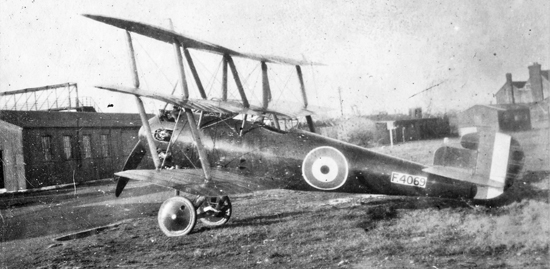
On 1st December, whilst the Blackburn ‘Kangaroo’ flies on from Rome to a forced landing at Capua with magneto problems, the ‘Vimy’ team press ahead from Rangoon to Bangkok. The Caudron was to leave with them but they have trouble starting their engines and after circling overhead for 20 minutes the ‘Vimy’ makes the flight alone. The Caudron eventually gets away but wisely returns to Rangoon after fearing they might lose their way in the mist.
Also on 1st December, the Sopwith Board decides that Harry Hawker should from 17th November get 25% of any cash prize won in flying competitions in addition to his salary but any trophies will be the property of the Company. They confirm that they will vacate the Ham factory this week for the new owner providing they can retain certain facilities for storage. They also agree in principle with a proposal from Aircraft Transport & Travel Ltd for an Indian aerial service and will continue negotiations with General Brancker. Since making successful trial flights with ‘Camels’, ‘Strutters’ and Nieuport 28s from turret ramps on capital ships the US Navy has fitted at least one and possibly three of its six ex-USAC ‘Camels’ with floatation gear. Photographs (below) show one such ‘Camel’ suspended from a crane with the starboard floatation bag still packed and the port one inflated.
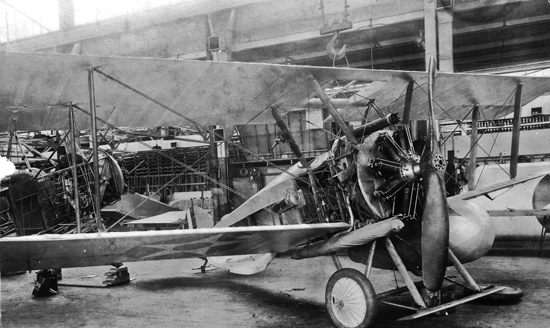
There is a large hydrovane in front of the droppable wheels and a tiny one on the tail skid plus a square floatation bag inside the rear fuselage. This machine carries a single machine gun and has US under-wing roundels. The second photograph shows both bags inflated. (below)
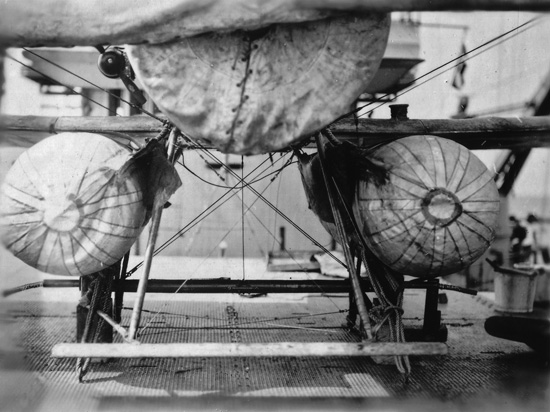
On 3rd December, one of these machines is used for a ditching trial in the river near the US Naval Factory at Philadelphia. The floatation gear fails to open properly but the pilot is rescued and the aircraft salvaged. The further photograph (below) shows a US Navy flotation gear ’Camel’ alongside Nieuports.

The same day, the Blackburn ‘Kangaroo’ reaches Taranto on the heal of Italy whilst the Vickers ‘Vimy’ team have pressed ahead from Bangkok to Singora in Thailand. The Caudron team is still at Rangoon having had both tyres puncture on their second attempt to leave. The Martinsyde team is still at Hounslow after several days impatiently waiting for a break in the weather.
On 4th December, with no news of the Sopwith ‘Wallaby’ trying to make its way from Vienna to Turkey and the Blackburn ‘Kangaroo’ still at Taranto in Italy, the Vickers ‘Vimy’ team have pressed ahead from Singora in Thailand to reach Singapore. They are now well in the lead as the Frenchmen in the Caudron suffer engine problems an hour out on today’s flight from Rangoon and have to return for repairs. Meanwhile at Hounslow, Howell and Fraser in the Martinsyde Type A which arrived from Brooklands two days ago finally get weather clearance and set out. They reach Dijon only about 100 miles short of their planned stop at Lyons despite having been hampered by bad weather over the Channel, a delay with fuel pump problems in Paris and then meeting more bad weather which forced them down. On 5th December, the Martinsyde machine reaches Pisa on its second day after stopping at Toulon for two hours to allow winds to abate whilst the Blackburn ‘Kangaroo’ makes a 7hour 627mile flight down the Greek coast from Taranto to a rain-soaked airfield at Suda Bay on Crete. On 6th December, the ‘Kangaroo’ is found bogged down in thick mud and Bulgarian prisoners are tasked with digging it out and dragging it to drier ground. Meanwhile after the Martinsyde crew have hand carved a new tail skid overnight they reach Naples and the ‘Vimy’ pushes ahead from Singapore to Kalidjati in Indonesia.
On 7th December, Matthews and Kay in the Sopwith ‘Wallaby’ finally get away from Vienna and in bad weather have been forced down in Yugoslavia 100 miles short of Belgrade where armed men, believing them to be a Bolsheviks, have confiscated their papers and passports and imprisoned them in a 10ft square room. Meanwhile, the ‘Vimy’ flies on across Indonesia to Sourabaya whilst the Martinsyde team gets air-sick flying almost to Taranto before deciding the weather is too rough to land and returning to Naples.
On 8th December, the Martinsyde finally reaches Taranto and the Frenchmen in the Caudron finally leave Rangoon after 8 days to reach Moulmein in Burma as the ‘Vimy’ continues across Indonesia reaching Bima. The Blackburn ‘Kangaroo’ flies from Suda Bay towards Egypt but suffers a broken oil pipe 40 miles out to sea and loosing height on one engine only just makes it back to Suda Bay but hits a ditch and careers into an earth wall ending on its nose.
On 9th December, the Caudron hits heavy fog flying to Bangkok before being forced back to Moulmein with a broken propeller and a cracked piston. Meanwhile, the ‘Vimy’ reaches Atamboea on Timor in Indonesia just 470 miles short of Darwin. At noon, Howell and Fraser leave Taranto in the Martinsyde on a 400 mile flight to Athens but nothing is heard of it until 8pm when it ditches into the sea in St Georges Bay on Corfu in semi-darkness just 150 miles from its starting point. Peasants report hearing cries of help but the sea is too rough for immediate assistance. Captain Howell’s body is washed ashore the next morning but Lt Fraser is not found. It seems that, running out of daylight and probably low on fuel, they spotted the lights in the township and attempted a safe landing. The aircraft, lying in 12ft of water, breaks up before it can be salvaged.
At 3.40pm on 10th December, the Smith brothers and their two mechanics land at Fanny Bay Airfield, Darwin, in the Vickers ‘Vimy’ to claim the £10,000 prize for the first flight from England to Australia. The journey has taken 27 days and 20 hours. They are greeted by a huge crowd who carry them shoulder high to the residence of the Governor of the nearby goal before a celebration dinner and beds in Government House. The Frenchmen decide that the fog-bound mountains of Thailand at this time of the year are insurmountable obstacles for their lightweight Caudron machine and reluctantly abandon their attempt to reach Australia. The Blackburn ‘Kangaroo’ team, discovering it will take two months to get a replacement engine from England to Crete, also has to abandon the attempt, at least for the moment. The last few days of tragedy, triumph and disappointment for the other teams leaves only Matthews and Kay still attempting the challenge in their Sopwith ‘Wallaby’ and they are imprisoned by armed soldiers in Yugoslavia.
Meanwhile, back in England on 3rd December, Lord Dysart’s agent agrees to accept £15,000 for the land requisitioned by the Ministry of Munitions to build National Aircraft Factory No.2 at Ham and, on 6th December, the few remaining Sopwith workers left for Canbury Park Road leaving only some stored aircraft and parts. On 9th December, Leyland Motors signs an agreement to purchase the whole factory, site and equipment for £227,000, paying £22,500 on signing and promising the balance on 25th March 1920 after which they will be charged 6% interest on any outstanding amount. The £227,00 largely recovers the Ministry’s costs of building the factory and they have acquired the key plant and equipment installed by Sopwith Aviation without extra call on the Treasury by taking it in lieu of the entire £14,250 rent due from Sopwith for their occupation of the factory since the spring of 1918. Leyland Motors have decided to buy-back and progressively refurbish thousands of lorries built for the RFC/RAF through the war to avoid their reputation and new vehicle sales being seriously affected by trading in large numbers of these, often poor condition, second-hand vehicles. (below, a long-bodied RAF Leyland “Subsidy” carrying a ‘2F1 Ship’s Camel’ with the rear fuselage unclipped)
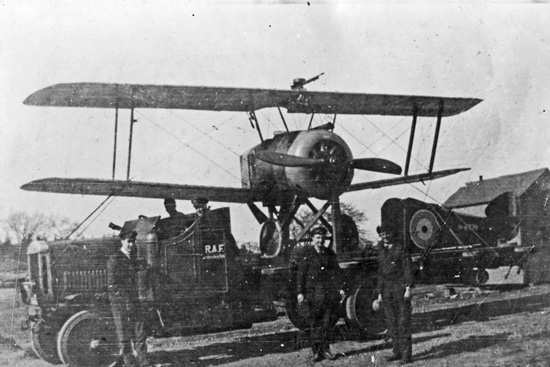
Leyland are expecting to win the bid for the 1,000 surplus Leyland ‘Subsidy’ lorries in the dump at RAF St Omer near Calais plus at least 500 similar surplus machines in southern England, all a very long distance from Leyland in Lancashire. The 38 acre site at Ham is seen as an ideal southern location for storing so many vehicles with the large factory suitable for manufacturing replacement parts and steadily refurbishing the lorries for resale complete with new bodies or as running chassis ready for the buyer’s own body-builders. Leyland ‘Subsidy’ lorries have been used throughout the war by the RFC/RAF, many as tenders for a driver and armed guard with side doors behind the cab for the air mechanics. Other uses include mobile workshops complete with electrical generators, fuel tankers, aircraft transporters and kite balloon carriers with winches.
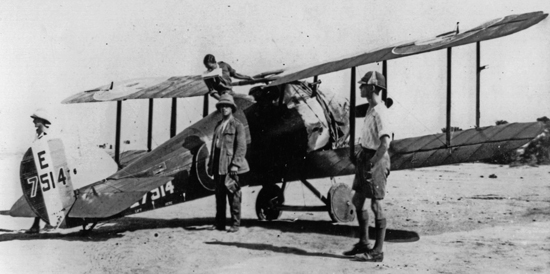
With the home defence squadrons disbanded the most active ‘Snipe’ squadron is now 80 Squadron in Egypt. With a generous supply of replacement machines in the Aeroplane Supply Depot Middle East (ASDME) at Aboukir, E7514 (above) is one of their older machines which is about to be deleted for some reason as presumably will be this other damaged one arriving by train crammed onto an Egyptian State Railway wagon. (below)
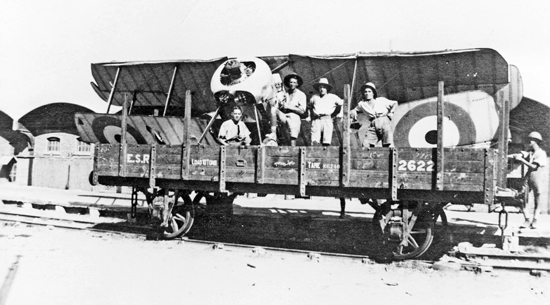
F7017, one of the few Sopwith ‘Dragons’ yet to get a Dragonfly engine, is now at Martlesham Heath in the hope of restarting E7990’s type performance trials. (below)
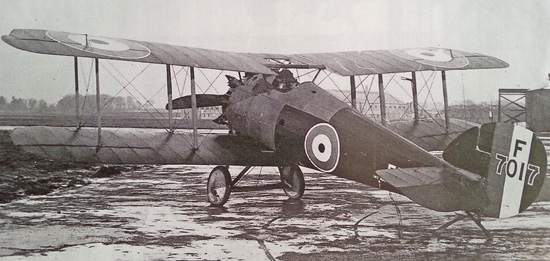
“Flight” magazine’s correspondent reports that on, 10th December, the sentry at the gate at Brooklands still needed telephone permission from the R.A.F. Adjutant to let him enter. Just inside he found “several beautifully camouflaged fuselages of Sopwith ‘Salamanders’ ready to leave on RAF lorries”. (There are no photographs but the one below is J5913 being towed behind its wings at Minchinhampton)
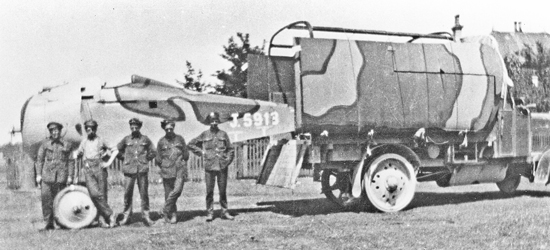
“The Sopwith sheds contain many interesting machines with the most excellent lines of the ‘Pup’ to be seen in the ‘Snapper’ and the ‘Dove’. There are several training machines, a useful-looking Sopwith ‘Swallow’ monoplane and the now somewhat dismantled Schneider Cup machine. Near the centre of the aerodrome is the first Martinsyde F.6. hastily rigged for photographing with a bucket of sand hooked to its tail to prevent it from flying away. It is a sporting two-seater biplane somewhat like the F.4 fighter and fitted with a 300-h.p. Hispano-Suiza engine. The interior of the Martinsyde shed is quite a museum, besides an F.5 and another machine are a number of fuselages and on the rear wall numbers of airscrews, some of great antiquity. In the early afternoon four Vickers ‘Vimy’ machines, the first piloted by Sir John Alcock set off for an aerodrome in Norfolk.”
On 11th December, Matthews and Kay, who had carefully watched where their papers and belongings were stored during their four days’ imprisonment in Yugoslavia eating only bread and pig’s fat, get up very early, break out of their 10ft square room, recover their belongings whilst the guards are sleeping off a heavy drinking night and make for the ‘Wallaby’. The engine starts immediately, despite having been standing in intense cold. It is as foggy but they rush a take-off just getting away through a fusillade of shots fired by the awakened guards. Low on fuel they head towards Belgrade reaching Novisad where French officers are in occupation and they are again safe but there is no petrol. Matthews decides to go by train into Belgrade to try to get some petrol but, even if he can, it looks as though there is heavy snow on the way.
Needing to rapidly build up sales, Sopwith are now advertising their ABC motor cycles in specialist magazines like The Motor Cycle as “an incontestable advance in motor cycle design”. They are convinced that they are “What the public has been waiting for”, claiming that “in the point of simplicity, maintenance efficiency, comfort and ease of control it has in the opinion of the motor cycling public established a commanding lead over contemporary designs”. (below)
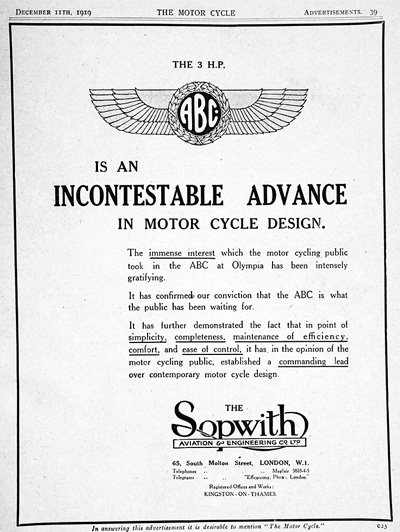
Aware of the impending freezing over, of the Baltic the crew of HMS Vindictive have been clearing out their Finnish aerodrome and the seaplane base. By 18th December, the ‘Camels’, ‘Strutters’ and seaplanes are back aboard except three or more ‘Ships’ Camels’ which have been handed over to the Latvian Air Force.
On 21st December, with the Bolshevik fleet about to be safely frozen in port, Vindictive sails via Copenhagen to be in Portsmouth in time for Christmas. With HMS Vindictive back home and HMS Furious recently placed in reserve, the Grand Fleet Flying Squadron is effectively disbanded. Only the flat-top aircraft carrier HMS Argus is retained for continuing trials and development work pending the arrival of island superstructure through-deck aircraft carriers HMS Eagle and HMS Hermes. They are both afloat but still some way off completion.
British aerial support for the White Russian forces in Northern Russia against the ever more dominant Bolsheviks was withdrawn back in October. The support in Southern Russia is only now Major Collishaw’s RAF Training Mission with their ex-47Sqdn ‘Camels’ like F1956 carrying Ist Kuban Otryad White Russian roundels with a white centre, blue and then red outer rings. (below)
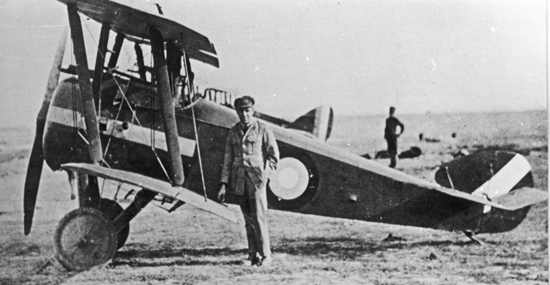
However, the majority of aircraft with both White Russian and Bolsevik forces are still Sopwith aircraft mostly ‘Strutters’. At least 125 ‘Strutters’ came from Britain, some have actually been built in Russia by Ducs of Moscow but most, possibly hundreds, are French supplied French built ones. They have been photographed in various locations with all sorts of markings and even on skis in the snow. (below) The first two with red star markings are ‘Strutter’ which have fallen into the hands of the Bolshevik revolutionaries.
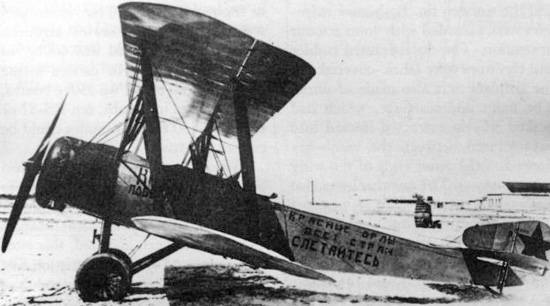
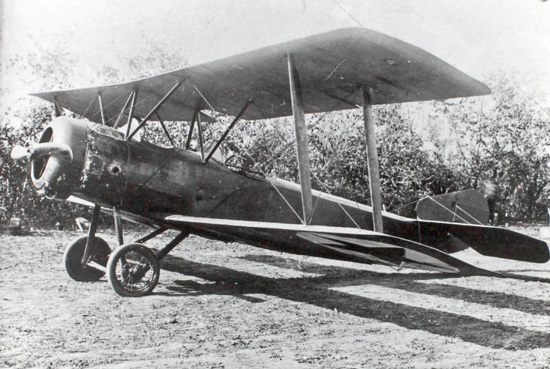
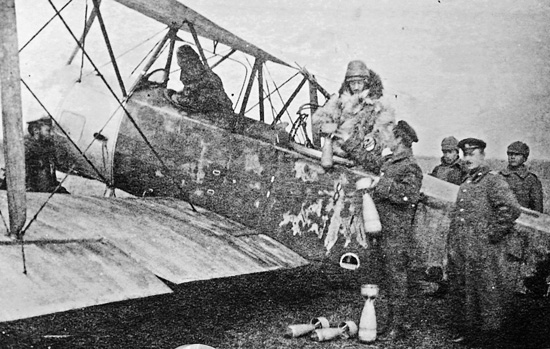
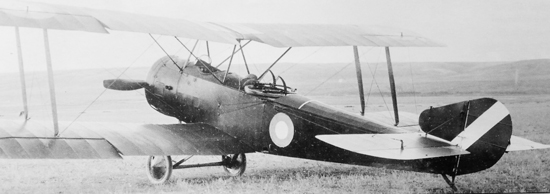
The French built machine marked ? (below) has been with the Slavo-British Aviation Corps in Northern Russia in 1918 as has the ski fitted machine. (below again)
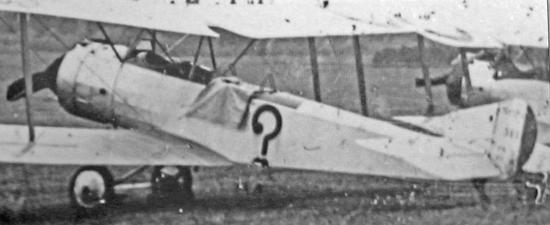
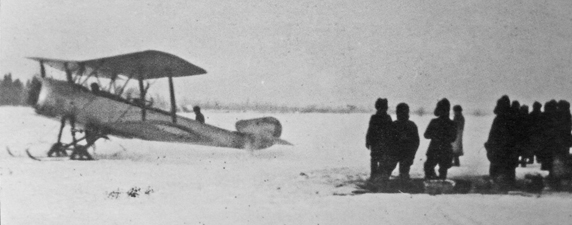
Sopwith ‘Snipe’ are to operate even further east than Egypt. A batch including H4868, 71, 72, 75,76 have recently set sail for India aboard SS Gurna. They are destined for Nos.1 & 3 squadrons which are to be re-born in the New Year at Risalpur and Ambala to bring the total number of RAF squadrons on the north west frontier of India to eight. The ‘Snipe’ will not be the first Sopwith aircraft in India, No.31 Squadron has been operating at least two ‘Camels’ from Risalpur alongside their Bristol F2B fighters including F1915. (below)
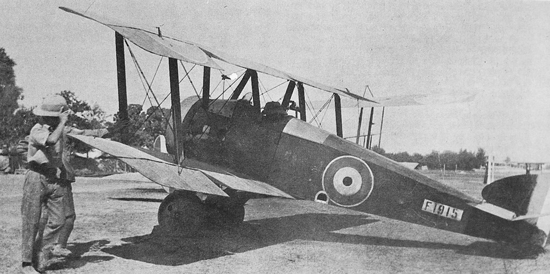
After getting to Belgrade by train Matthews finds the British Officer Commanding has no petrol but he eventually obtains sufficient from a French aviator and takes it back to Novisad. Since then he and Kay have set out for Constantinople in the Sopwith ‘Wallaby’ but made a forced landing at Adrianople just inside the border of Turkey with a leak in the water jacket. They repair this with chewing gum mixed with asbestos powder all bound around with copper wire. The field however is a quagmire and “take-off is only possible by Kay hanging onto the tail and making a flying jump for the fuselage as soon as they leave the ground”. On 23rd December two months after leaving England they finally arrive at Constantinople with the engine in bad shape and in need of an overhaul, to hear that the Vimy has already reached Darwin. They cable their congratulations to Ross Smith in Australia.
During an air display in Australia at Epsom Racecourse, Mordialloc, Melbourne on 26th December Larkin-Sopwith Aviation Company’s Sopwith ‘Dove’ K168 flies in mock combat with their newly arrived Sopwith ‘Gnu’ G-EAIM before they compete in the first air race in Australia against a Boulton & Paul P.9. The ‘Gnu’ is fastest completing the 37mile course in 15 minutes, the ‘Dove’ achieving it in 19 minutes and the P9 in 20. The event in front of the 5,000 strong paying crowd includes individual aerobatics in the ‘Dove’ and a parachute jump. Larkin-Sopwith immediately sell ‘Dove’ K168 to the Aerial Transport Company of South Australia and on 29th December they use it for “aerial exhibitions of rolling, spinning, stalling, nose dives etc” in Adelaide during the 83rd annual commemorations of South Australia being proclaimed a province. On 31st December they start passenger flights from their temporary airfield in a 50acre paddock at Glenelg.
It is reported that during December Sopwith have completed the build of a new commercial aircraft, the ‘Antelope’. Factory photographs of the fuselage (below) show similarities with the ‘Atlantic’ and ‘Wallaby’ long-distance prize challengers but it has a much more economical war-surplus 200hp Wolseley Viper (Hispano-Suiza) engine and a side door for the two passengers who face each other in wicker seats. There are generous windows plus a sliding door in the roof allowing the rear passenger to raise that seat and “sit in the open air if desired”. The easy passenger access and water-cooled engine with a cockpit operated self-starter are distinct practical advantages over the expensive to operate radial-engined Sopwith ‘Gnu’ with its cabin access for the two passengers through the hinged roof via a step ladder.
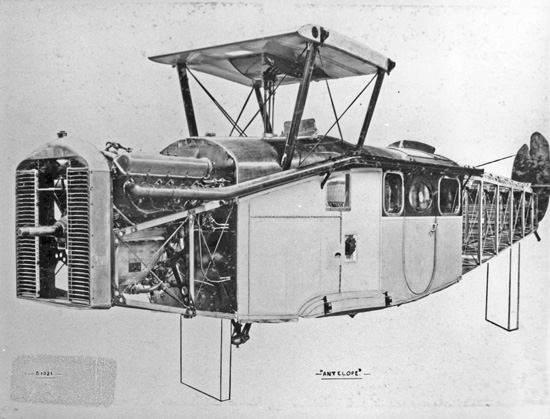
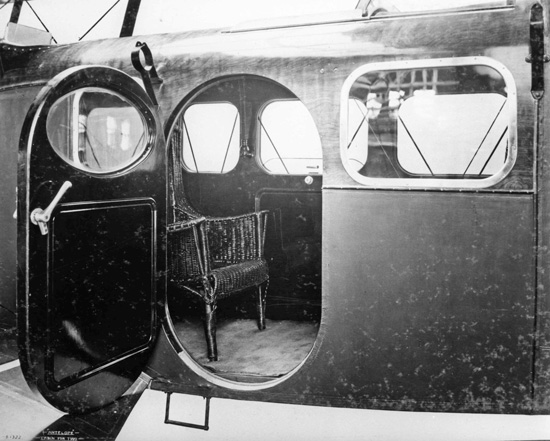
With all production military orders completed and work on the ‘Doves’ and ‘Gnus’ suspended pending customer orders, Sopwith aircraft work in December has been focussed on the ‘Antelope’ and completing stored Snail, Snapper and Cobham prototypes as ABC Dragonfly engines are finally being allocated to them.
Summary of 1919
The number of aircraft built by Sopwith in 1919 has amounted to 779 considerably fewer than the 1,373 in 1918 and slightly below the 850 in 1917. The total number of Sopwith aircraft built by other companies in the UK in 1919 is 2,152 compared with their peak wartime output of 5,931 in 1918.
At the end of 1919 over 25% of the RAF aircraft on charge are still their 4,089 Sopwith machines, with 1,630 ‘Snipe’ the second most numerous type after Avro 504s. Within the total are 394 ‘Ships Camels’, ‘Ships Strutters’ & ‘Cuckoos’ which make up 36% of all the “standard seaplanes & ship aeroplanes” operated for the Royal Navy.
The draft Sopwith financial accounts for the year to 30th September 1919 show a significant tailing-off in profitability in a year which started in all-out wartime production but within weeks changed to an uncertain future as orders for large numbers of aircraft were cancelled. Turnover at is surprisingly only 15% down on the previous financial year but profit appears to be down from 20% of turnover to 9% reflecting less efficient production and the very significant extra running costs of a full year in the Ham factory.
Since September 1919 with less than 60 aircraft delivered, no more military orders and unsold stocks of civil aircraft, the daily running costs of the whole organisation are rapidly eating into those reserve funds with a return to profitability seemingly entirely dependent upon building and selling many thousands of £110 ABC motorcycles.
Summary of Sopwith story to date.
Since its formation in 1912 Sopwith has built 3,686 aircraft and in total almost exactly 15,000 Sopwith aircraft have been built in Britain, all but 84 to wartime orders. This is over 20% of all the aircraft built for the British forces and over 60% of all the single-seaters.
If you add the 4,200 ‘Strutters’ built in France plus some built in Russia and 100 ‘Baby’ floatplanes built in Italy by Ansaldo then Sopwith aircraft are easily the most numerous British designs built so far.
Equally impressive is the number of aircraft types designed and built by Sopwith since 1912. 45 types represent a new type every 10 weeks. 21 types have gone into production for military service, 13 types have been sold profitably as prototypes for evaluation whilst 11 types have been built as private ventures.
Of the private venture designs Harry Hawker’s ‘Tabloid’ stunt-bus led to military orders for single-seat ‘Tabloids’, the ‘1914 Circuit of Britain floatplane’ directly spawned the ‘Folder floatplane’ and ‘Spinning Jenny’, the ‘Sigrist Bus’ influenced the design of the ‘Strutter’ and the ‘SLTBP’ runabout influenced the design of the ‘Pup’. Only the private venture ‘LRTTr’ triplane seems to have been a step too far although the recent private venture civil aircraft designs are yet to prove popular.
This concludes the diary of 1919
A similar diary page for 1920 can be found on this website under “Sopwith Day by Day”

